Toward Green Consumption: What Makes Us Care?
VerifiedAdded on 2023/05/30
|36
|13184
|420
AI Summary
This paper reviews the literature on green consumption behavior and the motivational approach towards green consumerism with a focus on the social environment and individual decision making using the theory of planned behavior TPB as theoretical background to predict and explain the green consumption behavior among consumers in the United Arab Emirates.
Contribute Materials
Your contribution can guide someone’s learning journey. Share your
documents today.
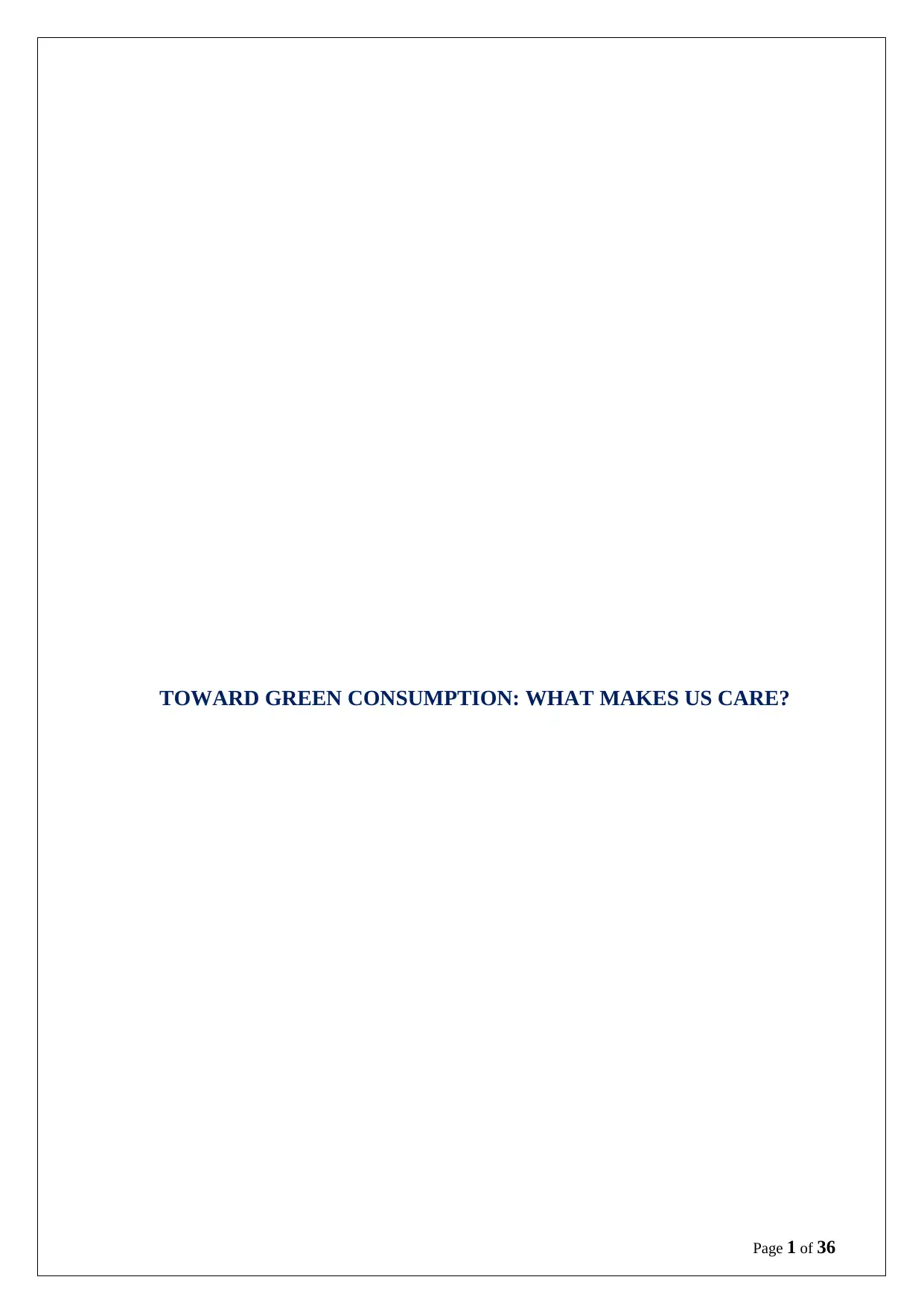
TOWARD GREEN CONSUMPTION: WHAT MAKES US CARE?
Page 1 of 36
Page 1 of 36
Secure Best Marks with AI Grader
Need help grading? Try our AI Grader for instant feedback on your assignments.
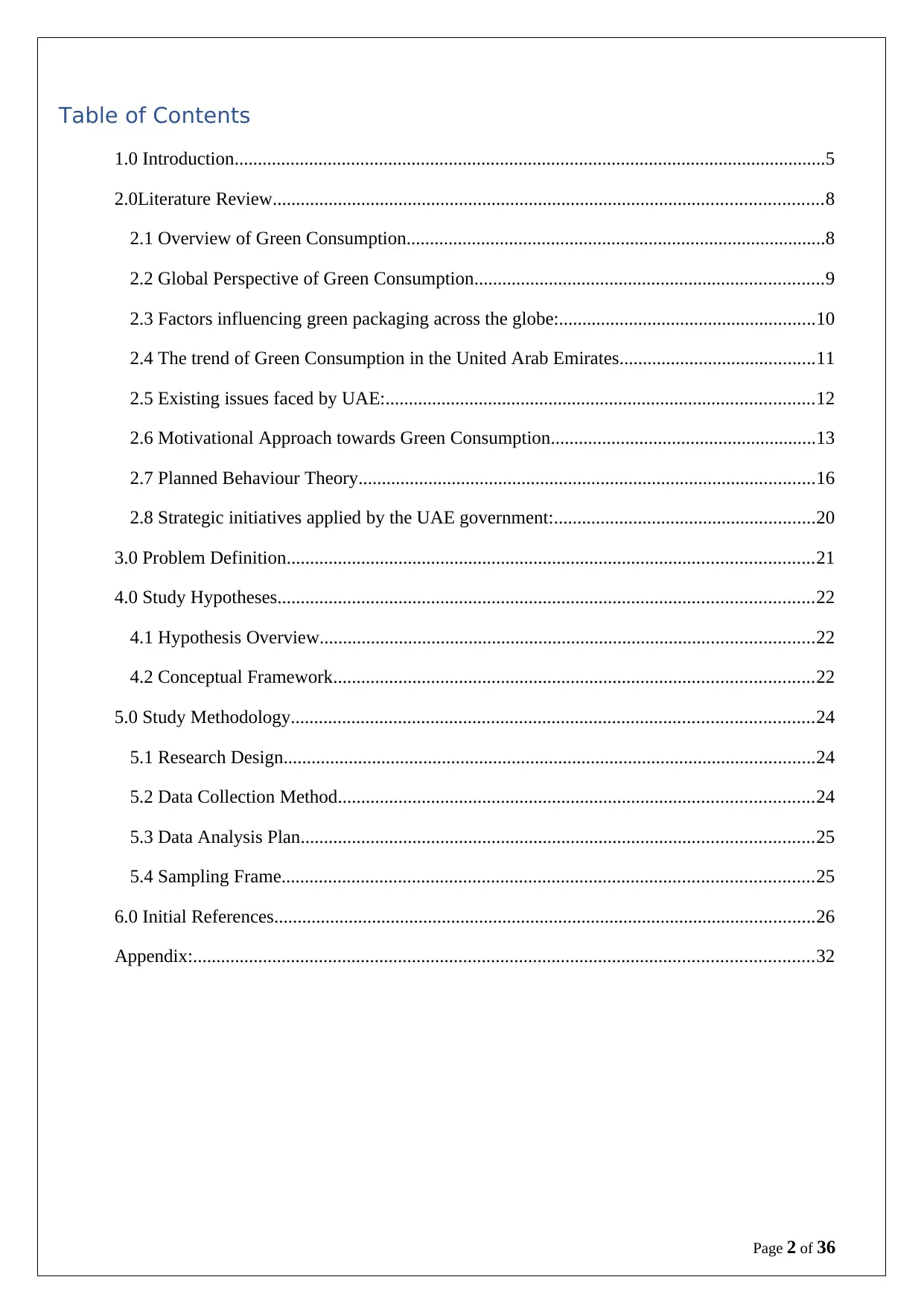
Table of Contents
1.0 Introduction...............................................................................................................................5
2.0Literature Review......................................................................................................................8
2.1 Overview of Green Consumption..........................................................................................8
2.2 Global Perspective of Green Consumption...........................................................................9
2.3 Factors influencing green packaging across the globe:.......................................................10
2.4 The trend of Green Consumption in the United Arab Emirates..........................................11
2.5 Existing issues faced by UAE:............................................................................................12
2.6 Motivational Approach towards Green Consumption.........................................................13
2.7 Planned Behaviour Theory..................................................................................................16
2.8 Strategic initiatives applied by the UAE government:........................................................20
3.0 Problem Definition.................................................................................................................21
4.0 Study Hypotheses...................................................................................................................22
4.1 Hypothesis Overview..........................................................................................................22
4.2 Conceptual Framework.......................................................................................................22
5.0 Study Methodology................................................................................................................24
5.1 Research Design..................................................................................................................24
5.2 Data Collection Method......................................................................................................24
5.3 Data Analysis Plan..............................................................................................................25
5.4 Sampling Frame..................................................................................................................25
6.0 Initial References....................................................................................................................26
Appendix:.....................................................................................................................................32
Page 2 of 36
1.0 Introduction...............................................................................................................................5
2.0Literature Review......................................................................................................................8
2.1 Overview of Green Consumption..........................................................................................8
2.2 Global Perspective of Green Consumption...........................................................................9
2.3 Factors influencing green packaging across the globe:.......................................................10
2.4 The trend of Green Consumption in the United Arab Emirates..........................................11
2.5 Existing issues faced by UAE:............................................................................................12
2.6 Motivational Approach towards Green Consumption.........................................................13
2.7 Planned Behaviour Theory..................................................................................................16
2.8 Strategic initiatives applied by the UAE government:........................................................20
3.0 Problem Definition.................................................................................................................21
4.0 Study Hypotheses...................................................................................................................22
4.1 Hypothesis Overview..........................................................................................................22
4.2 Conceptual Framework.......................................................................................................22
5.0 Study Methodology................................................................................................................24
5.1 Research Design..................................................................................................................24
5.2 Data Collection Method......................................................................................................24
5.3 Data Analysis Plan..............................................................................................................25
5.4 Sampling Frame..................................................................................................................25
6.0 Initial References....................................................................................................................26
Appendix:.....................................................................................................................................32
Page 2 of 36

1.0 Introduction
It is evident that the consumption rate of world’s resources is way out of the
recommended levels. Neither governments, organizations, nor citizens could igonre this reality.
Environmental concerns have pushed organizations and governments to shift their focus to use
biodegradable materials. Hamerman et al. (2017) note that climate change and other
sustainability issues of global interest has pushed global economies to come to an agreement
that there is need to contain the consumption levels that have negatively impacted the eco-
system. Individual need to be aware and pushed toward more responsible behvior or “
environmentally friendly” when it comes to consumption.
Green consumption is part of a sustainable consumer behavior. It represent the
consumer responsibility for resent environmental problems and taking the needs of their
descendants and next generation into consideration as well through the adoption of several
attitudes and behaviors such as: the consumption and use of organic products, clean and renue
and efficient use of energy, purchasing products of zero impact companies, recycling of
materials, protection of environment and preservation of species.The Green consumer behavior
also is known as the pro-environment behavior of people concerns with a kind of resource
utilization tendency, which would have little or no adverse impact on nature. Past studies have
suggested that the pro-environment behavior of consumers can have two spheres of construct
namely ‘Private-sphere’ and ‘Public-sphere’. The former refers to the purchasing, utilizing and
discarding of products for household and personal usage, impacting the environment(Axsen et
al. 2012). Whereas the latter corresponds to behaviors that can have direct effects on nature
manifesting through devoted environmental activism, restoration on nature by being a part of an
organization and influencing government policies through petitions on issues.
Green consumerism in the broader society can be established through individual actions
and change of perception. For this purpose, an individual must act ethically, not stimulated
solely on personal needs and preferences but, by preserving the well-being of the society and be
accountable for the environmental consequences as a result of the actions taken in everyday life.
Researchers even argue that the act of Green consumption does not limit only to the consume
organic food and choosing zero impact products, but extends to efficient energy utilization,
environment-friendly organic apparels, rejuvenating nature and spreading the awareness among
other members of the society too (Bailey & Caprotti, 2014).
Contrary to this aspect, surveys conducted in the European Union during 2013 have
shown that of the 80% of citizens that buy green products only 26% are regular buyers.
Page 3 of 36
It is evident that the consumption rate of world’s resources is way out of the
recommended levels. Neither governments, organizations, nor citizens could igonre this reality.
Environmental concerns have pushed organizations and governments to shift their focus to use
biodegradable materials. Hamerman et al. (2017) note that climate change and other
sustainability issues of global interest has pushed global economies to come to an agreement
that there is need to contain the consumption levels that have negatively impacted the eco-
system. Individual need to be aware and pushed toward more responsible behvior or “
environmentally friendly” when it comes to consumption.
Green consumption is part of a sustainable consumer behavior. It represent the
consumer responsibility for resent environmental problems and taking the needs of their
descendants and next generation into consideration as well through the adoption of several
attitudes and behaviors such as: the consumption and use of organic products, clean and renue
and efficient use of energy, purchasing products of zero impact companies, recycling of
materials, protection of environment and preservation of species.The Green consumer behavior
also is known as the pro-environment behavior of people concerns with a kind of resource
utilization tendency, which would have little or no adverse impact on nature. Past studies have
suggested that the pro-environment behavior of consumers can have two spheres of construct
namely ‘Private-sphere’ and ‘Public-sphere’. The former refers to the purchasing, utilizing and
discarding of products for household and personal usage, impacting the environment(Axsen et
al. 2012). Whereas the latter corresponds to behaviors that can have direct effects on nature
manifesting through devoted environmental activism, restoration on nature by being a part of an
organization and influencing government policies through petitions on issues.
Green consumerism in the broader society can be established through individual actions
and change of perception. For this purpose, an individual must act ethically, not stimulated
solely on personal needs and preferences but, by preserving the well-being of the society and be
accountable for the environmental consequences as a result of the actions taken in everyday life.
Researchers even argue that the act of Green consumption does not limit only to the consume
organic food and choosing zero impact products, but extends to efficient energy utilization,
environment-friendly organic apparels, rejuvenating nature and spreading the awareness among
other members of the society too (Bailey & Caprotti, 2014).
Contrary to this aspect, surveys conducted in the European Union during 2013 have
shown that of the 80% of citizens that buy green products only 26% are regular buyers.
Page 3 of 36
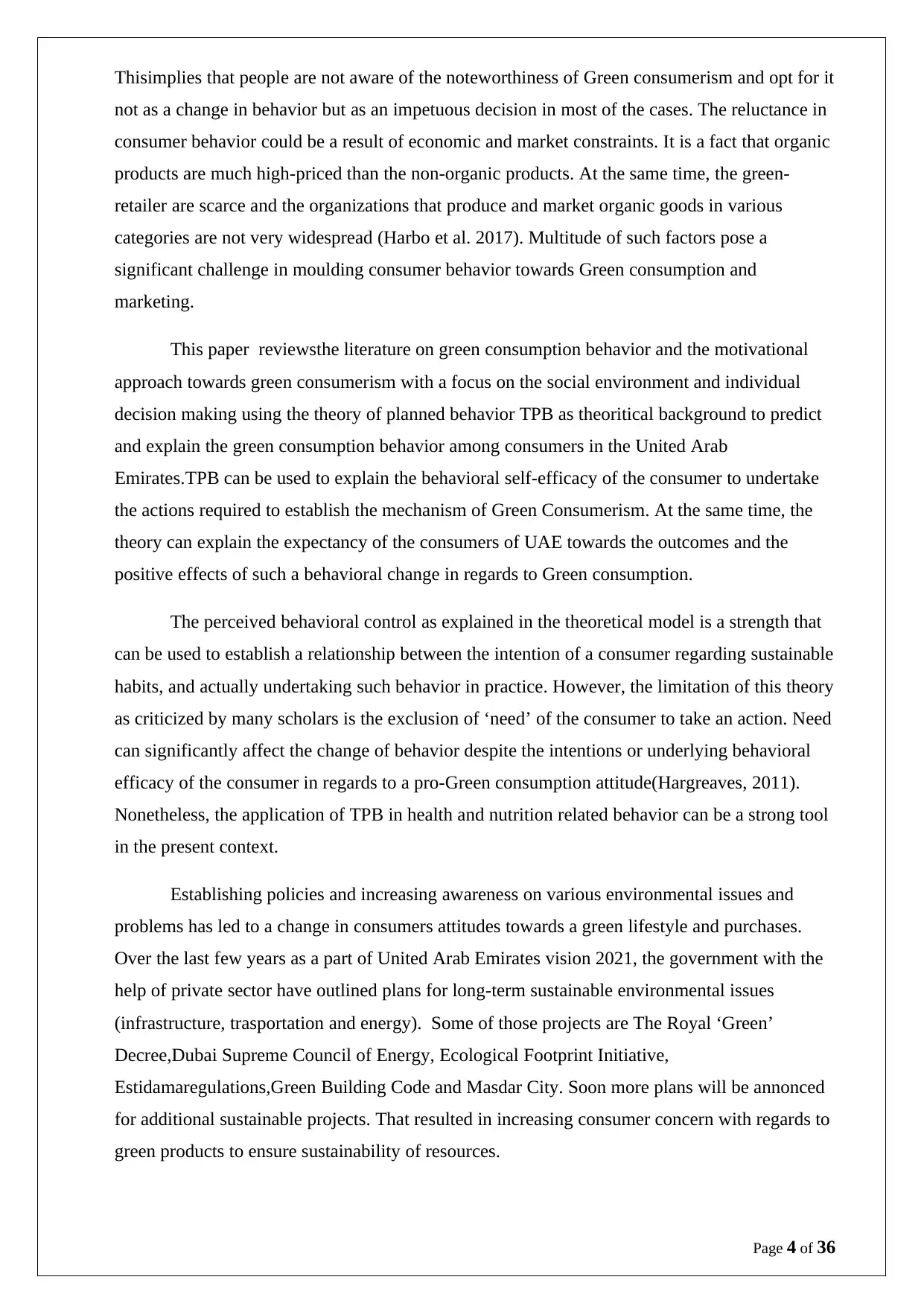
Thisimplies that people are not aware of the noteworthiness of Green consumerism and opt for it
not as a change in behavior but as an impetuous decision in most of the cases. The reluctance in
consumer behavior could be a result of economic and market constraints. It is a fact that organic
products are much high-priced than the non-organic products. At the same time, the green-
retailer are scarce and the organizations that produce and market organic goods in various
categories are not very widespread (Harbo et al. 2017). Multitude of such factors pose a
significant challenge in moulding consumer behavior towards Green consumption and
marketing.
This paper reviewsthe literature on green consumption behavior and the motivational
approach towards green consumerism with a focus on the social environment and individual
decision making using the theory of planned behavior TPB as theoritical background to predict
and explain the green consumption behavior among consumers in the United Arab
Emirates.TPB can be used to explain the behavioral self-efficacy of the consumer to undertake
the actions required to establish the mechanism of Green Consumerism. At the same time, the
theory can explain the expectancy of the consumers of UAE towards the outcomes and the
positive effects of such a behavioral change in regards to Green consumption.
The perceived behavioral control as explained in the theoretical model is a strength that
can be used to establish a relationship between the intention of a consumer regarding sustainable
habits, and actually undertaking such behavior in practice. However, the limitation of this theory
as criticized by many scholars is the exclusion of ‘need’ of the consumer to take an action. Need
can significantly affect the change of behavior despite the intentions or underlying behavioral
efficacy of the consumer in regards to a pro-Green consumption attitude(Hargreaves, 2011).
Nonetheless, the application of TPB in health and nutrition related behavior can be a strong tool
in the present context.
Establishing policies and increasing awareness on various environmental issues and
problems has led to a change in consumers attitudes towards a green lifestyle and purchases.
Over the last few years as a part of United Arab Emirates vision 2021, the government with the
help of private sector have outlined plans for long-term sustainable environmental issues
(infrastructure, trasportation and energy). Some of those projects are The Royal ‘Green’
Decree,Dubai Supreme Council of Energy, Ecological Footprint Initiative,
Estidamaregulations,Green Building Code and Masdar City. Soon more plans will be annonced
for additional sustainable projects. That resulted in increasing consumer concern with regards to
green products to ensure sustainability of resources.
Page 4 of 36
not as a change in behavior but as an impetuous decision in most of the cases. The reluctance in
consumer behavior could be a result of economic and market constraints. It is a fact that organic
products are much high-priced than the non-organic products. At the same time, the green-
retailer are scarce and the organizations that produce and market organic goods in various
categories are not very widespread (Harbo et al. 2017). Multitude of such factors pose a
significant challenge in moulding consumer behavior towards Green consumption and
marketing.
This paper reviewsthe literature on green consumption behavior and the motivational
approach towards green consumerism with a focus on the social environment and individual
decision making using the theory of planned behavior TPB as theoritical background to predict
and explain the green consumption behavior among consumers in the United Arab
Emirates.TPB can be used to explain the behavioral self-efficacy of the consumer to undertake
the actions required to establish the mechanism of Green Consumerism. At the same time, the
theory can explain the expectancy of the consumers of UAE towards the outcomes and the
positive effects of such a behavioral change in regards to Green consumption.
The perceived behavioral control as explained in the theoretical model is a strength that
can be used to establish a relationship between the intention of a consumer regarding sustainable
habits, and actually undertaking such behavior in practice. However, the limitation of this theory
as criticized by many scholars is the exclusion of ‘need’ of the consumer to take an action. Need
can significantly affect the change of behavior despite the intentions or underlying behavioral
efficacy of the consumer in regards to a pro-Green consumption attitude(Hargreaves, 2011).
Nonetheless, the application of TPB in health and nutrition related behavior can be a strong tool
in the present context.
Establishing policies and increasing awareness on various environmental issues and
problems has led to a change in consumers attitudes towards a green lifestyle and purchases.
Over the last few years as a part of United Arab Emirates vision 2021, the government with the
help of private sector have outlined plans for long-term sustainable environmental issues
(infrastructure, trasportation and energy). Some of those projects are The Royal ‘Green’
Decree,Dubai Supreme Council of Energy, Ecological Footprint Initiative,
Estidamaregulations,Green Building Code and Masdar City. Soon more plans will be annonced
for additional sustainable projects. That resulted in increasing consumer concern with regards to
green products to ensure sustainability of resources.
Page 4 of 36
Secure Best Marks with AI Grader
Need help grading? Try our AI Grader for instant feedback on your assignments.
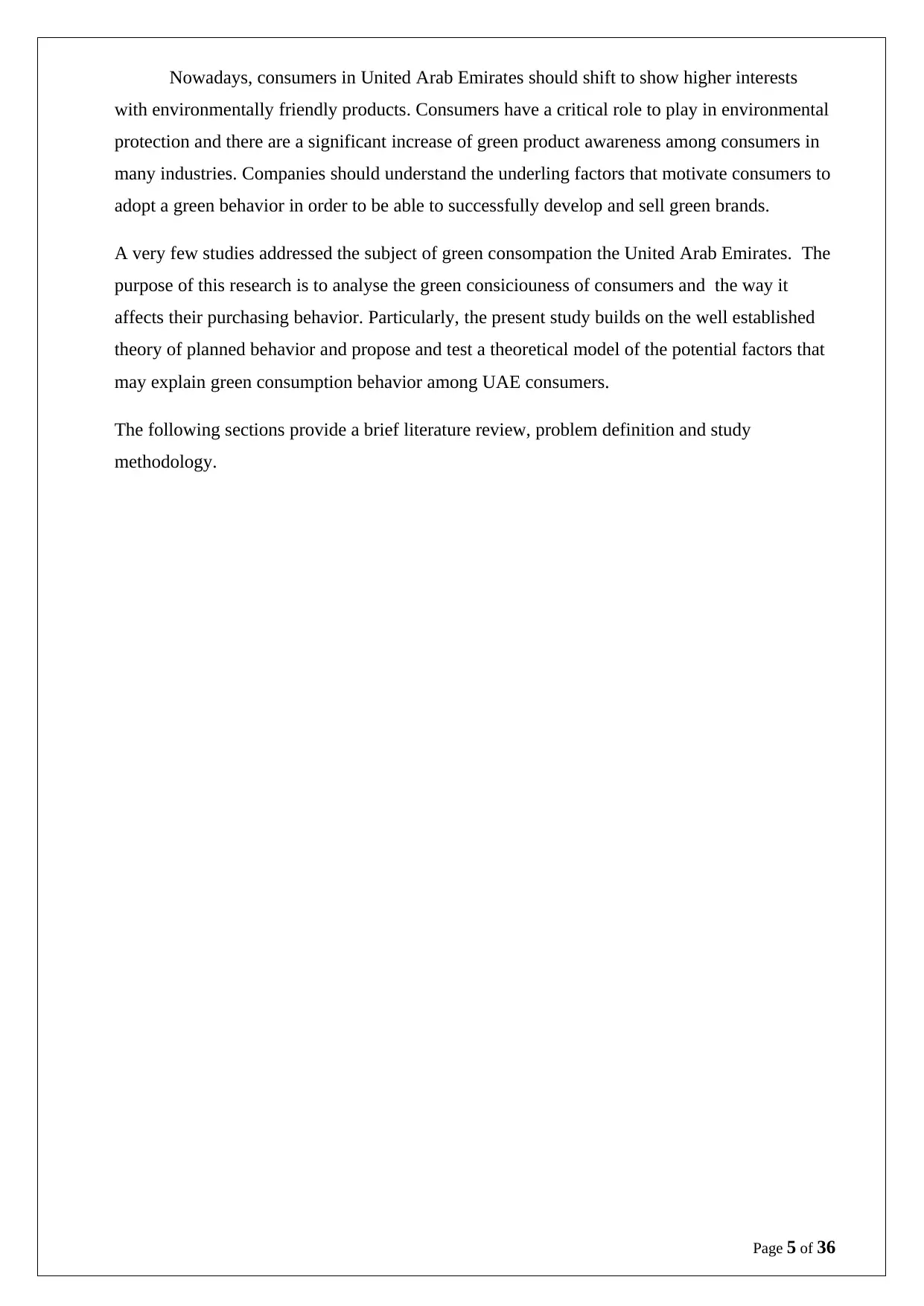
Nowadays, consumers in United Arab Emirates should shift to show higher interests
with environmentally friendly products. Consumers have a critical role to play in environmental
protection and there are a significant increase of green product awareness among consumers in
many industries. Companies should understand the underling factors that motivate consumers to
adopt a green behavior in order to be able to successfully develop and sell green brands.
A very few studies addressed the subject of green consompation the United Arab Emirates. The
purpose of this research is to analyse the green consiciouness of consumers and the way it
affects their purchasing behavior. Particularly, the present study builds on the well established
theory of planned behavior and propose and test a theoretical model of the potential factors that
may explain green consumption behavior among UAE consumers.
The following sections provide a brief literature review, problem definition and study
methodology.
Page 5 of 36
with environmentally friendly products. Consumers have a critical role to play in environmental
protection and there are a significant increase of green product awareness among consumers in
many industries. Companies should understand the underling factors that motivate consumers to
adopt a green behavior in order to be able to successfully develop and sell green brands.
A very few studies addressed the subject of green consompation the United Arab Emirates. The
purpose of this research is to analyse the green consiciouness of consumers and the way it
affects their purchasing behavior. Particularly, the present study builds on the well established
theory of planned behavior and propose and test a theoretical model of the potential factors that
may explain green consumption behavior among UAE consumers.
The following sections provide a brief literature review, problem definition and study
methodology.
Page 5 of 36
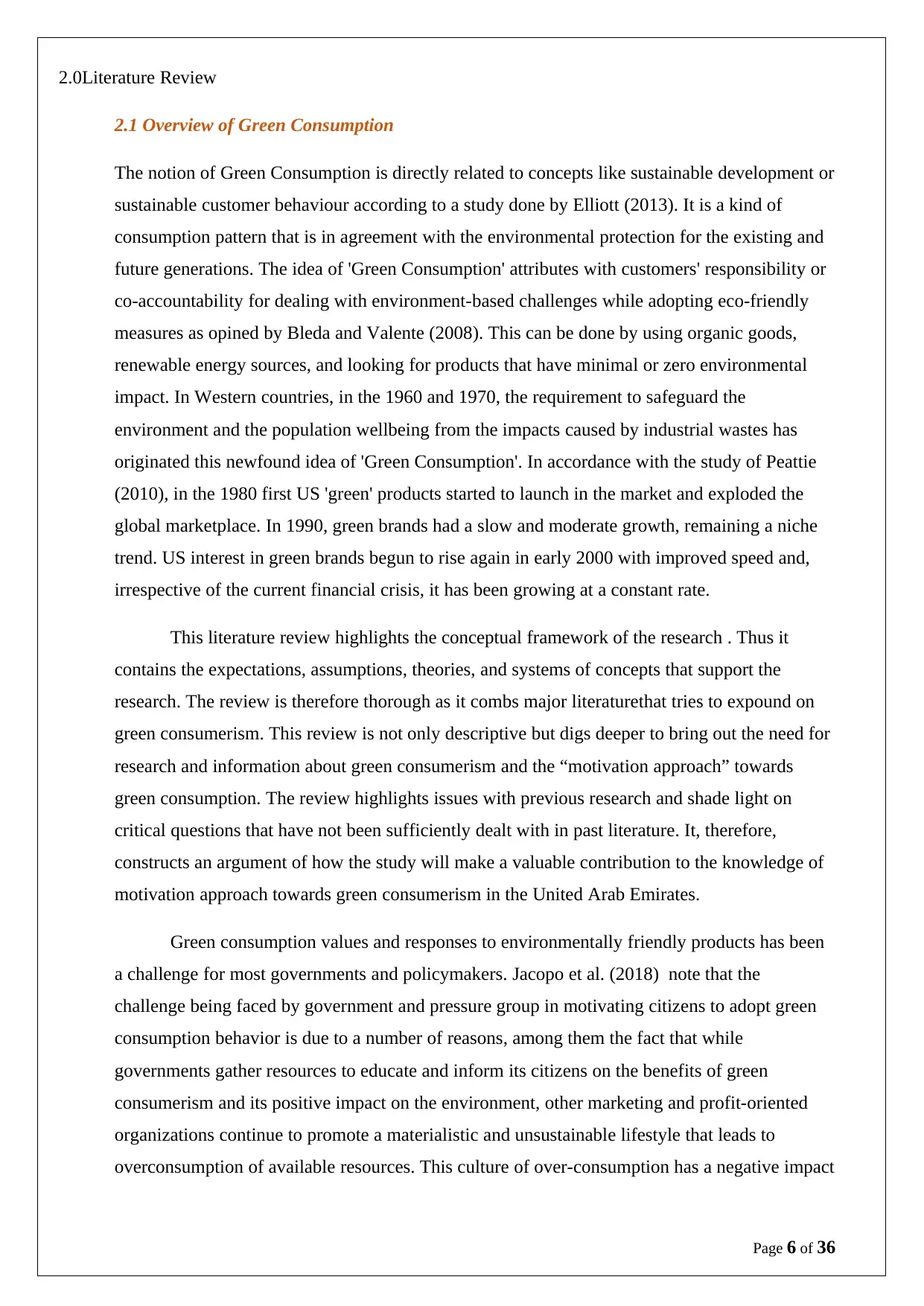
2.0Literature Review
2.1 Overview of Green Consumption
The notion of Green Consumption is directly related to concepts like sustainable development or
sustainable customer behaviour according to a study done by Elliott (2013). It is a kind of
consumption pattern that is in agreement with the environmental protection for the existing and
future generations. The idea of 'Green Consumption' attributes with customers' responsibility or
co-accountability for dealing with environment-based challenges while adopting eco-friendly
measures as opined by Bleda and Valente (2008). This can be done by using organic goods,
renewable energy sources, and looking for products that have minimal or zero environmental
impact. In Western countries, in the 1960 and 1970, the requirement to safeguard the
environment and the population wellbeing from the impacts caused by industrial wastes has
originated this newfound idea of 'Green Consumption'. In accordance with the study of Peattie
(2010), in the 1980 first US 'green' products started to launch in the market and exploded the
global marketplace. In 1990, green brands had a slow and moderate growth, remaining a niche
trend. US interest in green brands begun to rise again in early 2000 with improved speed and,
irrespective of the current financial crisis, it has been growing at a constant rate.
This literature review highlights the conceptual framework of the research . Thus it
contains the expectations, assumptions, theories, and systems of concepts that support the
research. The review is therefore thorough as it combs major literaturethat tries to expound on
green consumerism. This review is not only descriptive but digs deeper to bring out the need for
research and information about green consumerism and the “motivation approach” towards
green consumption. The review highlights issues with previous research and shade light on
critical questions that have not been sufficiently dealt with in past literature. It, therefore,
constructs an argument of how the study will make a valuable contribution to the knowledge of
motivation approach towards green consumerism in the United Arab Emirates.
Green consumption values and responses to environmentally friendly products has been
a challenge for most governments and policymakers. Jacopo et al. (2018) note that the
challenge being faced by government and pressure group in motivating citizens to adopt green
consumption behavior is due to a number of reasons, among them the fact that while
governments gather resources to educate and inform its citizens on the benefits of green
consumerism and its positive impact on the environment, other marketing and profit-oriented
organizations continue to promote a materialistic and unsustainable lifestyle that leads to
overconsumption of available resources. This culture of over-consumption has a negative impact
Page 6 of 36
2.1 Overview of Green Consumption
The notion of Green Consumption is directly related to concepts like sustainable development or
sustainable customer behaviour according to a study done by Elliott (2013). It is a kind of
consumption pattern that is in agreement with the environmental protection for the existing and
future generations. The idea of 'Green Consumption' attributes with customers' responsibility or
co-accountability for dealing with environment-based challenges while adopting eco-friendly
measures as opined by Bleda and Valente (2008). This can be done by using organic goods,
renewable energy sources, and looking for products that have minimal or zero environmental
impact. In Western countries, in the 1960 and 1970, the requirement to safeguard the
environment and the population wellbeing from the impacts caused by industrial wastes has
originated this newfound idea of 'Green Consumption'. In accordance with the study of Peattie
(2010), in the 1980 first US 'green' products started to launch in the market and exploded the
global marketplace. In 1990, green brands had a slow and moderate growth, remaining a niche
trend. US interest in green brands begun to rise again in early 2000 with improved speed and,
irrespective of the current financial crisis, it has been growing at a constant rate.
This literature review highlights the conceptual framework of the research . Thus it
contains the expectations, assumptions, theories, and systems of concepts that support the
research. The review is therefore thorough as it combs major literaturethat tries to expound on
green consumerism. This review is not only descriptive but digs deeper to bring out the need for
research and information about green consumerism and the “motivation approach” towards
green consumption. The review highlights issues with previous research and shade light on
critical questions that have not been sufficiently dealt with in past literature. It, therefore,
constructs an argument of how the study will make a valuable contribution to the knowledge of
motivation approach towards green consumerism in the United Arab Emirates.
Green consumption values and responses to environmentally friendly products has been
a challenge for most governments and policymakers. Jacopo et al. (2018) note that the
challenge being faced by government and pressure group in motivating citizens to adopt green
consumption behavior is due to a number of reasons, among them the fact that while
governments gather resources to educate and inform its citizens on the benefits of green
consumerism and its positive impact on the environment, other marketing and profit-oriented
organizations continue to promote a materialistic and unsustainable lifestyle that leads to
overconsumption of available resources. This culture of over-consumption has a negative impact
Page 6 of 36
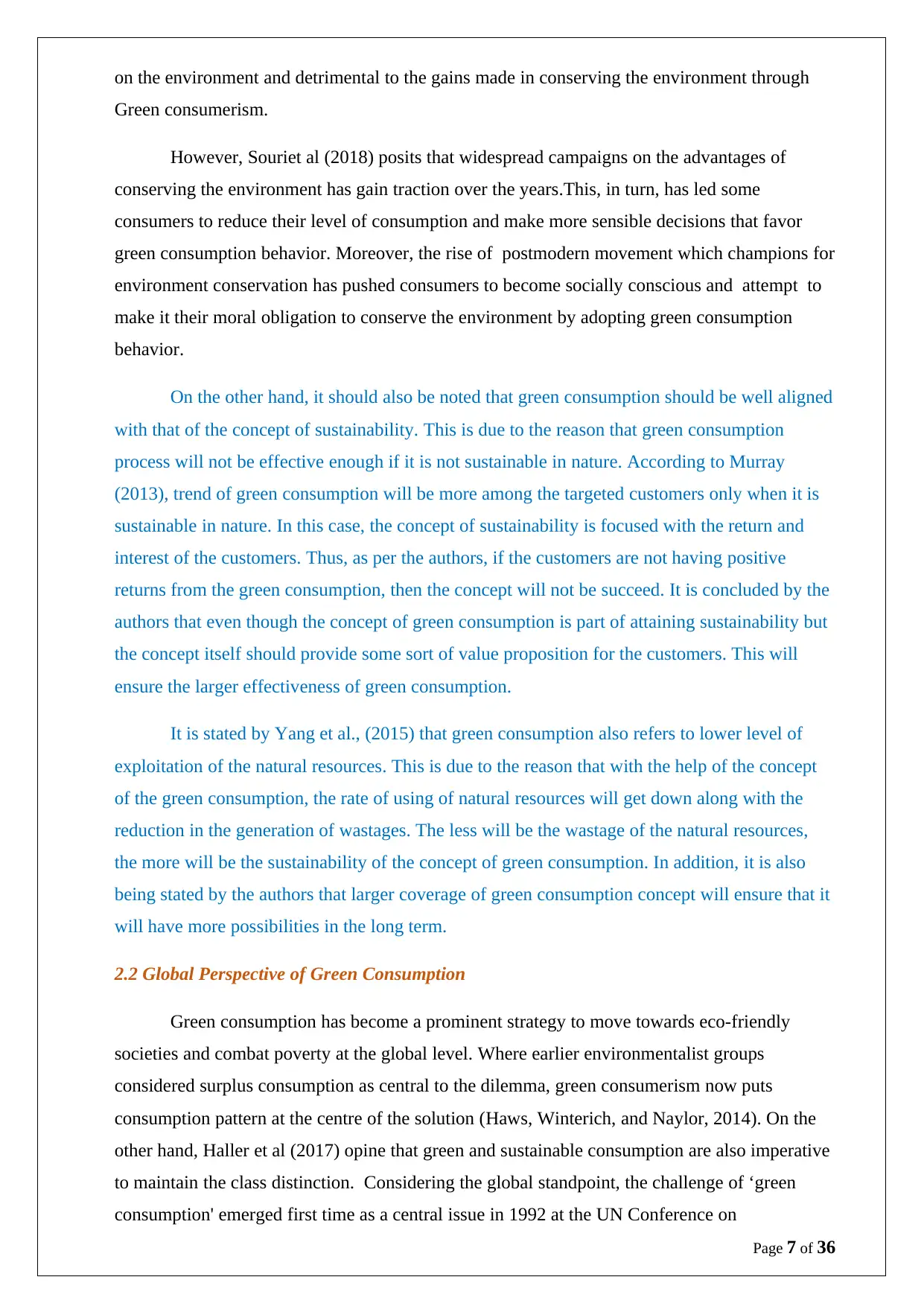
on the environment and detrimental to the gains made in conserving the environment through
Green consumerism.
However, Souriet al (2018) posits that widespread campaigns on the advantages of
conserving the environment has gain traction over the years.This, in turn, has led some
consumers to reduce their level of consumption and make more sensible decisions that favor
green consumption behavior. Moreover, the rise of postmodern movement which champions for
environment conservation has pushed consumers to become socially conscious and attempt to
make it their moral obligation to conserve the environment by adopting green consumption
behavior.
On the other hand, it should also be noted that green consumption should be well aligned
with that of the concept of sustainability. This is due to the reason that green consumption
process will not be effective enough if it is not sustainable in nature. According to Murray
(2013), trend of green consumption will be more among the targeted customers only when it is
sustainable in nature. In this case, the concept of sustainability is focused with the return and
interest of the customers. Thus, as per the authors, if the customers are not having positive
returns from the green consumption, then the concept will not be succeed. It is concluded by the
authors that even though the concept of green consumption is part of attaining sustainability but
the concept itself should provide some sort of value proposition for the customers. This will
ensure the larger effectiveness of green consumption.
It is stated by Yang et al., (2015) that green consumption also refers to lower level of
exploitation of the natural resources. This is due to the reason that with the help of the concept
of the green consumption, the rate of using of natural resources will get down along with the
reduction in the generation of wastages. The less will be the wastage of the natural resources,
the more will be the sustainability of the concept of green consumption. In addition, it is also
being stated by the authors that larger coverage of green consumption concept will ensure that it
will have more possibilities in the long term.
2.2 Global Perspective of Green Consumption
Green consumption has become a prominent strategy to move towards eco-friendly
societies and combat poverty at the global level. Where earlier environmentalist groups
considered surplus consumption as central to the dilemma, green consumerism now puts
consumption pattern at the centre of the solution (Haws, Winterich, and Naylor, 2014). On the
other hand, Haller et al (2017) opine that green and sustainable consumption are also imperative
to maintain the class distinction. Considering the global standpoint, the challenge of ‘green
consumption' emerged first time as a central issue in 1992 at the UN Conference on
Page 7 of 36
Green consumerism.
However, Souriet al (2018) posits that widespread campaigns on the advantages of
conserving the environment has gain traction over the years.This, in turn, has led some
consumers to reduce their level of consumption and make more sensible decisions that favor
green consumption behavior. Moreover, the rise of postmodern movement which champions for
environment conservation has pushed consumers to become socially conscious and attempt to
make it their moral obligation to conserve the environment by adopting green consumption
behavior.
On the other hand, it should also be noted that green consumption should be well aligned
with that of the concept of sustainability. This is due to the reason that green consumption
process will not be effective enough if it is not sustainable in nature. According to Murray
(2013), trend of green consumption will be more among the targeted customers only when it is
sustainable in nature. In this case, the concept of sustainability is focused with the return and
interest of the customers. Thus, as per the authors, if the customers are not having positive
returns from the green consumption, then the concept will not be succeed. It is concluded by the
authors that even though the concept of green consumption is part of attaining sustainability but
the concept itself should provide some sort of value proposition for the customers. This will
ensure the larger effectiveness of green consumption.
It is stated by Yang et al., (2015) that green consumption also refers to lower level of
exploitation of the natural resources. This is due to the reason that with the help of the concept
of the green consumption, the rate of using of natural resources will get down along with the
reduction in the generation of wastages. The less will be the wastage of the natural resources,
the more will be the sustainability of the concept of green consumption. In addition, it is also
being stated by the authors that larger coverage of green consumption concept will ensure that it
will have more possibilities in the long term.
2.2 Global Perspective of Green Consumption
Green consumption has become a prominent strategy to move towards eco-friendly
societies and combat poverty at the global level. Where earlier environmentalist groups
considered surplus consumption as central to the dilemma, green consumerism now puts
consumption pattern at the centre of the solution (Haws, Winterich, and Naylor, 2014). On the
other hand, Haller et al (2017) opine that green and sustainable consumption are also imperative
to maintain the class distinction. Considering the global standpoint, the challenge of ‘green
consumption' emerged first time as a central issue in 1992 at the UN Conference on
Page 7 of 36
Paraphrase This Document
Need a fresh take? Get an instant paraphrase of this document with our AI Paraphraser
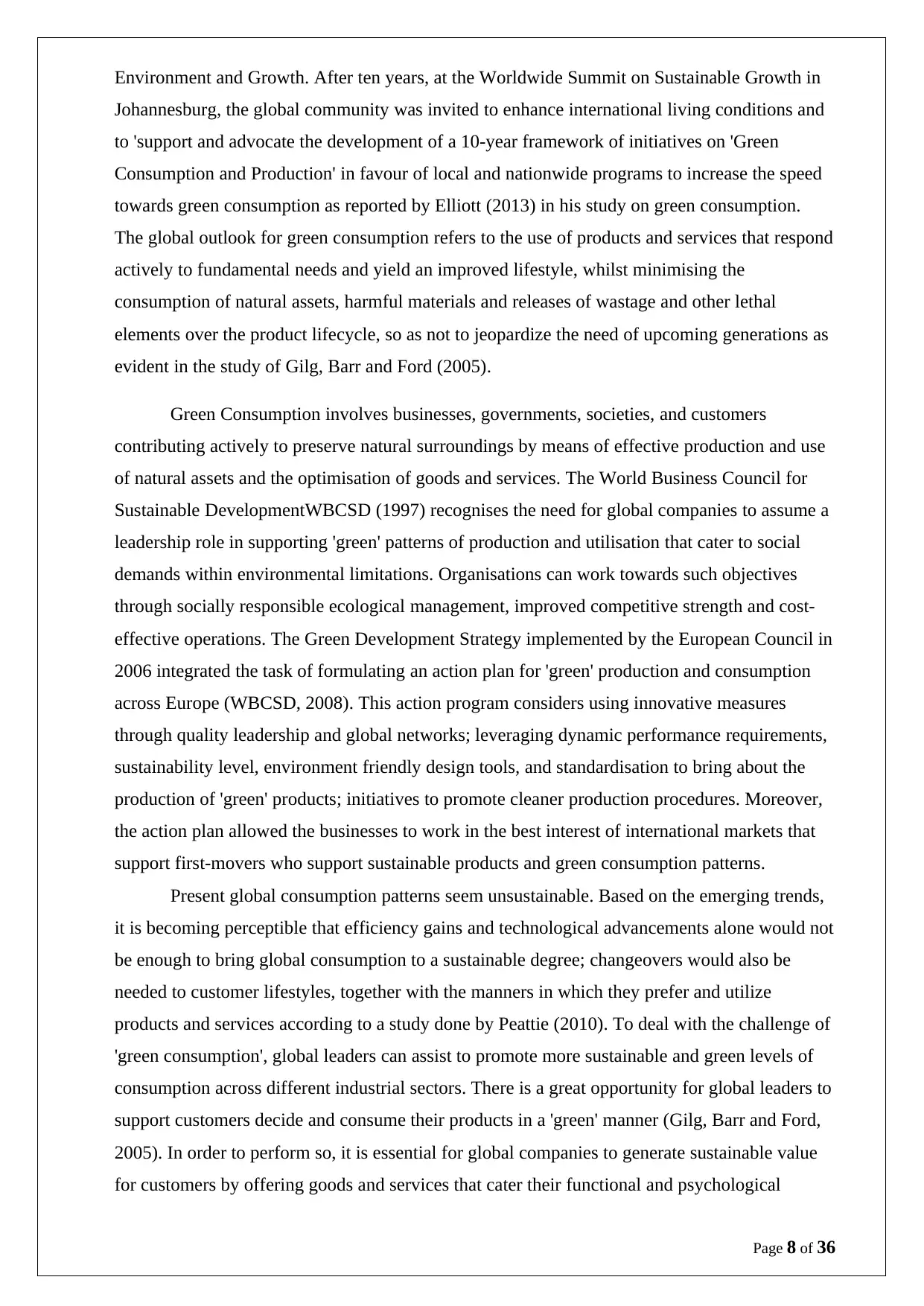
Environment and Growth. After ten years, at the Worldwide Summit on Sustainable Growth in
Johannesburg, the global community was invited to enhance international living conditions and
to 'support and advocate the development of a 10-year framework of initiatives on 'Green
Consumption and Production' in favour of local and nationwide programs to increase the speed
towards green consumption as reported by Elliott (2013) in his study on green consumption.
The global outlook for green consumption refers to the use of products and services that respond
actively to fundamental needs and yield an improved lifestyle, whilst minimising the
consumption of natural assets, harmful materials and releases of wastage and other lethal
elements over the product lifecycle, so as not to jeopardize the need of upcoming generations as
evident in the study of Gilg, Barr and Ford (2005).
Green Consumption involves businesses, governments, societies, and customers
contributing actively to preserve natural surroundings by means of effective production and use
of natural assets and the optimisation of goods and services. The World Business Council for
Sustainable DevelopmentWBCSD (1997) recognises the need for global companies to assume a
leadership role in supporting 'green' patterns of production and utilisation that cater to social
demands within environmental limitations. Organisations can work towards such objectives
through socially responsible ecological management, improved competitive strength and cost-
effective operations. The Green Development Strategy implemented by the European Council in
2006 integrated the task of formulating an action plan for 'green' production and consumption
across Europe (WBCSD, 2008). This action program considers using innovative measures
through quality leadership and global networks; leveraging dynamic performance requirements,
sustainability level, environment friendly design tools, and standardisation to bring about the
production of 'green' products; initiatives to promote cleaner production procedures. Moreover,
the action plan allowed the businesses to work in the best interest of international markets that
support first-movers who support sustainable products and green consumption patterns.
Present global consumption patterns seem unsustainable. Based on the emerging trends,
it is becoming perceptible that efficiency gains and technological advancements alone would not
be enough to bring global consumption to a sustainable degree; changeovers would also be
needed to customer lifestyles, together with the manners in which they prefer and utilize
products and services according to a study done by Peattie (2010). To deal with the challenge of
'green consumption', global leaders can assist to promote more sustainable and green levels of
consumption across different industrial sectors. There is a great opportunity for global leaders to
support customers decide and consume their products in a 'green' manner (Gilg, Barr and Ford,
2005). In order to perform so, it is essential for global companies to generate sustainable value
for customers by offering goods and services that cater their functional and psychological
Page 8 of 36
Johannesburg, the global community was invited to enhance international living conditions and
to 'support and advocate the development of a 10-year framework of initiatives on 'Green
Consumption and Production' in favour of local and nationwide programs to increase the speed
towards green consumption as reported by Elliott (2013) in his study on green consumption.
The global outlook for green consumption refers to the use of products and services that respond
actively to fundamental needs and yield an improved lifestyle, whilst minimising the
consumption of natural assets, harmful materials and releases of wastage and other lethal
elements over the product lifecycle, so as not to jeopardize the need of upcoming generations as
evident in the study of Gilg, Barr and Ford (2005).
Green Consumption involves businesses, governments, societies, and customers
contributing actively to preserve natural surroundings by means of effective production and use
of natural assets and the optimisation of goods and services. The World Business Council for
Sustainable DevelopmentWBCSD (1997) recognises the need for global companies to assume a
leadership role in supporting 'green' patterns of production and utilisation that cater to social
demands within environmental limitations. Organisations can work towards such objectives
through socially responsible ecological management, improved competitive strength and cost-
effective operations. The Green Development Strategy implemented by the European Council in
2006 integrated the task of formulating an action plan for 'green' production and consumption
across Europe (WBCSD, 2008). This action program considers using innovative measures
through quality leadership and global networks; leveraging dynamic performance requirements,
sustainability level, environment friendly design tools, and standardisation to bring about the
production of 'green' products; initiatives to promote cleaner production procedures. Moreover,
the action plan allowed the businesses to work in the best interest of international markets that
support first-movers who support sustainable products and green consumption patterns.
Present global consumption patterns seem unsustainable. Based on the emerging trends,
it is becoming perceptible that efficiency gains and technological advancements alone would not
be enough to bring global consumption to a sustainable degree; changeovers would also be
needed to customer lifestyles, together with the manners in which they prefer and utilize
products and services according to a study done by Peattie (2010). To deal with the challenge of
'green consumption', global leaders can assist to promote more sustainable and green levels of
consumption across different industrial sectors. There is a great opportunity for global leaders to
support customers decide and consume their products in a 'green' manner (Gilg, Barr and Ford,
2005). In order to perform so, it is essential for global companies to generate sustainable value
for customers by offering goods and services that cater their functional and psychological
Page 8 of 36
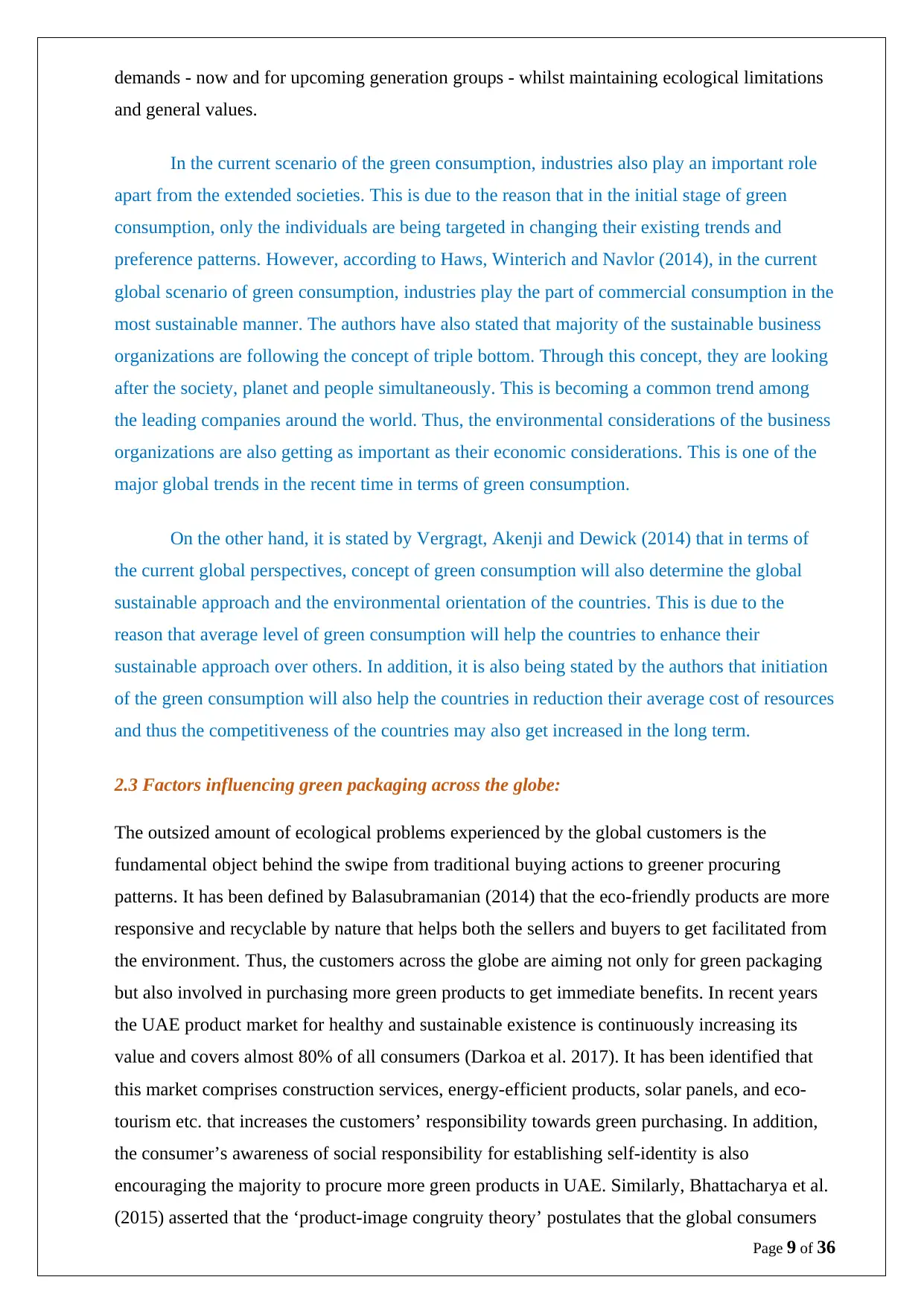
demands - now and for upcoming generation groups - whilst maintaining ecological limitations
and general values.
In the current scenario of the green consumption, industries also play an important role
apart from the extended societies. This is due to the reason that in the initial stage of green
consumption, only the individuals are being targeted in changing their existing trends and
preference patterns. However, according to Haws, Winterich and Navlor (2014), in the current
global scenario of green consumption, industries play the part of commercial consumption in the
most sustainable manner. The authors have also stated that majority of the sustainable business
organizations are following the concept of triple bottom. Through this concept, they are looking
after the society, planet and people simultaneously. This is becoming a common trend among
the leading companies around the world. Thus, the environmental considerations of the business
organizations are also getting as important as their economic considerations. This is one of the
major global trends in the recent time in terms of green consumption.
On the other hand, it is stated by Vergragt, Akenji and Dewick (2014) that in terms of
the current global perspectives, concept of green consumption will also determine the global
sustainable approach and the environmental orientation of the countries. This is due to the
reason that average level of green consumption will help the countries to enhance their
sustainable approach over others. In addition, it is also being stated by the authors that initiation
of the green consumption will also help the countries in reduction their average cost of resources
and thus the competitiveness of the countries may also get increased in the long term.
2.3 Factors influencing green packaging across the globe:
The outsized amount of ecological problems experienced by the global customers is the
fundamental object behind the swipe from traditional buying actions to greener procuring
patterns. It has been defined by Balasubramanian (2014) that the eco-friendly products are more
responsive and recyclable by nature that helps both the sellers and buyers to get facilitated from
the environment. Thus, the customers across the globe are aiming not only for green packaging
but also involved in purchasing more green products to get immediate benefits. In recent years
the UAE product market for healthy and sustainable existence is continuously increasing its
value and covers almost 80% of all consumers (Darkoa et al. 2017). It has been identified that
this market comprises construction services, energy-efficient products, solar panels, and eco-
tourism etc. that increases the customers’ responsibility towards green purchasing. In addition,
the consumer’s awareness of social responsibility for establishing self-identity is also
encouraging the majority to procure more green products in UAE. Similarly, Bhattacharya et al.
(2015) asserted that the ‘product-image congruity theory’ postulates that the global consumers
Page 9 of 36
and general values.
In the current scenario of the green consumption, industries also play an important role
apart from the extended societies. This is due to the reason that in the initial stage of green
consumption, only the individuals are being targeted in changing their existing trends and
preference patterns. However, according to Haws, Winterich and Navlor (2014), in the current
global scenario of green consumption, industries play the part of commercial consumption in the
most sustainable manner. The authors have also stated that majority of the sustainable business
organizations are following the concept of triple bottom. Through this concept, they are looking
after the society, planet and people simultaneously. This is becoming a common trend among
the leading companies around the world. Thus, the environmental considerations of the business
organizations are also getting as important as their economic considerations. This is one of the
major global trends in the recent time in terms of green consumption.
On the other hand, it is stated by Vergragt, Akenji and Dewick (2014) that in terms of
the current global perspectives, concept of green consumption will also determine the global
sustainable approach and the environmental orientation of the countries. This is due to the
reason that average level of green consumption will help the countries to enhance their
sustainable approach over others. In addition, it is also being stated by the authors that initiation
of the green consumption will also help the countries in reduction their average cost of resources
and thus the competitiveness of the countries may also get increased in the long term.
2.3 Factors influencing green packaging across the globe:
The outsized amount of ecological problems experienced by the global customers is the
fundamental object behind the swipe from traditional buying actions to greener procuring
patterns. It has been defined by Balasubramanian (2014) that the eco-friendly products are more
responsive and recyclable by nature that helps both the sellers and buyers to get facilitated from
the environment. Thus, the customers across the globe are aiming not only for green packaging
but also involved in purchasing more green products to get immediate benefits. In recent years
the UAE product market for healthy and sustainable existence is continuously increasing its
value and covers almost 80% of all consumers (Darkoa et al. 2017). It has been identified that
this market comprises construction services, energy-efficient products, solar panels, and eco-
tourism etc. that increases the customers’ responsibility towards green purchasing. In addition,
the consumer’s awareness of social responsibility for establishing self-identity is also
encouraging the majority to procure more green products in UAE. Similarly, Bhattacharya et al.
(2015) asserted that the ‘product-image congruity theory’ postulates that the global consumers
Page 9 of 36
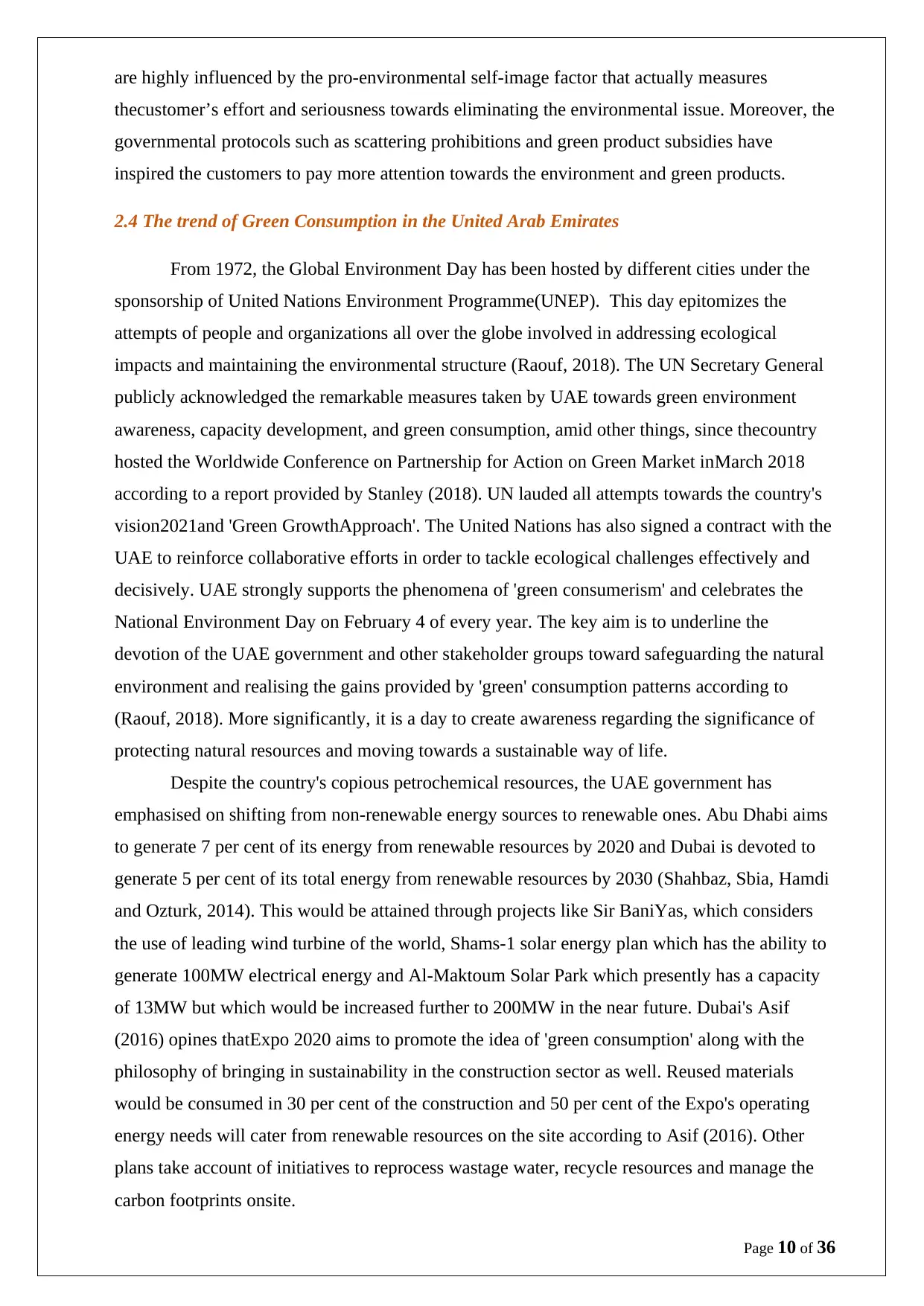
are highly influenced by the pro-environmental self-image factor that actually measures
thecustomer’s effort and seriousness towards eliminating the environmental issue. Moreover, the
governmental protocols such as scattering prohibitions and green product subsidies have
inspired the customers to pay more attention towards the environment and green products.
2.4 The trend of Green Consumption in the United Arab Emirates
From 1972, the Global Environment Day has been hosted by different cities under the
sponsorship of United Nations Environment Programme(UNEP). This day epitomizes the
attempts of people and organizations all over the globe involved in addressing ecological
impacts and maintaining the environmental structure (Raouf, 2018). The UN Secretary General
publicly acknowledged the remarkable measures taken by UAE towards green environment
awareness, capacity development, and green consumption, amid other things, since thecountry
hosted the Worldwide Conference on Partnership for Action on Green Market inMarch 2018
according to a report provided by Stanley (2018). UN lauded all attempts towards the country's
vision2021and 'Green GrowthApproach'. The United Nations has also signed a contract with the
UAE to reinforce collaborative efforts in order to tackle ecological challenges effectively and
decisively. UAE strongly supports the phenomena of 'green consumerism' and celebrates the
National Environment Day on February 4 of every year. The key aim is to underline the
devotion of the UAE government and other stakeholder groups toward safeguarding the natural
environment and realising the gains provided by 'green' consumption patterns according to
(Raouf, 2018). More significantly, it is a day to create awareness regarding the significance of
protecting natural resources and moving towards a sustainable way of life.
Despite the country's copious petrochemical resources, the UAE government has
emphasised on shifting from non-renewable energy sources to renewable ones. Abu Dhabi aims
to generate 7 per cent of its energy from renewable resources by 2020 and Dubai is devoted to
generate 5 per cent of its total energy from renewable resources by 2030 (Shahbaz, Sbia, Hamdi
and Ozturk, 2014). This would be attained through projects like Sir BaniYas, which considers
the use of leading wind turbine of the world, Shams-1 solar energy plan which has the ability to
generate 100MW electrical energy and Al-Maktoum Solar Park which presently has a capacity
of 13MW but which would be increased further to 200MW in the near future. Dubai's Asif
(2016) opines thatExpo 2020 aims to promote the idea of 'green consumption' along with the
philosophy of bringing in sustainability in the construction sector as well. Reused materials
would be consumed in 30 per cent of the construction and 50 per cent of the Expo's operating
energy needs will cater from renewable resources on the site according to Asif (2016). Other
plans take account of initiatives to reprocess wastage water, recycle resources and manage the
carbon footprints onsite.
Page 10 of 36
thecustomer’s effort and seriousness towards eliminating the environmental issue. Moreover, the
governmental protocols such as scattering prohibitions and green product subsidies have
inspired the customers to pay more attention towards the environment and green products.
2.4 The trend of Green Consumption in the United Arab Emirates
From 1972, the Global Environment Day has been hosted by different cities under the
sponsorship of United Nations Environment Programme(UNEP). This day epitomizes the
attempts of people and organizations all over the globe involved in addressing ecological
impacts and maintaining the environmental structure (Raouf, 2018). The UN Secretary General
publicly acknowledged the remarkable measures taken by UAE towards green environment
awareness, capacity development, and green consumption, amid other things, since thecountry
hosted the Worldwide Conference on Partnership for Action on Green Market inMarch 2018
according to a report provided by Stanley (2018). UN lauded all attempts towards the country's
vision2021and 'Green GrowthApproach'. The United Nations has also signed a contract with the
UAE to reinforce collaborative efforts in order to tackle ecological challenges effectively and
decisively. UAE strongly supports the phenomena of 'green consumerism' and celebrates the
National Environment Day on February 4 of every year. The key aim is to underline the
devotion of the UAE government and other stakeholder groups toward safeguarding the natural
environment and realising the gains provided by 'green' consumption patterns according to
(Raouf, 2018). More significantly, it is a day to create awareness regarding the significance of
protecting natural resources and moving towards a sustainable way of life.
Despite the country's copious petrochemical resources, the UAE government has
emphasised on shifting from non-renewable energy sources to renewable ones. Abu Dhabi aims
to generate 7 per cent of its energy from renewable resources by 2020 and Dubai is devoted to
generate 5 per cent of its total energy from renewable resources by 2030 (Shahbaz, Sbia, Hamdi
and Ozturk, 2014). This would be attained through projects like Sir BaniYas, which considers
the use of leading wind turbine of the world, Shams-1 solar energy plan which has the ability to
generate 100MW electrical energy and Al-Maktoum Solar Park which presently has a capacity
of 13MW but which would be increased further to 200MW in the near future. Dubai's Asif
(2016) opines thatExpo 2020 aims to promote the idea of 'green consumption' along with the
philosophy of bringing in sustainability in the construction sector as well. Reused materials
would be consumed in 30 per cent of the construction and 50 per cent of the Expo's operating
energy needs will cater from renewable resources on the site according to Asif (2016). Other
plans take account of initiatives to reprocess wastage water, recycle resources and manage the
carbon footprints onsite.
Page 10 of 36
Secure Best Marks with AI Grader
Need help grading? Try our AI Grader for instant feedback on your assignments.

The trend of green consumption and development has become significant in the UAE in
the past five years, from Dubai stating its goal of being one of the most 'green' regions across the
world to sustainability is one of the key themes of the EXPO 2020 plans. Federal Law 24 of
1999 lays downs the legal grounds for ecological protection and conservation of natural
resources within the UAE. This ruling requires businesses conducting developmental projects in
the country to think about the ecological impacts of their operations and makes it illegitimate to
damage the surroundings (Asif, 2016). The main philosophy behind this rule is 'the polluter pay
fines' referring that the individual who pollutes the surroundings would be legally responsible
for the clean-up cost and subject to other punishments as per the law (which vary from penalties,
detention centre, and even the capital punishment in response to break the nuclear
requirements).
Progressively recognized as a trendsetter in 'green' energy consumption and other
sustainable measures, the UAE's attempts exist in different forms. Whilst development of Dubai
Green City is underway, the Abu Dhabi has initiated 150 new natural gas driven vehicles to its
fleet service. Such vehicles are equipped with a GPS tracking scheme with a viewpoint to
decrease consumption and make certain the efficient use of vehicles (Mokri, Ali, and Emziane,
2013). Moreover, 20 stations giving compressed natural gas and 9 conversion work stations are
to be developed by coming years. Dubai, on the other hand, follows the plan of cutting
unnecessary power and water consumption by 30% in near future. A report of Stanley (2018)
confirms that Dubai's Supreme Body of Energy has articulated that around 30,000 of the
emirate's 130,000 buildings can be subject for effective modifications at a total expense of 3
billion Dirhams.
United Arab Emirates is one of the leading countries in terms of the green consumption
and sustainable development. It is identified that green consumption in the Middle Eastern
countries is difficult to initiate due to the reason of their extreme weather conditions. However,
it is reported that among all the countries in the Middle Eastern region, United Arab Emirates is
leading in terms of green consumption. LEED registered buildings are one of the coming trends
in the country with the drastic reduction of energy consumption. According to different reports,
United Arab Emirates is having the highest number of LEED certified buildings in the country
and this is one of the major trends for them. According to AI Dakheel, Tabet Aoul and Hassan
(2018), United Arab Emirates is one of the most oil rich economies in the world and sustainable
approach is being taken by the government under the scheme of Green Growth Strategy 2030.
Under this activity, green and renewable sources of energy are being given the major focus. This
is helping them in reducing the unsustainable consumption of the non renewable sources of
energy and promoting the green consumption.
Page 11 of 36
the past five years, from Dubai stating its goal of being one of the most 'green' regions across the
world to sustainability is one of the key themes of the EXPO 2020 plans. Federal Law 24 of
1999 lays downs the legal grounds for ecological protection and conservation of natural
resources within the UAE. This ruling requires businesses conducting developmental projects in
the country to think about the ecological impacts of their operations and makes it illegitimate to
damage the surroundings (Asif, 2016). The main philosophy behind this rule is 'the polluter pay
fines' referring that the individual who pollutes the surroundings would be legally responsible
for the clean-up cost and subject to other punishments as per the law (which vary from penalties,
detention centre, and even the capital punishment in response to break the nuclear
requirements).
Progressively recognized as a trendsetter in 'green' energy consumption and other
sustainable measures, the UAE's attempts exist in different forms. Whilst development of Dubai
Green City is underway, the Abu Dhabi has initiated 150 new natural gas driven vehicles to its
fleet service. Such vehicles are equipped with a GPS tracking scheme with a viewpoint to
decrease consumption and make certain the efficient use of vehicles (Mokri, Ali, and Emziane,
2013). Moreover, 20 stations giving compressed natural gas and 9 conversion work stations are
to be developed by coming years. Dubai, on the other hand, follows the plan of cutting
unnecessary power and water consumption by 30% in near future. A report of Stanley (2018)
confirms that Dubai's Supreme Body of Energy has articulated that around 30,000 of the
emirate's 130,000 buildings can be subject for effective modifications at a total expense of 3
billion Dirhams.
United Arab Emirates is one of the leading countries in terms of the green consumption
and sustainable development. It is identified that green consumption in the Middle Eastern
countries is difficult to initiate due to the reason of their extreme weather conditions. However,
it is reported that among all the countries in the Middle Eastern region, United Arab Emirates is
leading in terms of green consumption. LEED registered buildings are one of the coming trends
in the country with the drastic reduction of energy consumption. According to different reports,
United Arab Emirates is having the highest number of LEED certified buildings in the country
and this is one of the major trends for them. According to AI Dakheel, Tabet Aoul and Hassan
(2018), United Arab Emirates is one of the most oil rich economies in the world and sustainable
approach is being taken by the government under the scheme of Green Growth Strategy 2030.
Under this activity, green and renewable sources of energy are being given the major focus. This
is helping them in reducing the unsustainable consumption of the non renewable sources of
energy and promoting the green consumption.
Page 11 of 36
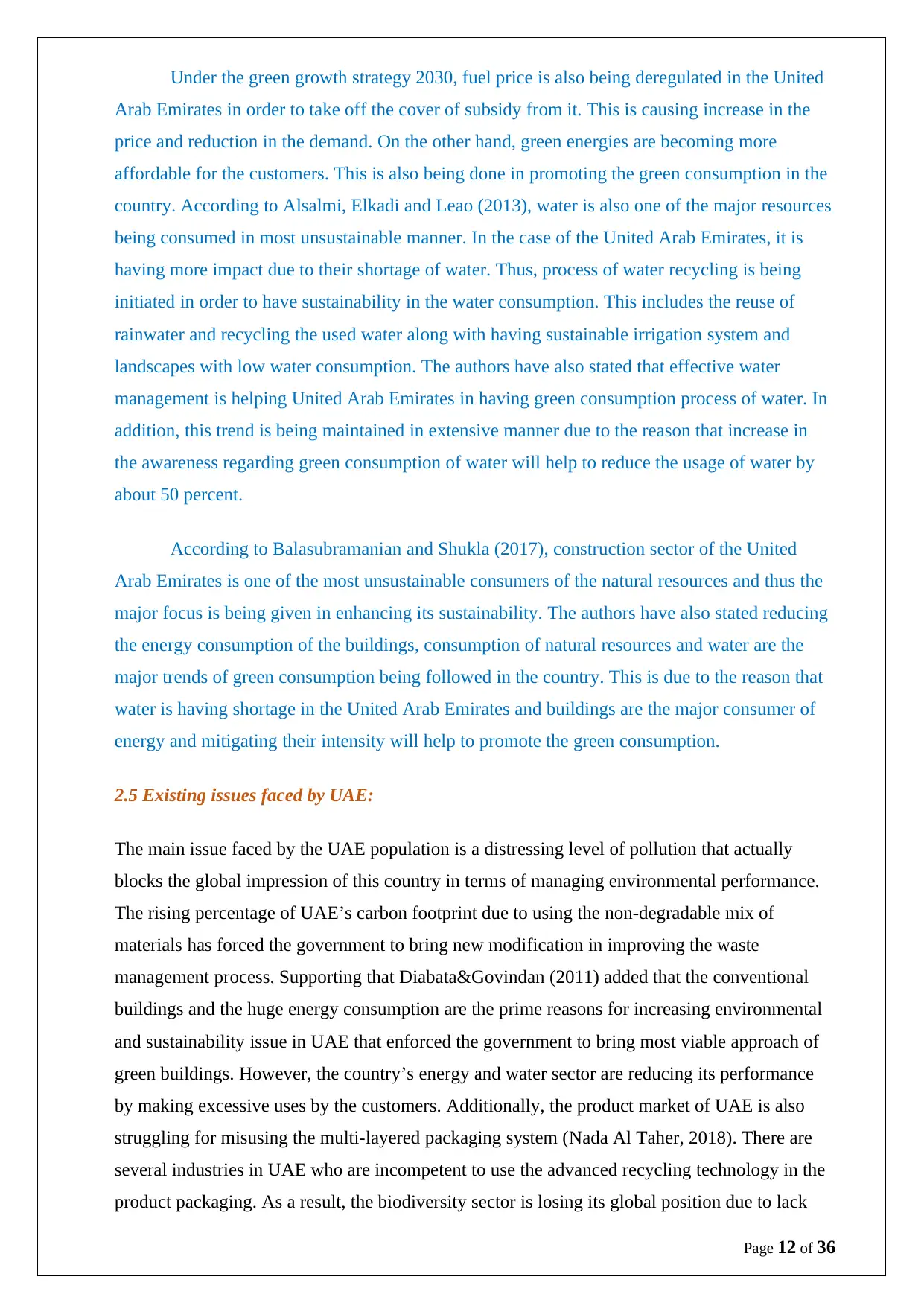
Under the green growth strategy 2030, fuel price is also being deregulated in the United
Arab Emirates in order to take off the cover of subsidy from it. This is causing increase in the
price and reduction in the demand. On the other hand, green energies are becoming more
affordable for the customers. This is also being done in promoting the green consumption in the
country. According to Alsalmi, Elkadi and Leao (2013), water is also one of the major resources
being consumed in most unsustainable manner. In the case of the United Arab Emirates, it is
having more impact due to their shortage of water. Thus, process of water recycling is being
initiated in order to have sustainability in the water consumption. This includes the reuse of
rainwater and recycling the used water along with having sustainable irrigation system and
landscapes with low water consumption. The authors have also stated that effective water
management is helping United Arab Emirates in having green consumption process of water. In
addition, this trend is being maintained in extensive manner due to the reason that increase in
the awareness regarding green consumption of water will help to reduce the usage of water by
about 50 percent.
According to Balasubramanian and Shukla (2017), construction sector of the United
Arab Emirates is one of the most unsustainable consumers of the natural resources and thus the
major focus is being given in enhancing its sustainability. The authors have also stated reducing
the energy consumption of the buildings, consumption of natural resources and water are the
major trends of green consumption being followed in the country. This is due to the reason that
water is having shortage in the United Arab Emirates and buildings are the major consumer of
energy and mitigating their intensity will help to promote the green consumption.
2.5 Existing issues faced by UAE:
The main issue faced by the UAE population is a distressing level of pollution that actually
blocks the global impression of this country in terms of managing environmental performance.
The rising percentage of UAE’s carbon footprint due to using the non-degradable mix of
materials has forced the government to bring new modification in improving the waste
management process. Supporting that Diabata&Govindan (2011) added that the conventional
buildings and the huge energy consumption are the prime reasons for increasing environmental
and sustainability issue in UAE that enforced the government to bring most viable approach of
green buildings. However, the country’s energy and water sector are reducing its performance
by making excessive uses by the customers. Additionally, the product market of UAE is also
struggling for misusing the multi-layered packaging system (Nada Al Taher, 2018). There are
several industries in UAE who are incompetent to use the advanced recycling technology in the
product packaging. As a result, the biodiversity sector is losing its global position due to lack
Page 12 of 36
Arab Emirates in order to take off the cover of subsidy from it. This is causing increase in the
price and reduction in the demand. On the other hand, green energies are becoming more
affordable for the customers. This is also being done in promoting the green consumption in the
country. According to Alsalmi, Elkadi and Leao (2013), water is also one of the major resources
being consumed in most unsustainable manner. In the case of the United Arab Emirates, it is
having more impact due to their shortage of water. Thus, process of water recycling is being
initiated in order to have sustainability in the water consumption. This includes the reuse of
rainwater and recycling the used water along with having sustainable irrigation system and
landscapes with low water consumption. The authors have also stated that effective water
management is helping United Arab Emirates in having green consumption process of water. In
addition, this trend is being maintained in extensive manner due to the reason that increase in
the awareness regarding green consumption of water will help to reduce the usage of water by
about 50 percent.
According to Balasubramanian and Shukla (2017), construction sector of the United
Arab Emirates is one of the most unsustainable consumers of the natural resources and thus the
major focus is being given in enhancing its sustainability. The authors have also stated reducing
the energy consumption of the buildings, consumption of natural resources and water are the
major trends of green consumption being followed in the country. This is due to the reason that
water is having shortage in the United Arab Emirates and buildings are the major consumer of
energy and mitigating their intensity will help to promote the green consumption.
2.5 Existing issues faced by UAE:
The main issue faced by the UAE population is a distressing level of pollution that actually
blocks the global impression of this country in terms of managing environmental performance.
The rising percentage of UAE’s carbon footprint due to using the non-degradable mix of
materials has forced the government to bring new modification in improving the waste
management process. Supporting that Diabata&Govindan (2011) added that the conventional
buildings and the huge energy consumption are the prime reasons for increasing environmental
and sustainability issue in UAE that enforced the government to bring most viable approach of
green buildings. However, the country’s energy and water sector are reducing its performance
by making excessive uses by the customers. Additionally, the product market of UAE is also
struggling for misusing the multi-layered packaging system (Nada Al Taher, 2018). There are
several industries in UAE who are incompetent to use the advanced recycling technology in the
product packaging. As a result, the biodiversity sector is losing its global position due to lack
Page 12 of 36
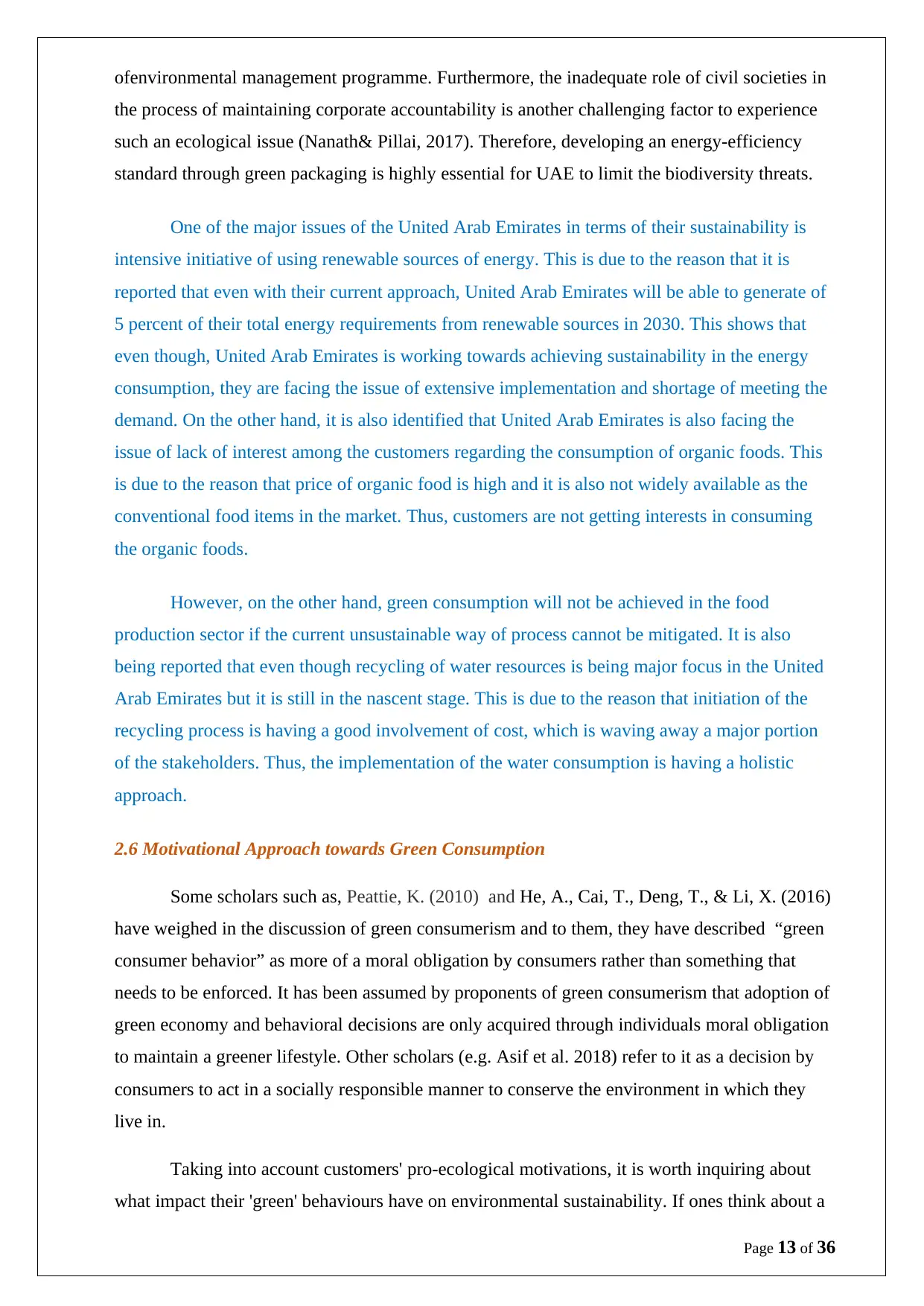
ofenvironmental management programme. Furthermore, the inadequate role of civil societies in
the process of maintaining corporate accountability is another challenging factor to experience
such an ecological issue (Nanath& Pillai, 2017). Therefore, developing an energy-efficiency
standard through green packaging is highly essential for UAE to limit the biodiversity threats.
One of the major issues of the United Arab Emirates in terms of their sustainability is
intensive initiative of using renewable sources of energy. This is due to the reason that it is
reported that even with their current approach, United Arab Emirates will be able to generate of
5 percent of their total energy requirements from renewable sources in 2030. This shows that
even though, United Arab Emirates is working towards achieving sustainability in the energy
consumption, they are facing the issue of extensive implementation and shortage of meeting the
demand. On the other hand, it is also identified that United Arab Emirates is also facing the
issue of lack of interest among the customers regarding the consumption of organic foods. This
is due to the reason that price of organic food is high and it is also not widely available as the
conventional food items in the market. Thus, customers are not getting interests in consuming
the organic foods.
However, on the other hand, green consumption will not be achieved in the food
production sector if the current unsustainable way of process cannot be mitigated. It is also
being reported that even though recycling of water resources is being major focus in the United
Arab Emirates but it is still in the nascent stage. This is due to the reason that initiation of the
recycling process is having a good involvement of cost, which is waving away a major portion
of the stakeholders. Thus, the implementation of the water consumption is having a holistic
approach.
2.6 Motivational Approach towards Green Consumption
Some scholars such as, Peattie, K. (2010) and He, A., Cai, T., Deng, T., & Li, X. (2016)
have weighed in the discussion of green consumerism and to them, they have described “green
consumer behavior” as more of a moral obligation by consumers rather than something that
needs to be enforced. It has been assumed by proponents of green consumerism that adoption of
green economy and behavioral decisions are only acquired through individuals moral obligation
to maintain a greener lifestyle. Other scholars (e.g. Asif et al. 2018) refer to it as a decision by
consumers to act in a socially responsible manner to conserve the environment in which they
live in.
Taking into account customers' pro-ecological motivations, it is worth inquiring about
what impact their 'green' behaviours have on environmental sustainability. If ones think about a
Page 13 of 36
the process of maintaining corporate accountability is another challenging factor to experience
such an ecological issue (Nanath& Pillai, 2017). Therefore, developing an energy-efficiency
standard through green packaging is highly essential for UAE to limit the biodiversity threats.
One of the major issues of the United Arab Emirates in terms of their sustainability is
intensive initiative of using renewable sources of energy. This is due to the reason that it is
reported that even with their current approach, United Arab Emirates will be able to generate of
5 percent of their total energy requirements from renewable sources in 2030. This shows that
even though, United Arab Emirates is working towards achieving sustainability in the energy
consumption, they are facing the issue of extensive implementation and shortage of meeting the
demand. On the other hand, it is also identified that United Arab Emirates is also facing the
issue of lack of interest among the customers regarding the consumption of organic foods. This
is due to the reason that price of organic food is high and it is also not widely available as the
conventional food items in the market. Thus, customers are not getting interests in consuming
the organic foods.
However, on the other hand, green consumption will not be achieved in the food
production sector if the current unsustainable way of process cannot be mitigated. It is also
being reported that even though recycling of water resources is being major focus in the United
Arab Emirates but it is still in the nascent stage. This is due to the reason that initiation of the
recycling process is having a good involvement of cost, which is waving away a major portion
of the stakeholders. Thus, the implementation of the water consumption is having a holistic
approach.
2.6 Motivational Approach towards Green Consumption
Some scholars such as, Peattie, K. (2010) and He, A., Cai, T., Deng, T., & Li, X. (2016)
have weighed in the discussion of green consumerism and to them, they have described “green
consumer behavior” as more of a moral obligation by consumers rather than something that
needs to be enforced. It has been assumed by proponents of green consumerism that adoption of
green economy and behavioral decisions are only acquired through individuals moral obligation
to maintain a greener lifestyle. Other scholars (e.g. Asif et al. 2018) refer to it as a decision by
consumers to act in a socially responsible manner to conserve the environment in which they
live in.
Taking into account customers' pro-ecological motivations, it is worth inquiring about
what impact their 'green' behaviours have on environmental sustainability. If ones think about a
Page 13 of 36
Paraphrase This Document
Need a fresh take? Get an instant paraphrase of this document with our AI Paraphraser
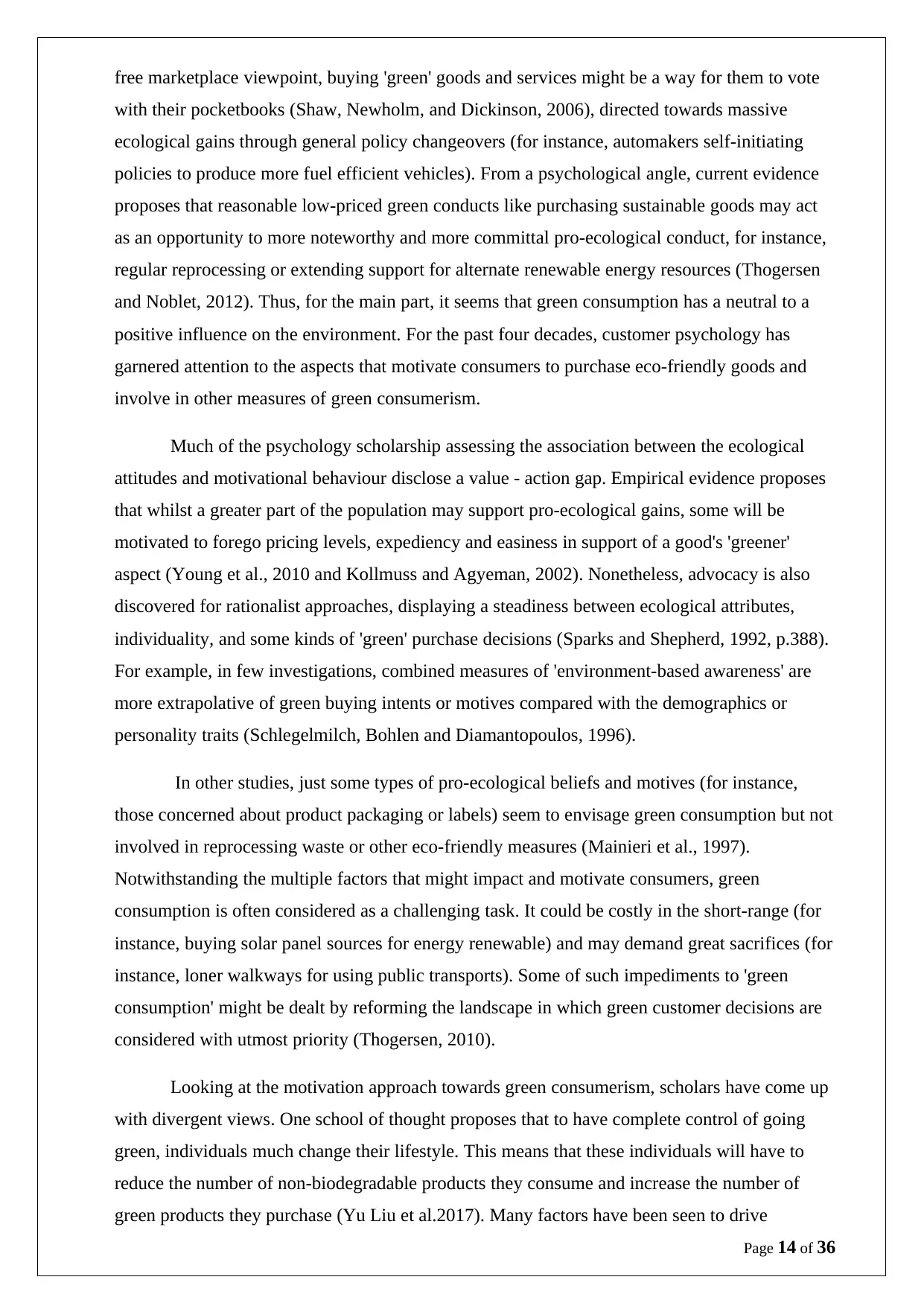
free marketplace viewpoint, buying 'green' goods and services might be a way for them to vote
with their pocketbooks (Shaw, Newholm, and Dickinson, 2006), directed towards massive
ecological gains through general policy changeovers (for instance, automakers self-initiating
policies to produce more fuel efficient vehicles). From a psychological angle, current evidence
proposes that reasonable low-priced green conducts like purchasing sustainable goods may act
as an opportunity to more noteworthy and more committal pro-ecological conduct, for instance,
regular reprocessing or extending support for alternate renewable energy resources (Thogersen
and Noblet, 2012). Thus, for the main part, it seems that green consumption has a neutral to a
positive influence on the environment. For the past four decades, customer psychology has
garnered attention to the aspects that motivate consumers to purchase eco-friendly goods and
involve in other measures of green consumerism.
Much of the psychology scholarship assessing the association between the ecological
attitudes and motivational behaviour disclose a value - action gap. Empirical evidence proposes
that whilst a greater part of the population may support pro-ecological gains, some will be
motivated to forego pricing levels, expediency and easiness in support of a good's 'greener'
aspect (Young et al., 2010 and Kollmuss and Agyeman, 2002). Nonetheless, advocacy is also
discovered for rationalist approaches, displaying a steadiness between ecological attributes,
individuality, and some kinds of 'green' purchase decisions (Sparks and Shepherd, 1992, p.388).
For example, in few investigations, combined measures of 'environment-based awareness' are
more extrapolative of green buying intents or motives compared with the demographics or
personality traits (Schlegelmilch, Bohlen and Diamantopoulos, 1996).
In other studies, just some types of pro-ecological beliefs and motives (for instance,
those concerned about product packaging or labels) seem to envisage green consumption but not
involved in reprocessing waste or other eco-friendly measures (Mainieri et al., 1997).
Notwithstanding the multiple factors that might impact and motivate consumers, green
consumption is often considered as a challenging task. It could be costly in the short-range (for
instance, buying solar panel sources for energy renewable) and may demand great sacrifices (for
instance, loner walkways for using public transports). Some of such impediments to 'green
consumption' might be dealt by reforming the landscape in which green customer decisions are
considered with utmost priority (Thogersen, 2010).
Looking at the motivation approach towards green consumerism, scholars have come up
with divergent views. One school of thought proposes that to have complete control of going
green, individuals much change their lifestyle. This means that these individuals will have to
reduce the number of non-biodegradable products they consume and increase the number of
green products they purchase (Yu Liu et al.2017). Many factors have been seen to drive
Page 14 of 36
with their pocketbooks (Shaw, Newholm, and Dickinson, 2006), directed towards massive
ecological gains through general policy changeovers (for instance, automakers self-initiating
policies to produce more fuel efficient vehicles). From a psychological angle, current evidence
proposes that reasonable low-priced green conducts like purchasing sustainable goods may act
as an opportunity to more noteworthy and more committal pro-ecological conduct, for instance,
regular reprocessing or extending support for alternate renewable energy resources (Thogersen
and Noblet, 2012). Thus, for the main part, it seems that green consumption has a neutral to a
positive influence on the environment. For the past four decades, customer psychology has
garnered attention to the aspects that motivate consumers to purchase eco-friendly goods and
involve in other measures of green consumerism.
Much of the psychology scholarship assessing the association between the ecological
attitudes and motivational behaviour disclose a value - action gap. Empirical evidence proposes
that whilst a greater part of the population may support pro-ecological gains, some will be
motivated to forego pricing levels, expediency and easiness in support of a good's 'greener'
aspect (Young et al., 2010 and Kollmuss and Agyeman, 2002). Nonetheless, advocacy is also
discovered for rationalist approaches, displaying a steadiness between ecological attributes,
individuality, and some kinds of 'green' purchase decisions (Sparks and Shepherd, 1992, p.388).
For example, in few investigations, combined measures of 'environment-based awareness' are
more extrapolative of green buying intents or motives compared with the demographics or
personality traits (Schlegelmilch, Bohlen and Diamantopoulos, 1996).
In other studies, just some types of pro-ecological beliefs and motives (for instance,
those concerned about product packaging or labels) seem to envisage green consumption but not
involved in reprocessing waste or other eco-friendly measures (Mainieri et al., 1997).
Notwithstanding the multiple factors that might impact and motivate consumers, green
consumption is often considered as a challenging task. It could be costly in the short-range (for
instance, buying solar panel sources for energy renewable) and may demand great sacrifices (for
instance, loner walkways for using public transports). Some of such impediments to 'green
consumption' might be dealt by reforming the landscape in which green customer decisions are
considered with utmost priority (Thogersen, 2010).
Looking at the motivation approach towards green consumerism, scholars have come up
with divergent views. One school of thought proposes that to have complete control of going
green, individuals much change their lifestyle. This means that these individuals will have to
reduce the number of non-biodegradable products they consume and increase the number of
green products they purchase (Yu Liu et al.2017). Many factors have been seen to drive
Page 14 of 36
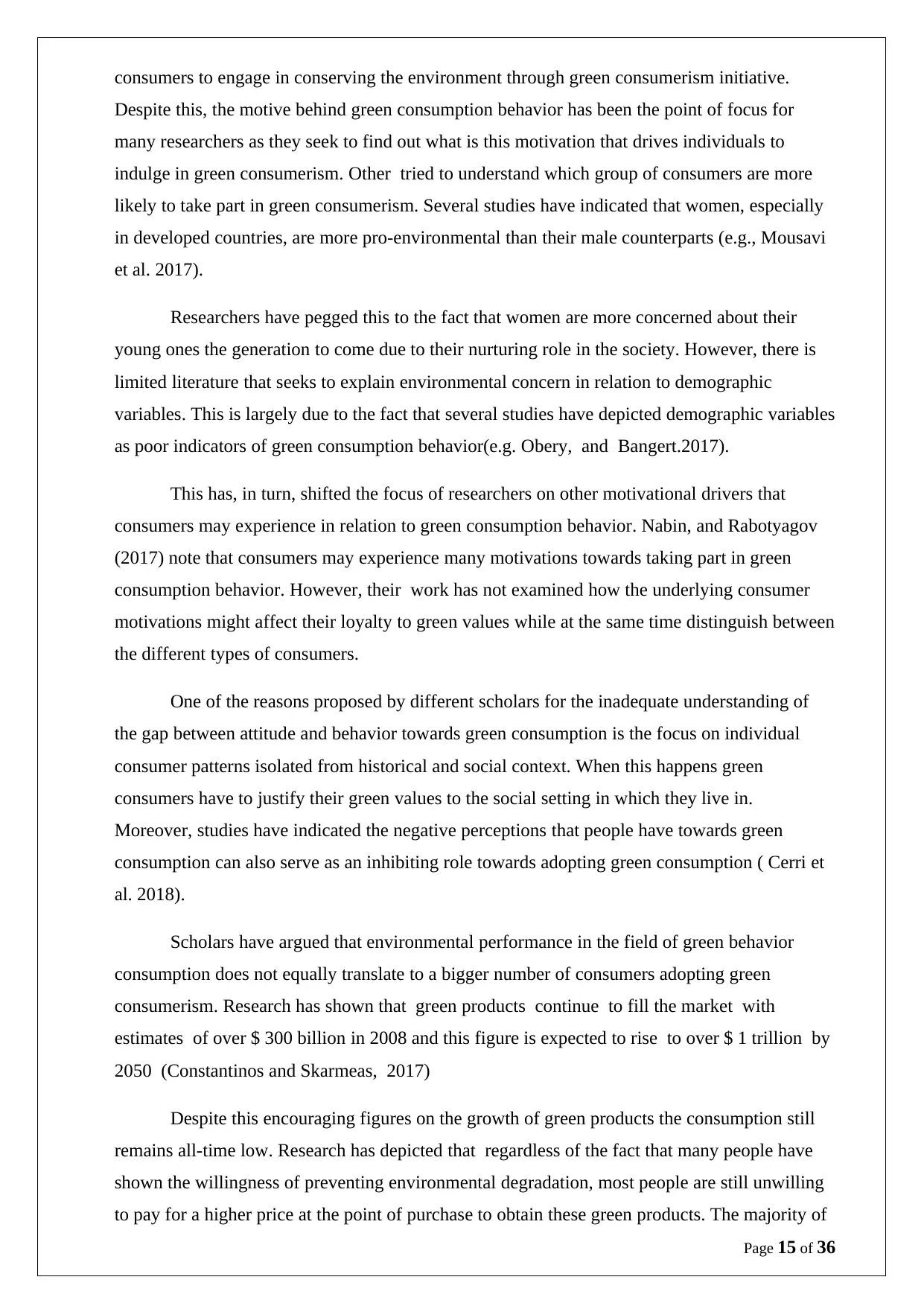
consumers to engage in conserving the environment through green consumerism initiative.
Despite this, the motive behind green consumption behavior has been the point of focus for
many researchers as they seek to find out what is this motivation that drives individuals to
indulge in green consumerism. Other tried to understand which group of consumers are more
likely to take part in green consumerism. Several studies have indicated that women, especially
in developed countries, are more pro-environmental than their male counterparts (e.g., Mousavi
et al. 2017).
Researchers have pegged this to the fact that women are more concerned about their
young ones the generation to come due to their nurturing role in the society. However, there is
limited literature that seeks to explain environmental concern in relation to demographic
variables. This is largely due to the fact that several studies have depicted demographic variables
as poor indicators of green consumption behavior(e.g. Obery, and Bangert.2017).
This has, in turn, shifted the focus of researchers on other motivational drivers that
consumers may experience in relation to green consumption behavior. Nabin, and Rabotyagov
(2017) note that consumers may experience many motivations towards taking part in green
consumption behavior. However, their work has not examined how the underlying consumer
motivations might affect their loyalty to green values while at the same time distinguish between
the different types of consumers.
One of the reasons proposed by different scholars for the inadequate understanding of
the gap between attitude and behavior towards green consumption is the focus on individual
consumer patterns isolated from historical and social context. When this happens green
consumers have to justify their green values to the social setting in which they live in.
Moreover, studies have indicated the negative perceptions that people have towards green
consumption can also serve as an inhibiting role towards adopting green consumption ( Cerri et
al. 2018).
Scholars have argued that environmental performance in the field of green behavior
consumption does not equally translate to a bigger number of consumers adopting green
consumerism. Research has shown that green products continue to fill the market with
estimates of over $ 300 billion in 2008 and this figure is expected to rise to over $ 1 trillion by
2050 (Constantinos and Skarmeas, 2017)
Despite this encouraging figures on the growth of green products the consumption still
remains all-time low. Research has depicted that regardless of the fact that many people have
shown the willingness of preventing environmental degradation, most people are still unwilling
to pay for a higher price at the point of purchase to obtain these green products. The majority of
Page 15 of 36
Despite this, the motive behind green consumption behavior has been the point of focus for
many researchers as they seek to find out what is this motivation that drives individuals to
indulge in green consumerism. Other tried to understand which group of consumers are more
likely to take part in green consumerism. Several studies have indicated that women, especially
in developed countries, are more pro-environmental than their male counterparts (e.g., Mousavi
et al. 2017).
Researchers have pegged this to the fact that women are more concerned about their
young ones the generation to come due to their nurturing role in the society. However, there is
limited literature that seeks to explain environmental concern in relation to demographic
variables. This is largely due to the fact that several studies have depicted demographic variables
as poor indicators of green consumption behavior(e.g. Obery, and Bangert.2017).
This has, in turn, shifted the focus of researchers on other motivational drivers that
consumers may experience in relation to green consumption behavior. Nabin, and Rabotyagov
(2017) note that consumers may experience many motivations towards taking part in green
consumption behavior. However, their work has not examined how the underlying consumer
motivations might affect their loyalty to green values while at the same time distinguish between
the different types of consumers.
One of the reasons proposed by different scholars for the inadequate understanding of
the gap between attitude and behavior towards green consumption is the focus on individual
consumer patterns isolated from historical and social context. When this happens green
consumers have to justify their green values to the social setting in which they live in.
Moreover, studies have indicated the negative perceptions that people have towards green
consumption can also serve as an inhibiting role towards adopting green consumption ( Cerri et
al. 2018).
Scholars have argued that environmental performance in the field of green behavior
consumption does not equally translate to a bigger number of consumers adopting green
consumerism. Research has shown that green products continue to fill the market with
estimates of over $ 300 billion in 2008 and this figure is expected to rise to over $ 1 trillion by
2050 (Constantinos and Skarmeas, 2017)
Despite this encouraging figures on the growth of green products the consumption still
remains all-time low. Research has depicted that regardless of the fact that many people have
shown the willingness of preventing environmental degradation, most people are still unwilling
to pay for a higher price at the point of purchase to obtain these green products. The majority of
Page 15 of 36
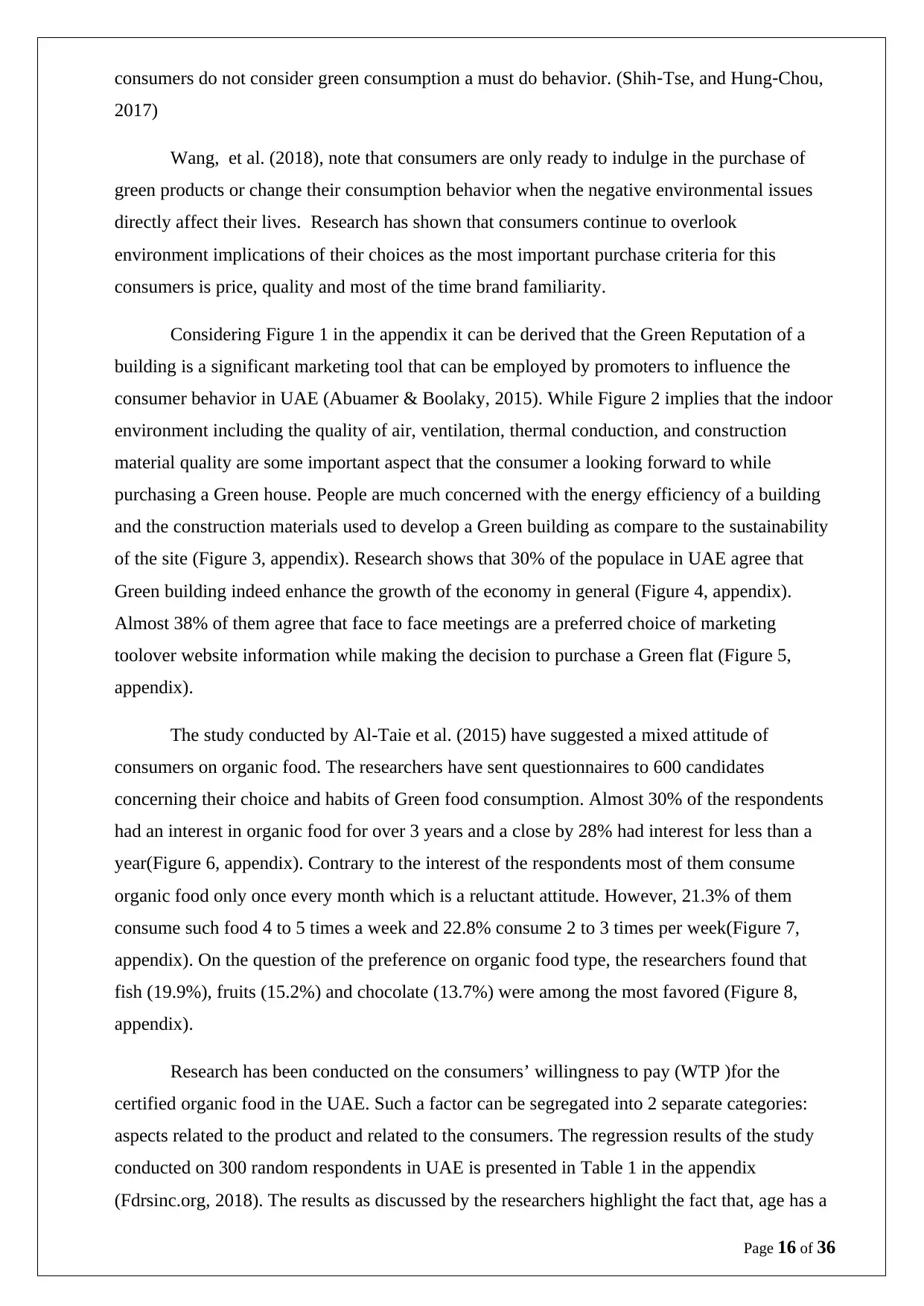
consumers do not consider green consumption a must do behavior. (Shih‐Tse, and Hung‐Chou,
2017)
Wang, et al. (2018), note that consumers are only ready to indulge in the purchase of
green products or change their consumption behavior when the negative environmental issues
directly affect their lives. Research has shown that consumers continue to overlook
environment implications of their choices as the most important purchase criteria for this
consumers is price, quality and most of the time brand familiarity.
Considering Figure 1 in the appendix it can be derived that the Green Reputation of a
building is a significant marketing tool that can be employed by promoters to influence the
consumer behavior in UAE (Abuamer & Boolaky, 2015). While Figure 2 implies that the indoor
environment including the quality of air, ventilation, thermal conduction, and construction
material quality are some important aspect that the consumer a looking forward to while
purchasing a Green house. People are much concerned with the energy efficiency of a building
and the construction materials used to develop a Green building as compare to the sustainability
of the site (Figure 3, appendix). Research shows that 30% of the populace in UAE agree that
Green building indeed enhance the growth of the economy in general (Figure 4, appendix).
Almost 38% of them agree that face to face meetings are a preferred choice of marketing
toolover website information while making the decision to purchase a Green flat (Figure 5,
appendix).
The study conducted by Al-Taie et al. (2015) have suggested a mixed attitude of
consumers on organic food. The researchers have sent questionnaires to 600 candidates
concerning their choice and habits of Green food consumption. Almost 30% of the respondents
had an interest in organic food for over 3 years and a close by 28% had interest for less than a
year(Figure 6, appendix). Contrary to the interest of the respondents most of them consume
organic food only once every month which is a reluctant attitude. However, 21.3% of them
consume such food 4 to 5 times a week and 22.8% consume 2 to 3 times per week(Figure 7,
appendix). On the question of the preference on organic food type, the researchers found that
fish (19.9%), fruits (15.2%) and chocolate (13.7%) were among the most favored (Figure 8,
appendix).
Research has been conducted on the consumers’ willingness to pay (WTP )for the
certified organic food in the UAE. Such a factor can be segregated into 2 separate categories:
aspects related to the product and related to the consumers. The regression results of the study
conducted on 300 random respondents in UAE is presented in Table 1 in the appendix
(Fdrsinc.org, 2018). The results as discussed by the researchers highlight the fact that, age has a
Page 16 of 36
2017)
Wang, et al. (2018), note that consumers are only ready to indulge in the purchase of
green products or change their consumption behavior when the negative environmental issues
directly affect their lives. Research has shown that consumers continue to overlook
environment implications of their choices as the most important purchase criteria for this
consumers is price, quality and most of the time brand familiarity.
Considering Figure 1 in the appendix it can be derived that the Green Reputation of a
building is a significant marketing tool that can be employed by promoters to influence the
consumer behavior in UAE (Abuamer & Boolaky, 2015). While Figure 2 implies that the indoor
environment including the quality of air, ventilation, thermal conduction, and construction
material quality are some important aspect that the consumer a looking forward to while
purchasing a Green house. People are much concerned with the energy efficiency of a building
and the construction materials used to develop a Green building as compare to the sustainability
of the site (Figure 3, appendix). Research shows that 30% of the populace in UAE agree that
Green building indeed enhance the growth of the economy in general (Figure 4, appendix).
Almost 38% of them agree that face to face meetings are a preferred choice of marketing
toolover website information while making the decision to purchase a Green flat (Figure 5,
appendix).
The study conducted by Al-Taie et al. (2015) have suggested a mixed attitude of
consumers on organic food. The researchers have sent questionnaires to 600 candidates
concerning their choice and habits of Green food consumption. Almost 30% of the respondents
had an interest in organic food for over 3 years and a close by 28% had interest for less than a
year(Figure 6, appendix). Contrary to the interest of the respondents most of them consume
organic food only once every month which is a reluctant attitude. However, 21.3% of them
consume such food 4 to 5 times a week and 22.8% consume 2 to 3 times per week(Figure 7,
appendix). On the question of the preference on organic food type, the researchers found that
fish (19.9%), fruits (15.2%) and chocolate (13.7%) were among the most favored (Figure 8,
appendix).
Research has been conducted on the consumers’ willingness to pay (WTP )for the
certified organic food in the UAE. Such a factor can be segregated into 2 separate categories:
aspects related to the product and related to the consumers. The regression results of the study
conducted on 300 random respondents in UAE is presented in Table 1 in the appendix
(Fdrsinc.org, 2018). The results as discussed by the researchers highlight the fact that, age has a
Page 16 of 36
Secure Best Marks with AI Grader
Need help grading? Try our AI Grader for instant feedback on your assignments.
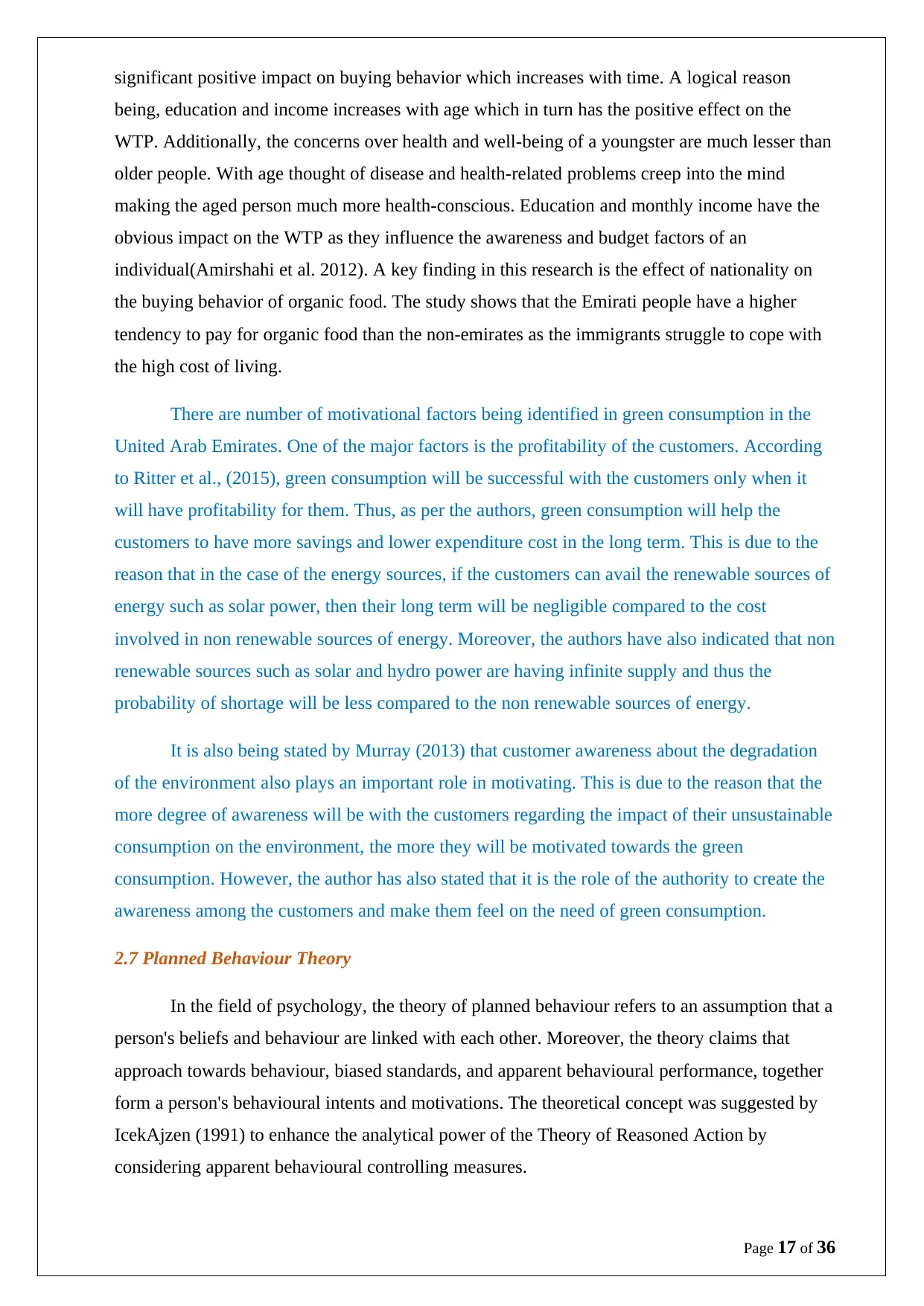
significant positive impact on buying behavior which increases with time. A logical reason
being, education and income increases with age which in turn has the positive effect on the
WTP. Additionally, the concerns over health and well-being of a youngster are much lesser than
older people. With age thought of disease and health-related problems creep into the mind
making the aged person much more health-conscious. Education and monthly income have the
obvious impact on the WTP as they influence the awareness and budget factors of an
individual(Amirshahi et al. 2012). A key finding in this research is the effect of nationality on
the buying behavior of organic food. The study shows that the Emirati people have a higher
tendency to pay for organic food than the non-emirates as the immigrants struggle to cope with
the high cost of living.
There are number of motivational factors being identified in green consumption in the
United Arab Emirates. One of the major factors is the profitability of the customers. According
to Ritter et al., (2015), green consumption will be successful with the customers only when it
will have profitability for them. Thus, as per the authors, green consumption will help the
customers to have more savings and lower expenditure cost in the long term. This is due to the
reason that in the case of the energy sources, if the customers can avail the renewable sources of
energy such as solar power, then their long term will be negligible compared to the cost
involved in non renewable sources of energy. Moreover, the authors have also indicated that non
renewable sources such as solar and hydro power are having infinite supply and thus the
probability of shortage will be less compared to the non renewable sources of energy.
It is also being stated by Murray (2013) that customer awareness about the degradation
of the environment also plays an important role in motivating. This is due to the reason that the
more degree of awareness will be with the customers regarding the impact of their unsustainable
consumption on the environment, the more they will be motivated towards the green
consumption. However, the author has also stated that it is the role of the authority to create the
awareness among the customers and make them feel on the need of green consumption.
2.7 Planned Behaviour Theory
In the field of psychology, the theory of planned behaviour refers to an assumption that a
person's beliefs and behaviour are linked with each other. Moreover, the theory claims that
approach towards behaviour, biased standards, and apparent behavioural performance, together
form a person's behavioural intents and motivations. The theoretical concept was suggested by
IcekAjzen (1991) to enhance the analytical power of the Theory of Reasoned Action by
considering apparent behavioural controlling measures.
Page 17 of 36
being, education and income increases with age which in turn has the positive effect on the
WTP. Additionally, the concerns over health and well-being of a youngster are much lesser than
older people. With age thought of disease and health-related problems creep into the mind
making the aged person much more health-conscious. Education and monthly income have the
obvious impact on the WTP as they influence the awareness and budget factors of an
individual(Amirshahi et al. 2012). A key finding in this research is the effect of nationality on
the buying behavior of organic food. The study shows that the Emirati people have a higher
tendency to pay for organic food than the non-emirates as the immigrants struggle to cope with
the high cost of living.
There are number of motivational factors being identified in green consumption in the
United Arab Emirates. One of the major factors is the profitability of the customers. According
to Ritter et al., (2015), green consumption will be successful with the customers only when it
will have profitability for them. Thus, as per the authors, green consumption will help the
customers to have more savings and lower expenditure cost in the long term. This is due to the
reason that in the case of the energy sources, if the customers can avail the renewable sources of
energy such as solar power, then their long term will be negligible compared to the cost
involved in non renewable sources of energy. Moreover, the authors have also indicated that non
renewable sources such as solar and hydro power are having infinite supply and thus the
probability of shortage will be less compared to the non renewable sources of energy.
It is also being stated by Murray (2013) that customer awareness about the degradation
of the environment also plays an important role in motivating. This is due to the reason that the
more degree of awareness will be with the customers regarding the impact of their unsustainable
consumption on the environment, the more they will be motivated towards the green
consumption. However, the author has also stated that it is the role of the authority to create the
awareness among the customers and make them feel on the need of green consumption.
2.7 Planned Behaviour Theory
In the field of psychology, the theory of planned behaviour refers to an assumption that a
person's beliefs and behaviour are linked with each other. Moreover, the theory claims that
approach towards behaviour, biased standards, and apparent behavioural performance, together
form a person's behavioural intents and motivations. The theoretical concept was suggested by
IcekAjzen (1991) to enhance the analytical power of the Theory of Reasoned Action by
considering apparent behavioural controlling measures.
Page 17 of 36
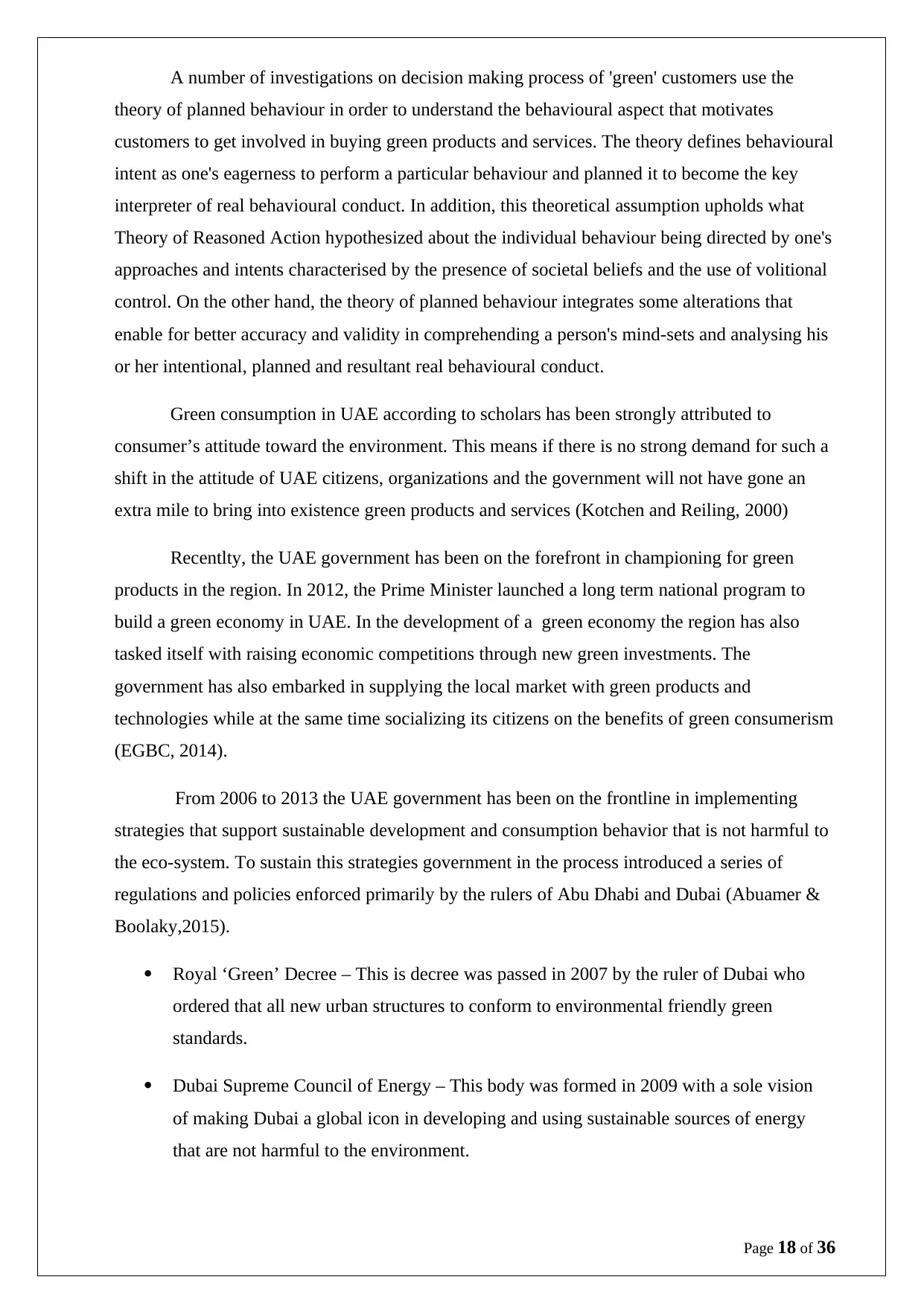
A number of investigations on decision making process of 'green' customers use the
theory of planned behaviour in order to understand the behavioural aspect that motivates
customers to get involved in buying green products and services. The theory defines behavioural
intent as one's eagerness to perform a particular behaviour and planned it to become the key
interpreter of real behavioural conduct. In addition, this theoretical assumption upholds what
Theory of Reasoned Action hypothesized about the individual behaviour being directed by one's
approaches and intents characterised by the presence of societal beliefs and the use of volitional
control. On the other hand, the theory of planned behaviour integrates some alterations that
enable for better accuracy and validity in comprehending a person's mind-sets and analysing his
or her intentional, planned and resultant real behavioural conduct.
Green consumption in UAE according to scholars has been strongly attributed to
consumer’s attitude toward the environment. This means if there is no strong demand for such a
shift in the attitude of UAE citizens, organizations and the government will not have gone an
extra mile to bring into existence green products and services (Kotchen and Reiling, 2000)
Recentlty, the UAE government has been on the forefront in championing for green
products in the region. In 2012, the Prime Minister launched a long term national program to
build a green economy in UAE. In the development of a green economy the region has also
tasked itself with raising economic competitions through new green investments. The
government has also embarked in supplying the local market with green products and
technologies while at the same time socializing its citizens on the benefits of green consumerism
(EGBC, 2014).
From 2006 to 2013 the UAE government has been on the frontline in implementing
strategies that support sustainable development and consumption behavior that is not harmful to
the eco-system. To sustain this strategies government in the process introduced a series of
regulations and policies enforced primarily by the rulers of Abu Dhabi and Dubai (Abuamer &
Boolaky,2015).
Royal ‘Green’ Decree – This is decree was passed in 2007 by the ruler of Dubai who
ordered that all new urban structures to conform to environmental friendly green
standards.
Dubai Supreme Council of Energy – This body was formed in 2009 with a sole vision
of making Dubai a global icon in developing and using sustainable sources of energy
that are not harmful to the environment.
Page 18 of 36
theory of planned behaviour in order to understand the behavioural aspect that motivates
customers to get involved in buying green products and services. The theory defines behavioural
intent as one's eagerness to perform a particular behaviour and planned it to become the key
interpreter of real behavioural conduct. In addition, this theoretical assumption upholds what
Theory of Reasoned Action hypothesized about the individual behaviour being directed by one's
approaches and intents characterised by the presence of societal beliefs and the use of volitional
control. On the other hand, the theory of planned behaviour integrates some alterations that
enable for better accuracy and validity in comprehending a person's mind-sets and analysing his
or her intentional, planned and resultant real behavioural conduct.
Green consumption in UAE according to scholars has been strongly attributed to
consumer’s attitude toward the environment. This means if there is no strong demand for such a
shift in the attitude of UAE citizens, organizations and the government will not have gone an
extra mile to bring into existence green products and services (Kotchen and Reiling, 2000)
Recentlty, the UAE government has been on the forefront in championing for green
products in the region. In 2012, the Prime Minister launched a long term national program to
build a green economy in UAE. In the development of a green economy the region has also
tasked itself with raising economic competitions through new green investments. The
government has also embarked in supplying the local market with green products and
technologies while at the same time socializing its citizens on the benefits of green consumerism
(EGBC, 2014).
From 2006 to 2013 the UAE government has been on the frontline in implementing
strategies that support sustainable development and consumption behavior that is not harmful to
the eco-system. To sustain this strategies government in the process introduced a series of
regulations and policies enforced primarily by the rulers of Abu Dhabi and Dubai (Abuamer &
Boolaky,2015).
Royal ‘Green’ Decree – This is decree was passed in 2007 by the ruler of Dubai who
ordered that all new urban structures to conform to environmental friendly green
standards.
Dubai Supreme Council of Energy – This body was formed in 2009 with a sole vision
of making Dubai a global icon in developing and using sustainable sources of energy
that are not harmful to the environment.
Page 18 of 36
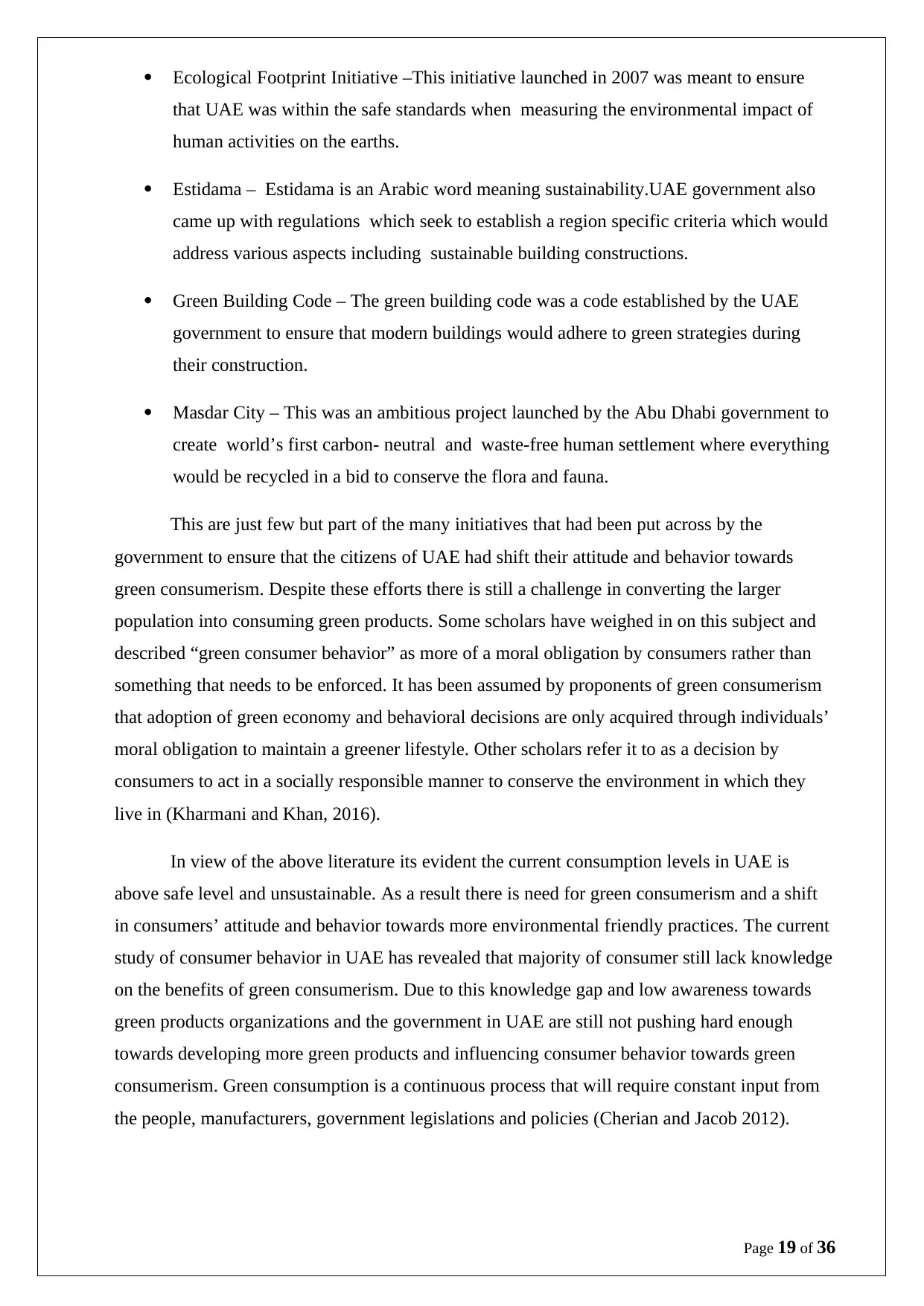
Ecological Footprint Initiative –This initiative launched in 2007 was meant to ensure
that UAE was within the safe standards when measuring the environmental impact of
human activities on the earths.
Estidama – Estidama is an Arabic word meaning sustainability.UAE government also
came up with regulations which seek to establish a region specific criteria which would
address various aspects including sustainable building constructions.
Green Building Code – The green building code was a code established by the UAE
government to ensure that modern buildings would adhere to green strategies during
their construction.
Masdar City – This was an ambitious project launched by the Abu Dhabi government to
create world’s first carbon- neutral and waste-free human settlement where everything
would be recycled in a bid to conserve the flora and fauna.
This are just few but part of the many initiatives that had been put across by the
government to ensure that the citizens of UAE had shift their attitude and behavior towards
green consumerism. Despite these efforts there is still a challenge in converting the larger
population into consuming green products. Some scholars have weighed in on this subject and
described “green consumer behavior” as more of a moral obligation by consumers rather than
something that needs to be enforced. It has been assumed by proponents of green consumerism
that adoption of green economy and behavioral decisions are only acquired through individuals’
moral obligation to maintain a greener lifestyle. Other scholars refer it to as a decision by
consumers to act in a socially responsible manner to conserve the environment in which they
live in (Kharmani and Khan, 2016).
In view of the above literature its evident the current consumption levels in UAE is
above safe level and unsustainable. As a result there is need for green consumerism and a shift
in consumers’ attitude and behavior towards more environmental friendly practices. The current
study of consumer behavior in UAE has revealed that majority of consumer still lack knowledge
on the benefits of green consumerism. Due to this knowledge gap and low awareness towards
green products organizations and the government in UAE are still not pushing hard enough
towards developing more green products and influencing consumer behavior towards green
consumerism. Green consumption is a continuous process that will require constant input from
the people, manufacturers, government legislations and policies (Cherian and Jacob 2012).
Page 19 of 36
that UAE was within the safe standards when measuring the environmental impact of
human activities on the earths.
Estidama – Estidama is an Arabic word meaning sustainability.UAE government also
came up with regulations which seek to establish a region specific criteria which would
address various aspects including sustainable building constructions.
Green Building Code – The green building code was a code established by the UAE
government to ensure that modern buildings would adhere to green strategies during
their construction.
Masdar City – This was an ambitious project launched by the Abu Dhabi government to
create world’s first carbon- neutral and waste-free human settlement where everything
would be recycled in a bid to conserve the flora and fauna.
This are just few but part of the many initiatives that had been put across by the
government to ensure that the citizens of UAE had shift their attitude and behavior towards
green consumerism. Despite these efforts there is still a challenge in converting the larger
population into consuming green products. Some scholars have weighed in on this subject and
described “green consumer behavior” as more of a moral obligation by consumers rather than
something that needs to be enforced. It has been assumed by proponents of green consumerism
that adoption of green economy and behavioral decisions are only acquired through individuals’
moral obligation to maintain a greener lifestyle. Other scholars refer it to as a decision by
consumers to act in a socially responsible manner to conserve the environment in which they
live in (Kharmani and Khan, 2016).
In view of the above literature its evident the current consumption levels in UAE is
above safe level and unsustainable. As a result there is need for green consumerism and a shift
in consumers’ attitude and behavior towards more environmental friendly practices. The current
study of consumer behavior in UAE has revealed that majority of consumer still lack knowledge
on the benefits of green consumerism. Due to this knowledge gap and low awareness towards
green products organizations and the government in UAE are still not pushing hard enough
towards developing more green products and influencing consumer behavior towards green
consumerism. Green consumption is a continuous process that will require constant input from
the people, manufacturers, government legislations and policies (Cherian and Jacob 2012).
Page 19 of 36
Paraphrase This Document
Need a fresh take? Get an instant paraphrase of this document with our AI Paraphraser
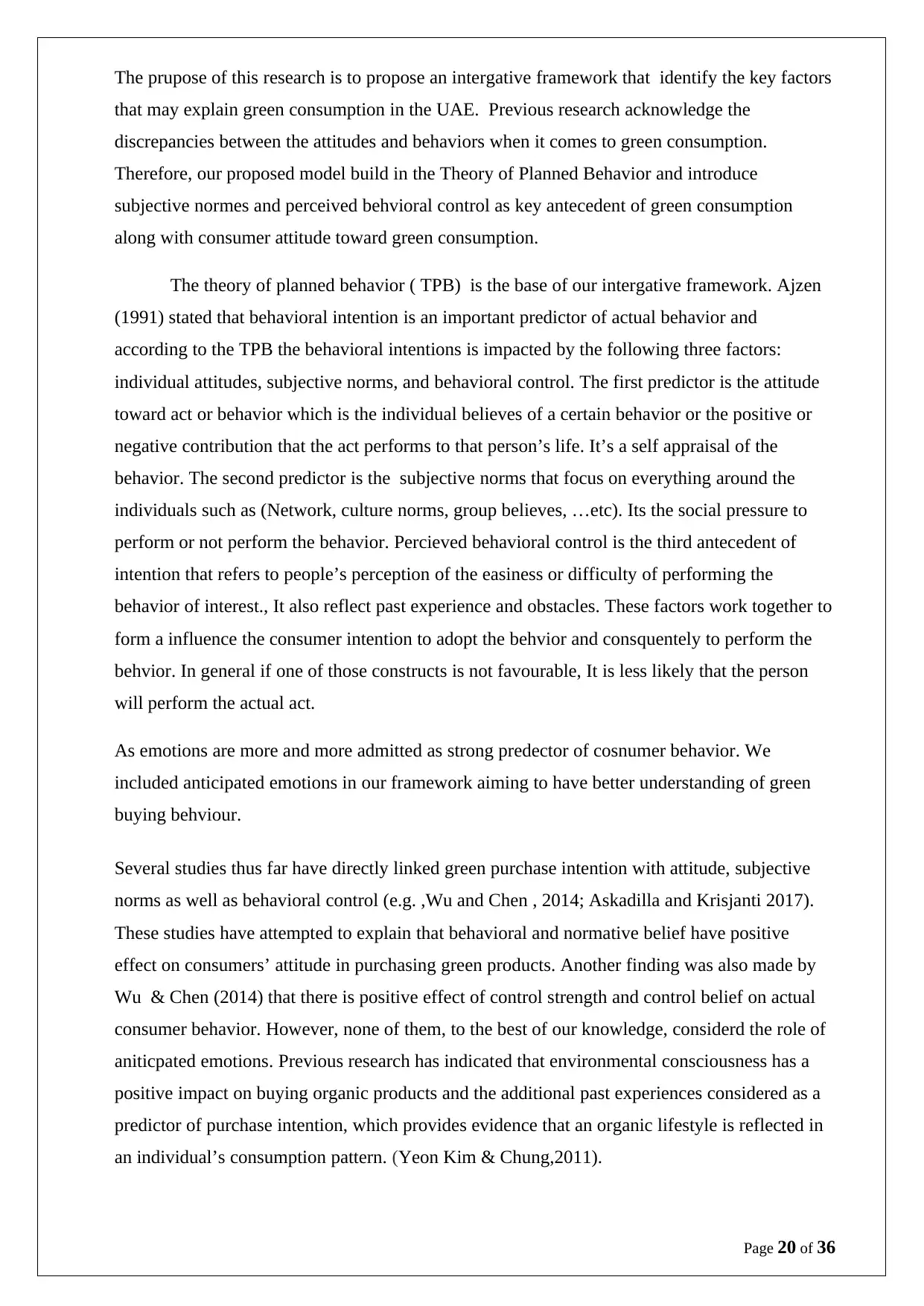
The prupose of this research is to propose an intergative framework that identify the key factors
that may explain green consumption in the UAE. Previous research acknowledge the
discrepancies between the attitudes and behaviors when it comes to green consumption.
Therefore, our proposed model build in the Theory of Planned Behavior and introduce
subjective normes and perceived behvioral control as key antecedent of green consumption
along with consumer attitude toward green consumption.
The theory of planned behavior ( TPB) is the base of our intergative framework. Ajzen
(1991) stated that behavioral intention is an important predictor of actual behavior and
according to the TPB the behavioral intentions is impacted by the following three factors:
individual attitudes, subjective norms, and behavioral control. The first predictor is the attitude
toward act or behavior which is the individual believes of a certain behavior or the positive or
negative contribution that the act performs to that person’s life. It’s a self appraisal of the
behavior. The second predictor is the subjective norms that focus on everything around the
individuals such as (Network, culture norms, group believes, …etc). Its the social pressure to
perform or not perform the behavior. Percieved behavioral control is the third antecedent of
intention that refers to people’s perception of the easiness or difficulty of performing the
behavior of interest., It also reflect past experience and obstacles. These factors work together to
form a influence the consumer intention to adopt the behvior and consquentely to perform the
behvior. In general if one of those constructs is not favourable, It is less likely that the person
will perform the actual act.
As emotions are more and more admitted as strong predector of cosnumer behavior. We
included anticipated emotions in our framework aiming to have better understanding of green
buying behviour.
Several studies thus far have directly linked green purchase intention with attitude, subjective
norms as well as behavioral control (e.g. ,Wu and Chen , 2014; Askadilla and Krisjanti 2017).
These studies have attempted to explain that behavioral and normative belief have positive
effect on consumers’ attitude in purchasing green products. Another finding was also made by
Wu & Chen (2014) that there is positive effect of control strength and control belief on actual
consumer behavior. However, none of them, to the best of our knowledge, considerd the role of
aniticpated emotions. Previous research has indicated that environmental consciousness has a
positive impact on buying organic products and the additional past experiences considered as a
predictor of purchase intention, which provides evidence that an organic lifestyle is reflected in
an individual’s consumption pattern. (Yeon Kim & Chung,2011).
Page 20 of 36
that may explain green consumption in the UAE. Previous research acknowledge the
discrepancies between the attitudes and behaviors when it comes to green consumption.
Therefore, our proposed model build in the Theory of Planned Behavior and introduce
subjective normes and perceived behvioral control as key antecedent of green consumption
along with consumer attitude toward green consumption.
The theory of planned behavior ( TPB) is the base of our intergative framework. Ajzen
(1991) stated that behavioral intention is an important predictor of actual behavior and
according to the TPB the behavioral intentions is impacted by the following three factors:
individual attitudes, subjective norms, and behavioral control. The first predictor is the attitude
toward act or behavior which is the individual believes of a certain behavior or the positive or
negative contribution that the act performs to that person’s life. It’s a self appraisal of the
behavior. The second predictor is the subjective norms that focus on everything around the
individuals such as (Network, culture norms, group believes, …etc). Its the social pressure to
perform or not perform the behavior. Percieved behavioral control is the third antecedent of
intention that refers to people’s perception of the easiness or difficulty of performing the
behavior of interest., It also reflect past experience and obstacles. These factors work together to
form a influence the consumer intention to adopt the behvior and consquentely to perform the
behvior. In general if one of those constructs is not favourable, It is less likely that the person
will perform the actual act.
As emotions are more and more admitted as strong predector of cosnumer behavior. We
included anticipated emotions in our framework aiming to have better understanding of green
buying behviour.
Several studies thus far have directly linked green purchase intention with attitude, subjective
norms as well as behavioral control (e.g. ,Wu and Chen , 2014; Askadilla and Krisjanti 2017).
These studies have attempted to explain that behavioral and normative belief have positive
effect on consumers’ attitude in purchasing green products. Another finding was also made by
Wu & Chen (2014) that there is positive effect of control strength and control belief on actual
consumer behavior. However, none of them, to the best of our knowledge, considerd the role of
aniticpated emotions. Previous research has indicated that environmental consciousness has a
positive impact on buying organic products and the additional past experiences considered as a
predictor of purchase intention, which provides evidence that an organic lifestyle is reflected in
an individual’s consumption pattern. (Yeon Kim & Chung,2011).
Page 20 of 36
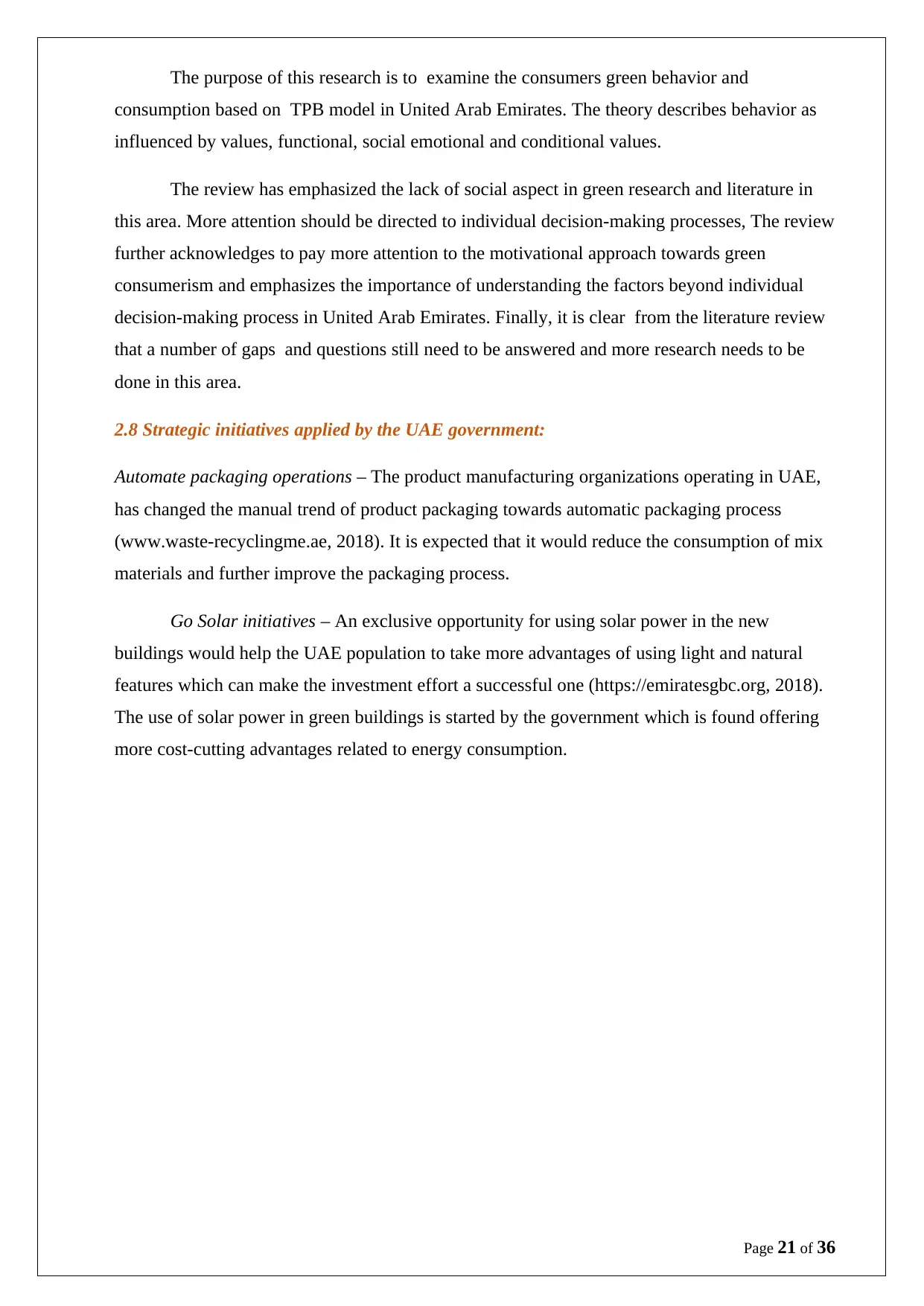
The purpose of this research is to examine the consumers green behavior and
consumption based on TPB model in United Arab Emirates. The theory describes behavior as
influenced by values, functional, social emotional and conditional values.
The review has emphasized the lack of social aspect in green research and literature in
this area. More attention should be directed to individual decision-making processes, The review
further acknowledges to pay more attention to the motivational approach towards green
consumerism and emphasizes the importance of understanding the factors beyond individual
decision-making process in United Arab Emirates. Finally, it is clear from the literature review
that a number of gaps and questions still need to be answered and more research needs to be
done in this area.
2.8 Strategic initiatives applied by the UAE government:
Automate packaging operations – The product manufacturing organizations operating in UAE,
has changed the manual trend of product packaging towards automatic packaging process
(www.waste-recyclingme.ae, 2018). It is expected that it would reduce the consumption of mix
materials and further improve the packaging process.
Go Solar initiatives – An exclusive opportunity for using solar power in the new
buildings would help the UAE population to take more advantages of using light and natural
features which can make the investment effort a successful one (https://emiratesgbc.org, 2018).
The use of solar power in green buildings is started by the government which is found offering
more cost-cutting advantages related to energy consumption.
Page 21 of 36
consumption based on TPB model in United Arab Emirates. The theory describes behavior as
influenced by values, functional, social emotional and conditional values.
The review has emphasized the lack of social aspect in green research and literature in
this area. More attention should be directed to individual decision-making processes, The review
further acknowledges to pay more attention to the motivational approach towards green
consumerism and emphasizes the importance of understanding the factors beyond individual
decision-making process in United Arab Emirates. Finally, it is clear from the literature review
that a number of gaps and questions still need to be answered and more research needs to be
done in this area.
2.8 Strategic initiatives applied by the UAE government:
Automate packaging operations – The product manufacturing organizations operating in UAE,
has changed the manual trend of product packaging towards automatic packaging process
(www.waste-recyclingme.ae, 2018). It is expected that it would reduce the consumption of mix
materials and further improve the packaging process.
Go Solar initiatives – An exclusive opportunity for using solar power in the new
buildings would help the UAE population to take more advantages of using light and natural
features which can make the investment effort a successful one (https://emiratesgbc.org, 2018).
The use of solar power in green buildings is started by the government which is found offering
more cost-cutting advantages related to energy consumption.
Page 21 of 36
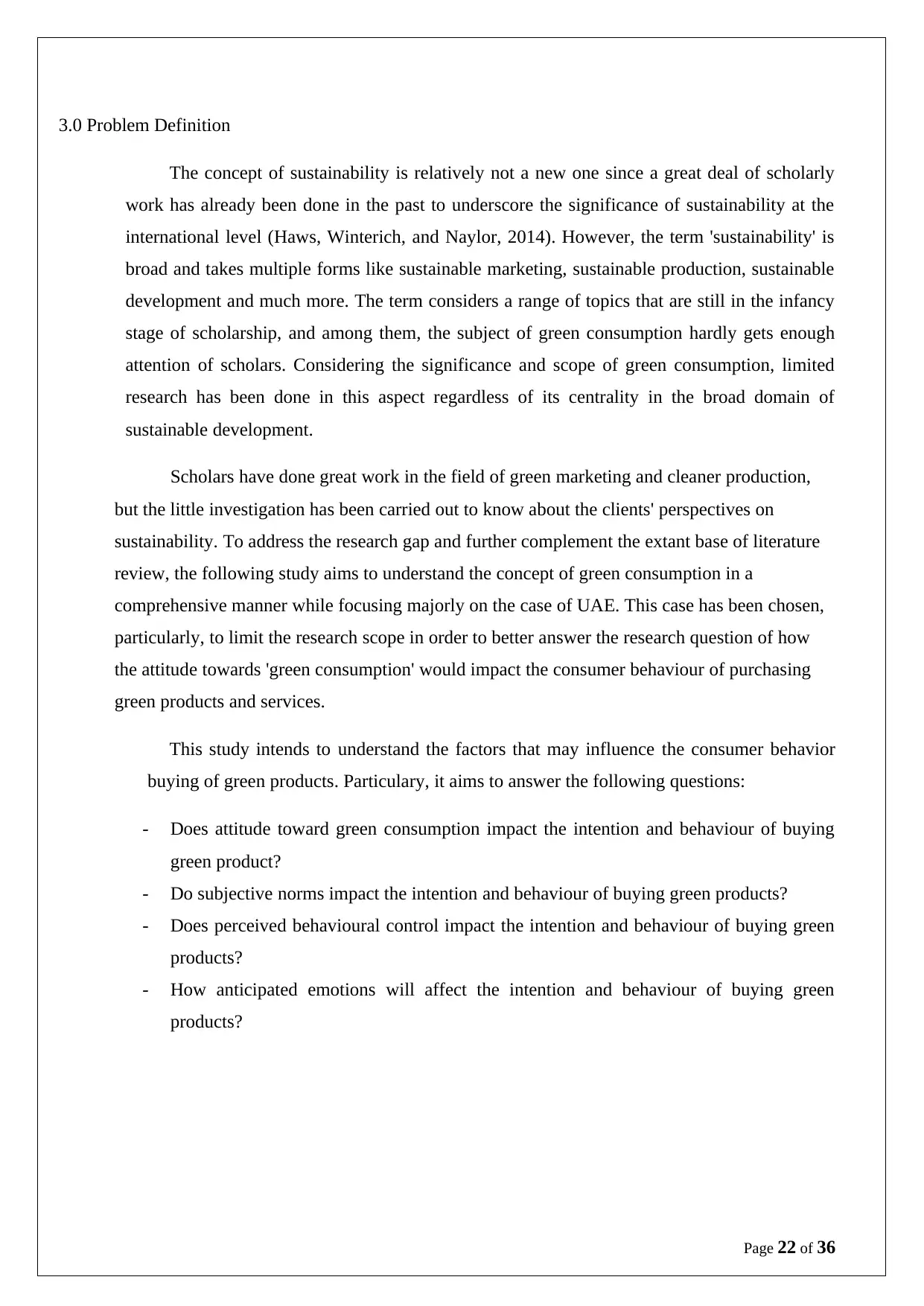
3.0 Problem Definition
The concept of sustainability is relatively not a new one since a great deal of scholarly
work has already been done in the past to underscore the significance of sustainability at the
international level (Haws, Winterich, and Naylor, 2014). However, the term 'sustainability' is
broad and takes multiple forms like sustainable marketing, sustainable production, sustainable
development and much more. The term considers a range of topics that are still in the infancy
stage of scholarship, and among them, the subject of green consumption hardly gets enough
attention of scholars. Considering the significance and scope of green consumption, limited
research has been done in this aspect regardless of its centrality in the broad domain of
sustainable development.
Scholars have done great work in the field of green marketing and cleaner production,
but the little investigation has been carried out to know about the clients' perspectives on
sustainability. To address the research gap and further complement the extant base of literature
review, the following study aims to understand the concept of green consumption in a
comprehensive manner while focusing majorly on the case of UAE. This case has been chosen,
particularly, to limit the research scope in order to better answer the research question of how
the attitude towards 'green consumption' would impact the consumer behaviour of purchasing
green products and services.
This study intends to understand the factors that may influence the consumer behavior
buying of green products. Particulary, it aims to answer the following questions:
- Does attitude toward green consumption impact the intention and behaviour of buying
green product?
- Do subjective norms impact the intention and behaviour of buying green products?
- Does perceived behavioural control impact the intention and behaviour of buying green
products?
- How anticipated emotions will affect the intention and behaviour of buying green
products?
Page 22 of 36
The concept of sustainability is relatively not a new one since a great deal of scholarly
work has already been done in the past to underscore the significance of sustainability at the
international level (Haws, Winterich, and Naylor, 2014). However, the term 'sustainability' is
broad and takes multiple forms like sustainable marketing, sustainable production, sustainable
development and much more. The term considers a range of topics that are still in the infancy
stage of scholarship, and among them, the subject of green consumption hardly gets enough
attention of scholars. Considering the significance and scope of green consumption, limited
research has been done in this aspect regardless of its centrality in the broad domain of
sustainable development.
Scholars have done great work in the field of green marketing and cleaner production,
but the little investigation has been carried out to know about the clients' perspectives on
sustainability. To address the research gap and further complement the extant base of literature
review, the following study aims to understand the concept of green consumption in a
comprehensive manner while focusing majorly on the case of UAE. This case has been chosen,
particularly, to limit the research scope in order to better answer the research question of how
the attitude towards 'green consumption' would impact the consumer behaviour of purchasing
green products and services.
This study intends to understand the factors that may influence the consumer behavior
buying of green products. Particulary, it aims to answer the following questions:
- Does attitude toward green consumption impact the intention and behaviour of buying
green product?
- Do subjective norms impact the intention and behaviour of buying green products?
- Does perceived behavioural control impact the intention and behaviour of buying green
products?
- How anticipated emotions will affect the intention and behaviour of buying green
products?
Page 22 of 36
Secure Best Marks with AI Grader
Need help grading? Try our AI Grader for instant feedback on your assignments.
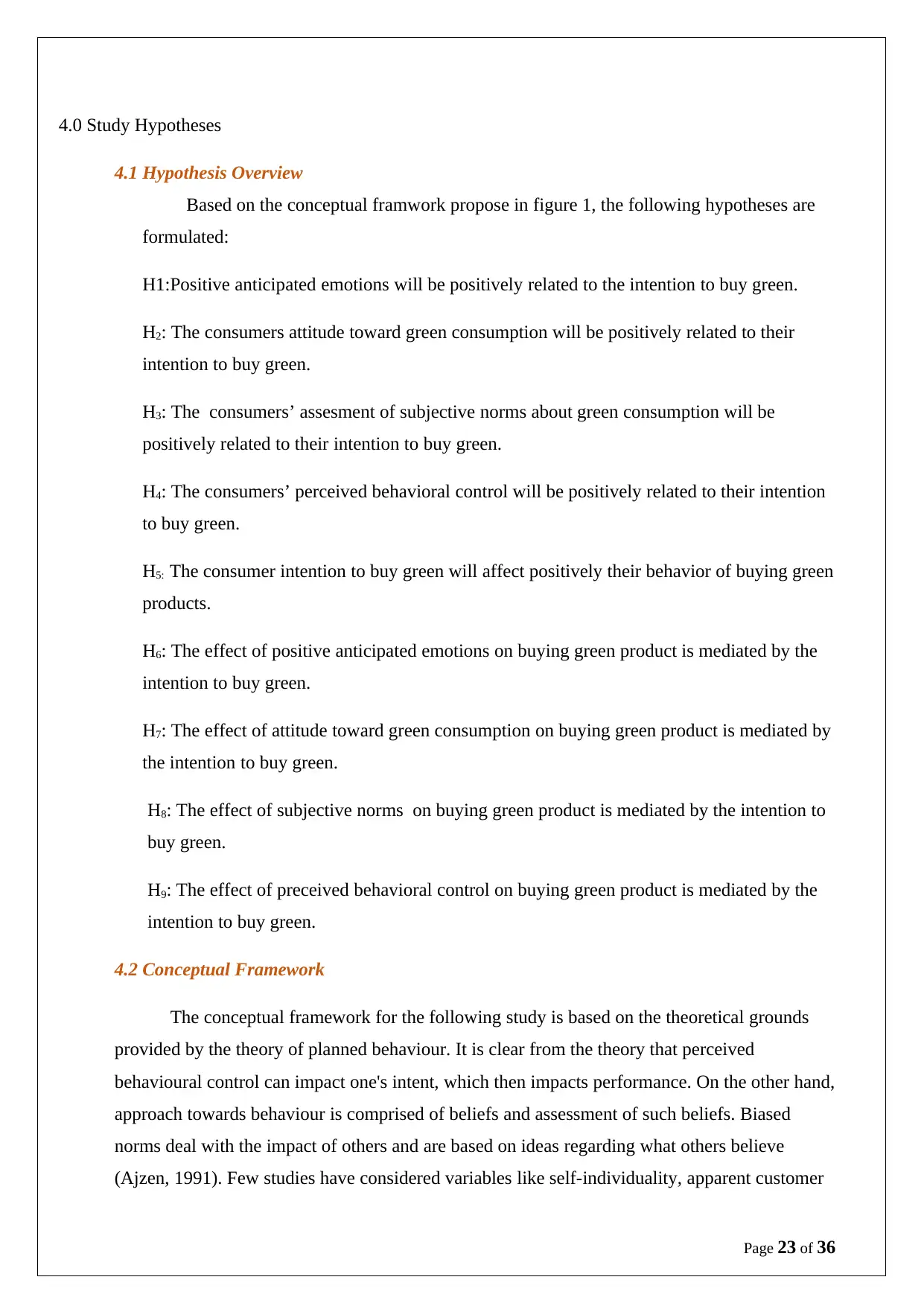
4.0 Study Hypotheses
4.1 Hypothesis Overview
Based on the conceptual framwork propose in figure 1, the following hypotheses are
formulated:
H1:Positive anticipated emotions will be positively related to the intention to buy green.
H2: The consumers attitude toward green consumption will be positively related to their
intention to buy green.
H3: The consumers’ assesment of subjective norms about green consumption will be
positively related to their intention to buy green.
H4: The consumers’ perceived behavioral control will be positively related to their intention
to buy green.
H5: The consumer intention to buy green will affect positively their behavior of buying green
products.
H6: The effect of positive anticipated emotions on buying green product is mediated by the
intention to buy green.
H7: The effect of attitude toward green consumption on buying green product is mediated by
the intention to buy green.
H8: The effect of subjective norms on buying green product is mediated by the intention to
buy green.
H9: The effect of preceived behavioral control on buying green product is mediated by the
intention to buy green.
4.2 Conceptual Framework
The conceptual framework for the following study is based on the theoretical grounds
provided by the theory of planned behaviour. It is clear from the theory that perceived
behavioural control can impact one's intent, which then impacts performance. On the other hand,
approach towards behaviour is comprised of beliefs and assessment of such beliefs. Biased
norms deal with the impact of others and are based on ideas regarding what others believe
(Ajzen, 1991). Few studies have considered variables like self-individuality, apparent customer
Page 23 of 36
4.1 Hypothesis Overview
Based on the conceptual framwork propose in figure 1, the following hypotheses are
formulated:
H1:Positive anticipated emotions will be positively related to the intention to buy green.
H2: The consumers attitude toward green consumption will be positively related to their
intention to buy green.
H3: The consumers’ assesment of subjective norms about green consumption will be
positively related to their intention to buy green.
H4: The consumers’ perceived behavioral control will be positively related to their intention
to buy green.
H5: The consumer intention to buy green will affect positively their behavior of buying green
products.
H6: The effect of positive anticipated emotions on buying green product is mediated by the
intention to buy green.
H7: The effect of attitude toward green consumption on buying green product is mediated by
the intention to buy green.
H8: The effect of subjective norms on buying green product is mediated by the intention to
buy green.
H9: The effect of preceived behavioral control on buying green product is mediated by the
intention to buy green.
4.2 Conceptual Framework
The conceptual framework for the following study is based on the theoretical grounds
provided by the theory of planned behaviour. It is clear from the theory that perceived
behavioural control can impact one's intent, which then impacts performance. On the other hand,
approach towards behaviour is comprised of beliefs and assessment of such beliefs. Biased
norms deal with the impact of others and are based on ideas regarding what others believe
(Ajzen, 1991). Few studies have considered variables like self-individuality, apparent customer
Page 23 of 36
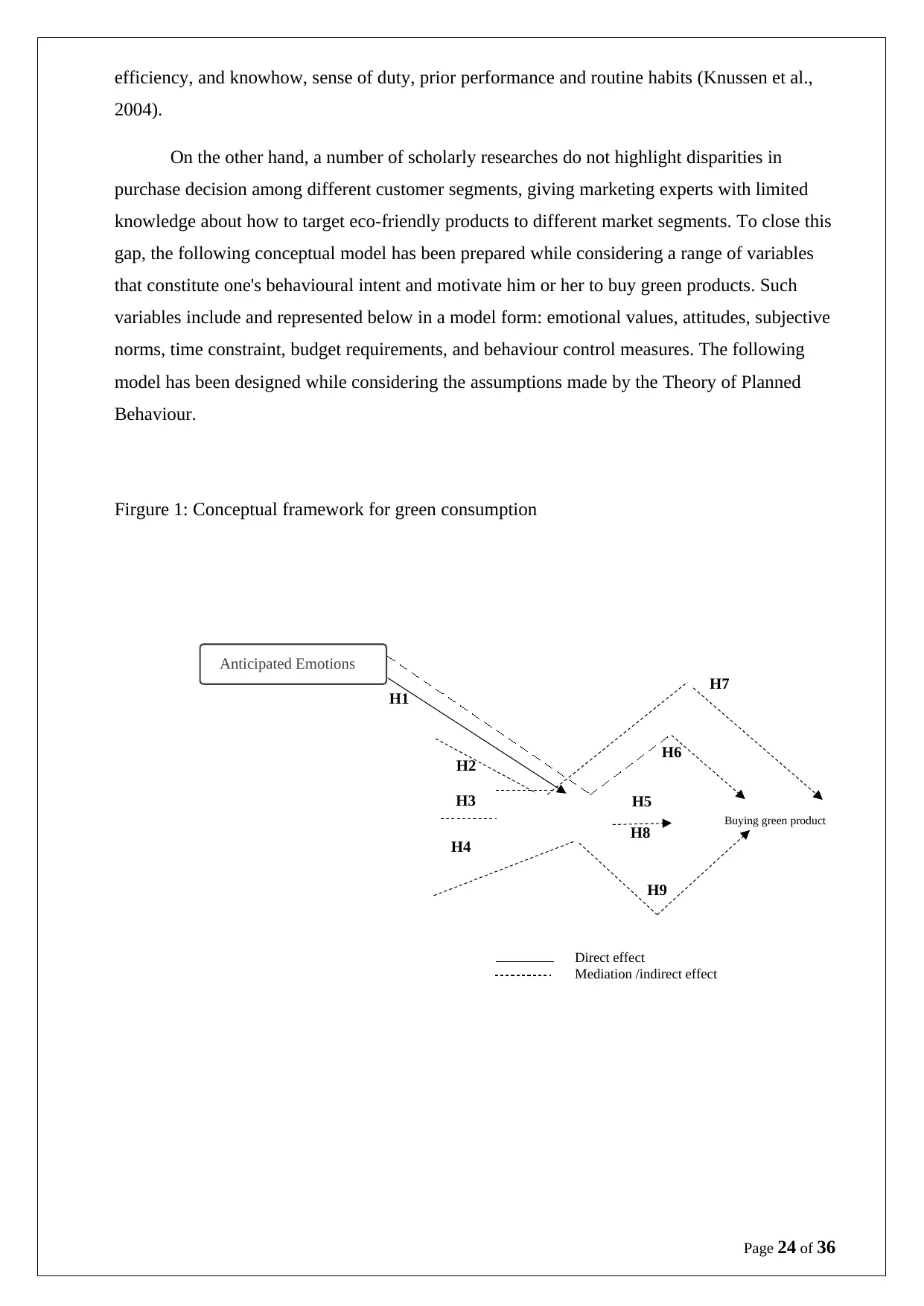
efficiency, and knowhow, sense of duty, prior performance and routine habits (Knussen et al.,
2004).
On the other hand, a number of scholarly researches do not highlight disparities in
purchase decision among different customer segments, giving marketing experts with limited
knowledge about how to target eco-friendly products to different market segments. To close this
gap, the following conceptual model has been prepared while considering a range of variables
that constitute one's behavioural intent and motivate him or her to buy green products. Such
variables include and represented below in a model form: emotional values, attitudes, subjective
norms, time constraint, budget requirements, and behaviour control measures. The following
model has been designed while considering the assumptions made by the Theory of Planned
Behaviour.
Firgure 1: Conceptual framework for green consumption
Page 24 of 36
Anticipated Emotions
Buying green product
H1
H2
H3
H4
H5
H6
H7
H9
H8
Direct effect
Mediation /indirect effect
2004).
On the other hand, a number of scholarly researches do not highlight disparities in
purchase decision among different customer segments, giving marketing experts with limited
knowledge about how to target eco-friendly products to different market segments. To close this
gap, the following conceptual model has been prepared while considering a range of variables
that constitute one's behavioural intent and motivate him or her to buy green products. Such
variables include and represented below in a model form: emotional values, attitudes, subjective
norms, time constraint, budget requirements, and behaviour control measures. The following
model has been designed while considering the assumptions made by the Theory of Planned
Behaviour.
Firgure 1: Conceptual framework for green consumption
Page 24 of 36
Anticipated Emotions
Buying green product
H1
H2
H3
H4
H5
H6
H7
H9
H8
Direct effect
Mediation /indirect effect
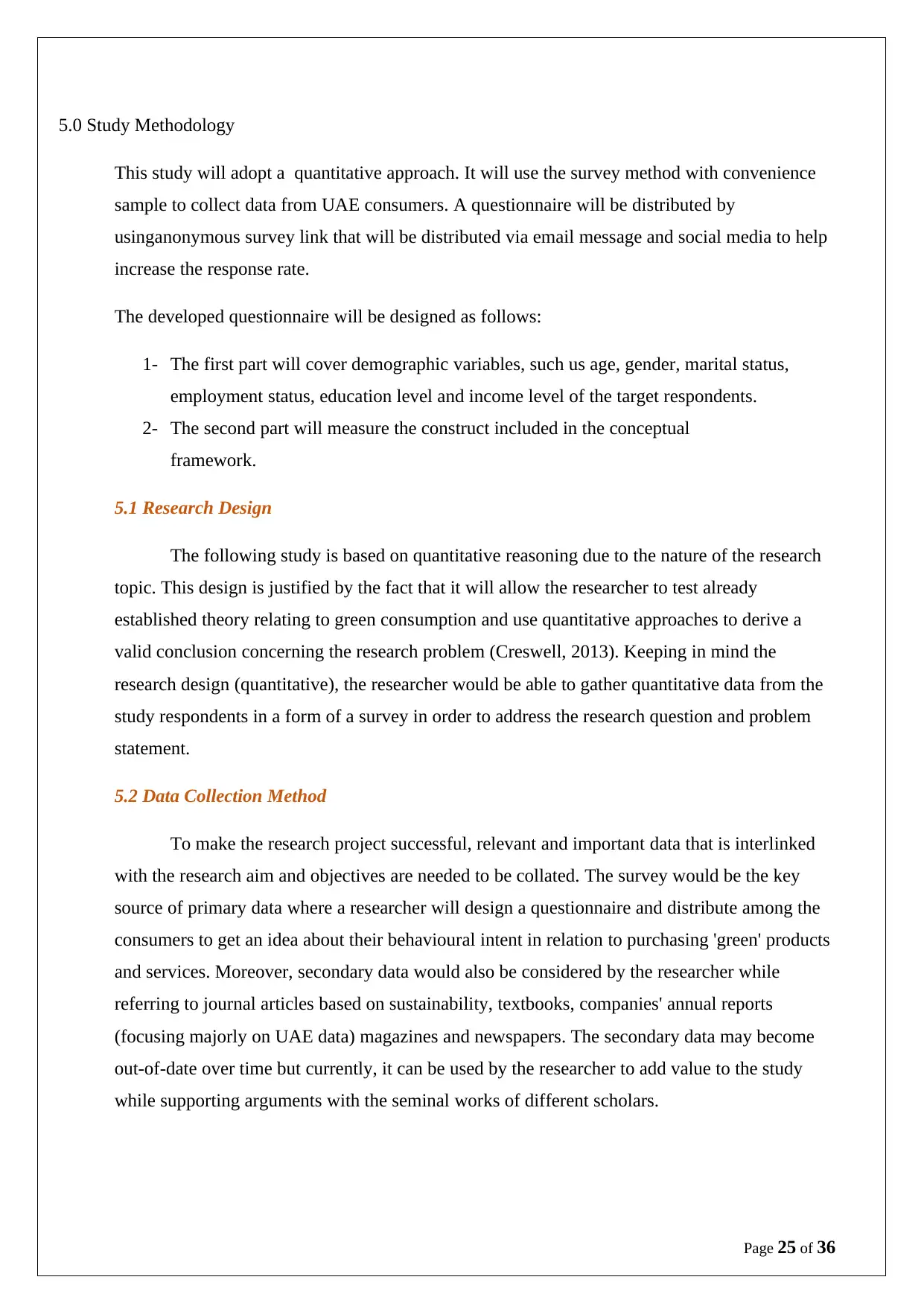
5.0 Study Methodology
This study will adopt a quantitative approach. It will use the survey method with convenience
sample to collect data from UAE consumers. A questionnaire will be distributed by
usinganonymous survey link that will be distributed via email message and social media to help
increase the response rate.
The developed questionnaire will be designed as follows:
1- The first part will cover demographic variables, such us age, gender, marital status,
employment status, education level and income level of the target respondents.
2- The second part will measure the construct included in the conceptual
framework.
5.1 Research Design
The following study is based on quantitative reasoning due to the nature of the research
topic. This design is justified by the fact that it will allow the researcher to test already
established theory relating to green consumption and use quantitative approaches to derive a
valid conclusion concerning the research problem (Creswell, 2013). Keeping in mind the
research design (quantitative), the researcher would be able to gather quantitative data from the
study respondents in a form of a survey in order to address the research question and problem
statement.
5.2 Data Collection Method
To make the research project successful, relevant and important data that is interlinked
with the research aim and objectives are needed to be collated. The survey would be the key
source of primary data where a researcher will design a questionnaire and distribute among the
consumers to get an idea about their behavioural intent in relation to purchasing 'green' products
and services. Moreover, secondary data would also be considered by the researcher while
referring to journal articles based on sustainability, textbooks, companies' annual reports
(focusing majorly on UAE data) magazines and newspapers. The secondary data may become
out-of-date over time but currently, it can be used by the researcher to add value to the study
while supporting arguments with the seminal works of different scholars.
Page 25 of 36
This study will adopt a quantitative approach. It will use the survey method with convenience
sample to collect data from UAE consumers. A questionnaire will be distributed by
usinganonymous survey link that will be distributed via email message and social media to help
increase the response rate.
The developed questionnaire will be designed as follows:
1- The first part will cover demographic variables, such us age, gender, marital status,
employment status, education level and income level of the target respondents.
2- The second part will measure the construct included in the conceptual
framework.
5.1 Research Design
The following study is based on quantitative reasoning due to the nature of the research
topic. This design is justified by the fact that it will allow the researcher to test already
established theory relating to green consumption and use quantitative approaches to derive a
valid conclusion concerning the research problem (Creswell, 2013). Keeping in mind the
research design (quantitative), the researcher would be able to gather quantitative data from the
study respondents in a form of a survey in order to address the research question and problem
statement.
5.2 Data Collection Method
To make the research project successful, relevant and important data that is interlinked
with the research aim and objectives are needed to be collated. The survey would be the key
source of primary data where a researcher will design a questionnaire and distribute among the
consumers to get an idea about their behavioural intent in relation to purchasing 'green' products
and services. Moreover, secondary data would also be considered by the researcher while
referring to journal articles based on sustainability, textbooks, companies' annual reports
(focusing majorly on UAE data) magazines and newspapers. The secondary data may become
out-of-date over time but currently, it can be used by the researcher to add value to the study
while supporting arguments with the seminal works of different scholars.
Page 25 of 36
Paraphrase This Document
Need a fresh take? Get an instant paraphrase of this document with our AI Paraphraser
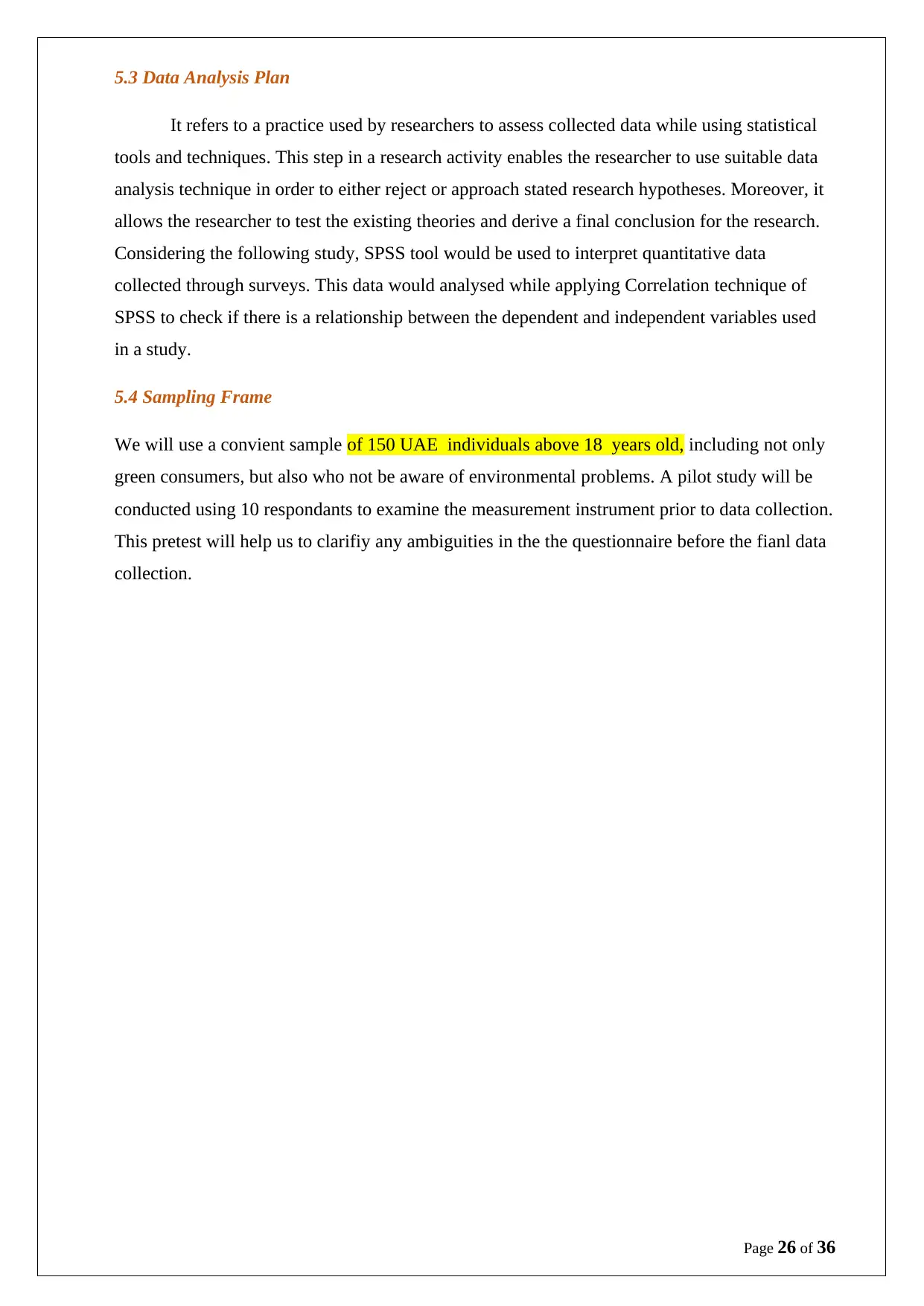
5.3 Data Analysis Plan
It refers to a practice used by researchers to assess collected data while using statistical
tools and techniques. This step in a research activity enables the researcher to use suitable data
analysis technique in order to either reject or approach stated research hypotheses. Moreover, it
allows the researcher to test the existing theories and derive a final conclusion for the research.
Considering the following study, SPSS tool would be used to interpret quantitative data
collected through surveys. This data would analysed while applying Correlation technique of
SPSS to check if there is a relationship between the dependent and independent variables used
in a study.
5.4 Sampling Frame
We will use a convient sample of 150 UAE individuals above 18 years old, including not only
green consumers, but also who not be aware of environmental problems. A pilot study will be
conducted using 10 respondants to examine the measurement instrument prior to data collection.
This pretest will help us to clarifiy any ambiguities in the the questionnaire before the fianl data
collection.
Page 26 of 36
It refers to a practice used by researchers to assess collected data while using statistical
tools and techniques. This step in a research activity enables the researcher to use suitable data
analysis technique in order to either reject or approach stated research hypotheses. Moreover, it
allows the researcher to test the existing theories and derive a final conclusion for the research.
Considering the following study, SPSS tool would be used to interpret quantitative data
collected through surveys. This data would analysed while applying Correlation technique of
SPSS to check if there is a relationship between the dependent and independent variables used
in a study.
5.4 Sampling Frame
We will use a convient sample of 150 UAE individuals above 18 years old, including not only
green consumers, but also who not be aware of environmental problems. A pilot study will be
conducted using 10 respondants to examine the measurement instrument prior to data collection.
This pretest will help us to clarifiy any ambiguities in the the questionnaire before the fianl data
collection.
Page 26 of 36
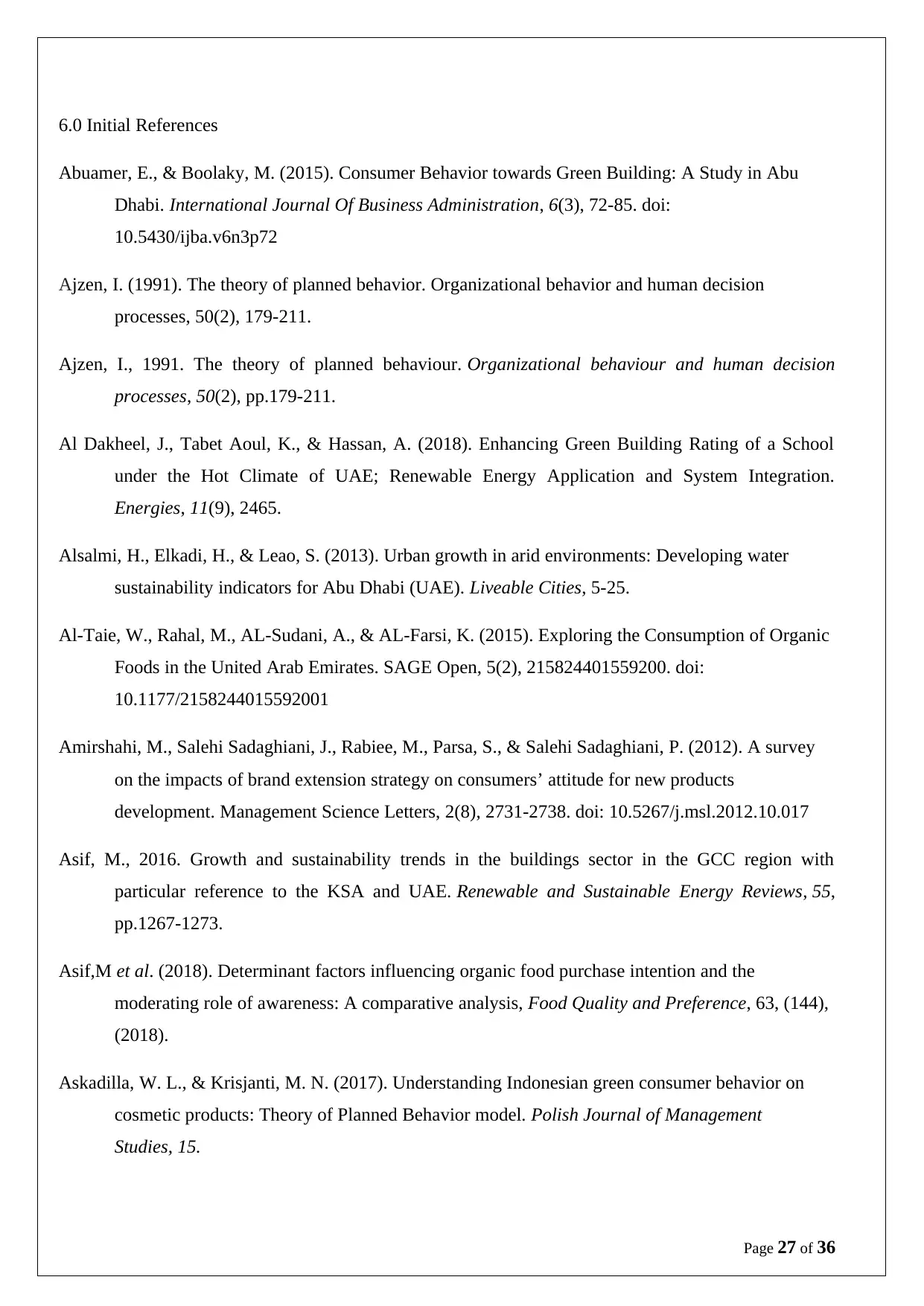
6.0 Initial References
Abuamer, E., & Boolaky, M. (2015). Consumer Behavior towards Green Building: A Study in Abu
Dhabi. International Journal Of Business Administration, 6(3), 72-85. doi:
10.5430/ijba.v6n3p72
Ajzen, I. (1991). The theory of planned behavior. Organizational behavior and human decision
processes, 50(2), 179-211.
Ajzen, I., 1991. The theory of planned behaviour. Organizational behaviour and human decision
processes, 50(2), pp.179-211.
Al Dakheel, J., Tabet Aoul, K., & Hassan, A. (2018). Enhancing Green Building Rating of a School
under the Hot Climate of UAE; Renewable Energy Application and System Integration.
Energies, 11(9), 2465.
Alsalmi, H., Elkadi, H., & Leao, S. (2013). Urban growth in arid environments: Developing water
sustainability indicators for Abu Dhabi (UAE). Liveable Cities, 5-25.
Al-Taie, W., Rahal, M., AL-Sudani, A., & AL-Farsi, K. (2015). Exploring the Consumption of Organic
Foods in the United Arab Emirates. SAGE Open, 5(2), 215824401559200. doi:
10.1177/2158244015592001
Amirshahi, M., Salehi Sadaghiani, J., Rabiee, M., Parsa, S., & Salehi Sadaghiani, P. (2012). A survey
on the impacts of brand extension strategy on consumers’ attitude for new products
development. Management Science Letters, 2(8), 2731-2738. doi: 10.5267/j.msl.2012.10.017
Asif, M., 2016. Growth and sustainability trends in the buildings sector in the GCC region with
particular reference to the KSA and UAE. Renewable and Sustainable Energy Reviews, 55,
pp.1267-1273.
Asif,M et al. (2018). Determinant factors influencing organic food purchase intention and the
moderating role of awareness: A comparative analysis, Food Quality and Preference, 63, (144),
(2018).
Askadilla, W. L., & Krisjanti, M. N. (2017). Understanding Indonesian green consumer behavior on
cosmetic products: Theory of Planned Behavior model. Polish Journal of Management
Studies, 15.
Page 27 of 36
Abuamer, E., & Boolaky, M. (2015). Consumer Behavior towards Green Building: A Study in Abu
Dhabi. International Journal Of Business Administration, 6(3), 72-85. doi:
10.5430/ijba.v6n3p72
Ajzen, I. (1991). The theory of planned behavior. Organizational behavior and human decision
processes, 50(2), 179-211.
Ajzen, I., 1991. The theory of planned behaviour. Organizational behaviour and human decision
processes, 50(2), pp.179-211.
Al Dakheel, J., Tabet Aoul, K., & Hassan, A. (2018). Enhancing Green Building Rating of a School
under the Hot Climate of UAE; Renewable Energy Application and System Integration.
Energies, 11(9), 2465.
Alsalmi, H., Elkadi, H., & Leao, S. (2013). Urban growth in arid environments: Developing water
sustainability indicators for Abu Dhabi (UAE). Liveable Cities, 5-25.
Al-Taie, W., Rahal, M., AL-Sudani, A., & AL-Farsi, K. (2015). Exploring the Consumption of Organic
Foods in the United Arab Emirates. SAGE Open, 5(2), 215824401559200. doi:
10.1177/2158244015592001
Amirshahi, M., Salehi Sadaghiani, J., Rabiee, M., Parsa, S., & Salehi Sadaghiani, P. (2012). A survey
on the impacts of brand extension strategy on consumers’ attitude for new products
development. Management Science Letters, 2(8), 2731-2738. doi: 10.5267/j.msl.2012.10.017
Asif, M., 2016. Growth and sustainability trends in the buildings sector in the GCC region with
particular reference to the KSA and UAE. Renewable and Sustainable Energy Reviews, 55,
pp.1267-1273.
Asif,M et al. (2018). Determinant factors influencing organic food purchase intention and the
moderating role of awareness: A comparative analysis, Food Quality and Preference, 63, (144),
(2018).
Askadilla, W. L., & Krisjanti, M. N. (2017). Understanding Indonesian green consumer behavior on
cosmetic products: Theory of Planned Behavior model. Polish Journal of Management
Studies, 15.
Page 27 of 36
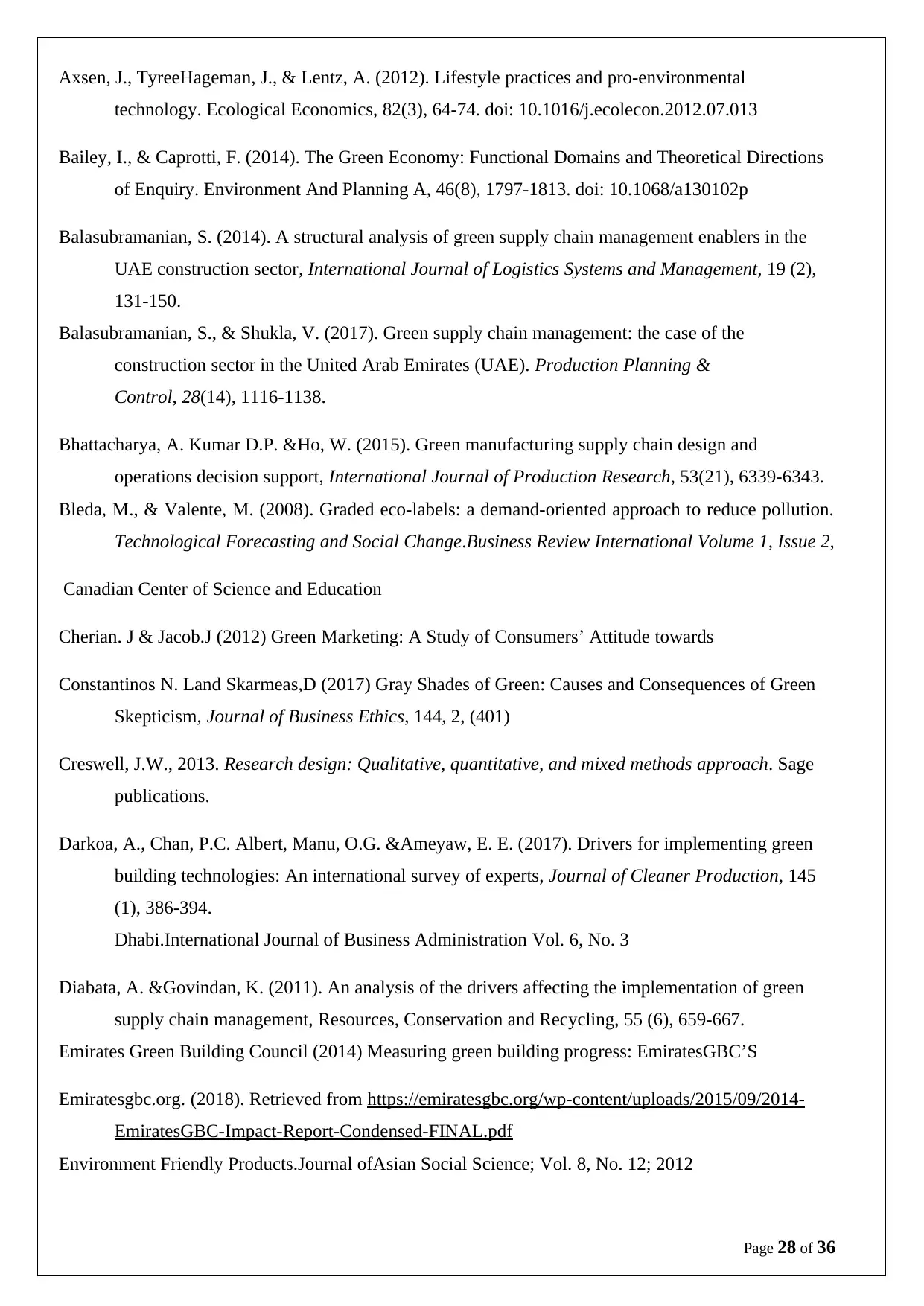
Axsen, J., TyreeHageman, J., & Lentz, A. (2012). Lifestyle practices and pro-environmental
technology. Ecological Economics, 82(3), 64-74. doi: 10.1016/j.ecolecon.2012.07.013
Bailey, I., & Caprotti, F. (2014). The Green Economy: Functional Domains and Theoretical Directions
of Enquiry. Environment And Planning A, 46(8), 1797-1813. doi: 10.1068/a130102p
Balasubramanian, S. (2014). A structural analysis of green supply chain management enablers in the
UAE construction sector, International Journal of Logistics Systems and Management, 19 (2),
131-150.
Balasubramanian, S., & Shukla, V. (2017). Green supply chain management: the case of the
construction sector in the United Arab Emirates (UAE). Production Planning &
Control, 28(14), 1116-1138.
Bhattacharya, A. Kumar D.P. &Ho, W. (2015). Green manufacturing supply chain design and
operations decision support, International Journal of Production Research, 53(21), 6339-6343.
Bleda, M., & Valente, M. (2008). Graded eco-labels: a demand-oriented approach to reduce pollution.
Technological Forecasting and Social Change.Business Review International Volume 1, Issue 2,
Canadian Center of Science and Education
Cherian. J & Jacob.J (2012) Green Marketing: A Study of Consumers’ Attitude towards
Constantinos N. Land Skarmeas,D (2017) Gray Shades of Green: Causes and Consequences of Green
Skepticism, Journal of Business Ethics, 144, 2, (401)
Creswell, J.W., 2013. Research design: Qualitative, quantitative, and mixed methods approach. Sage
publications.
Darkoa, A., Chan, P.C. Albert, Manu, O.G. &Ameyaw, E. E. (2017). Drivers for implementing green
building technologies: An international survey of experts, Journal of Cleaner Production, 145
(1), 386-394.
Dhabi.International Journal of Business Administration Vol. 6, No. 3
Diabata, A. &Govindan, K. (2011). An analysis of the drivers affecting the implementation of green
supply chain management, Resources, Conservation and Recycling, 55 (6), 659-667.
Emirates Green Building Council (2014) Measuring green building progress: EmiratesGBC’S
Emiratesgbc.org. (2018). Retrieved from https://emiratesgbc.org/wp-content/uploads/2015/09/2014-
EmiratesGBC-Impact-Report-Condensed-FINAL.pdf
Environment Friendly Products.Journal ofAsian Social Science; Vol. 8, No. 12; 2012
Page 28 of 36
technology. Ecological Economics, 82(3), 64-74. doi: 10.1016/j.ecolecon.2012.07.013
Bailey, I., & Caprotti, F. (2014). The Green Economy: Functional Domains and Theoretical Directions
of Enquiry. Environment And Planning A, 46(8), 1797-1813. doi: 10.1068/a130102p
Balasubramanian, S. (2014). A structural analysis of green supply chain management enablers in the
UAE construction sector, International Journal of Logistics Systems and Management, 19 (2),
131-150.
Balasubramanian, S., & Shukla, V. (2017). Green supply chain management: the case of the
construction sector in the United Arab Emirates (UAE). Production Planning &
Control, 28(14), 1116-1138.
Bhattacharya, A. Kumar D.P. &Ho, W. (2015). Green manufacturing supply chain design and
operations decision support, International Journal of Production Research, 53(21), 6339-6343.
Bleda, M., & Valente, M. (2008). Graded eco-labels: a demand-oriented approach to reduce pollution.
Technological Forecasting and Social Change.Business Review International Volume 1, Issue 2,
Canadian Center of Science and Education
Cherian. J & Jacob.J (2012) Green Marketing: A Study of Consumers’ Attitude towards
Constantinos N. Land Skarmeas,D (2017) Gray Shades of Green: Causes and Consequences of Green
Skepticism, Journal of Business Ethics, 144, 2, (401)
Creswell, J.W., 2013. Research design: Qualitative, quantitative, and mixed methods approach. Sage
publications.
Darkoa, A., Chan, P.C. Albert, Manu, O.G. &Ameyaw, E. E. (2017). Drivers for implementing green
building technologies: An international survey of experts, Journal of Cleaner Production, 145
(1), 386-394.
Dhabi.International Journal of Business Administration Vol. 6, No. 3
Diabata, A. &Govindan, K. (2011). An analysis of the drivers affecting the implementation of green
supply chain management, Resources, Conservation and Recycling, 55 (6), 659-667.
Emirates Green Building Council (2014) Measuring green building progress: EmiratesGBC’S
Emiratesgbc.org. (2018). Retrieved from https://emiratesgbc.org/wp-content/uploads/2015/09/2014-
EmiratesGBC-Impact-Report-Condensed-FINAL.pdf
Environment Friendly Products.Journal ofAsian Social Science; Vol. 8, No. 12; 2012
Page 28 of 36
Secure Best Marks with AI Grader
Need help grading? Try our AI Grader for instant feedback on your assignments.
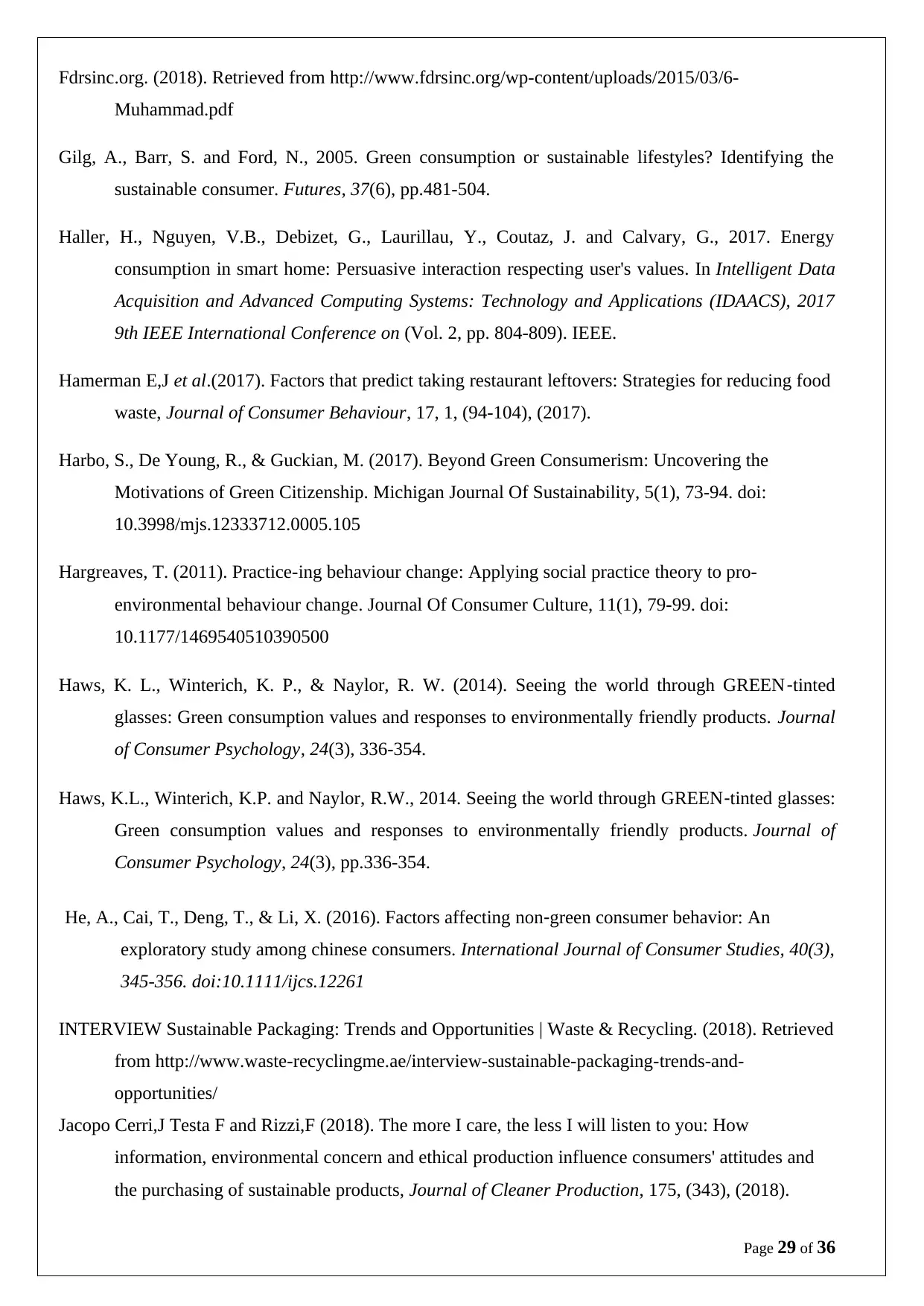
Fdrsinc.org. (2018). Retrieved from http://www.fdrsinc.org/wp-content/uploads/2015/03/6-
Muhammad.pdf
Gilg, A., Barr, S. and Ford, N., 2005. Green consumption or sustainable lifestyles? Identifying the
sustainable consumer. Futures, 37(6), pp.481-504.
Haller, H., Nguyen, V.B., Debizet, G., Laurillau, Y., Coutaz, J. and Calvary, G., 2017. Energy
consumption in smart home: Persuasive interaction respecting user's values. In Intelligent Data
Acquisition and Advanced Computing Systems: Technology and Applications (IDAACS), 2017
9th IEEE International Conference on (Vol. 2, pp. 804-809). IEEE.
Hamerman E,J et al.(2017). Factors that predict taking restaurant leftovers: Strategies for reducing food
waste, Journal of Consumer Behaviour, 17, 1, (94-104), (2017).
Harbo, S., De Young, R., & Guckian, M. (2017). Beyond Green Consumerism: Uncovering the
Motivations of Green Citizenship. Michigan Journal Of Sustainability, 5(1), 73-94. doi:
10.3998/mjs.12333712.0005.105
Hargreaves, T. (2011). Practice-ing behaviour change: Applying social practice theory to pro-
environmental behaviour change. Journal Of Consumer Culture, 11(1), 79-99. doi:
10.1177/1469540510390500
Haws, K. L., Winterich, K. P., & Naylor, R. W. (2014). Seeing the world through GREEN‐tinted
glasses: Green consumption values and responses to environmentally friendly products. Journal
of Consumer Psychology, 24(3), 336-354.
Haws, K.L., Winterich, K.P. and Naylor, R.W., 2014. Seeing the world through GREEN‐tinted glasses:
Green consumption values and responses to environmentally friendly products. Journal of
Consumer Psychology, 24(3), pp.336-354.
He, A., Cai, T., Deng, T., & Li, X. (2016). Factors affecting non‐green consumer behavior: An
exploratory study among chinese consumers. International Journal of Consumer Studies, 40(3),
345-356. doi:10.1111/ijcs.12261
INTERVIEW Sustainable Packaging: Trends and Opportunities | Waste & Recycling. (2018). Retrieved
from http://www.waste-recyclingme.ae/interview-sustainable-packaging-trends-and-
opportunities/
Jacopo Cerri,J Testa F and Rizzi,F (2018). The more I care, the less I will listen to you: How
information, environmental concern and ethical production influence consumers' attitudes and
the purchasing of sustainable products, Journal of Cleaner Production, 175, (343), (2018).
Page 29 of 36
Muhammad.pdf
Gilg, A., Barr, S. and Ford, N., 2005. Green consumption or sustainable lifestyles? Identifying the
sustainable consumer. Futures, 37(6), pp.481-504.
Haller, H., Nguyen, V.B., Debizet, G., Laurillau, Y., Coutaz, J. and Calvary, G., 2017. Energy
consumption in smart home: Persuasive interaction respecting user's values. In Intelligent Data
Acquisition and Advanced Computing Systems: Technology and Applications (IDAACS), 2017
9th IEEE International Conference on (Vol. 2, pp. 804-809). IEEE.
Hamerman E,J et al.(2017). Factors that predict taking restaurant leftovers: Strategies for reducing food
waste, Journal of Consumer Behaviour, 17, 1, (94-104), (2017).
Harbo, S., De Young, R., & Guckian, M. (2017). Beyond Green Consumerism: Uncovering the
Motivations of Green Citizenship. Michigan Journal Of Sustainability, 5(1), 73-94. doi:
10.3998/mjs.12333712.0005.105
Hargreaves, T. (2011). Practice-ing behaviour change: Applying social practice theory to pro-
environmental behaviour change. Journal Of Consumer Culture, 11(1), 79-99. doi:
10.1177/1469540510390500
Haws, K. L., Winterich, K. P., & Naylor, R. W. (2014). Seeing the world through GREEN‐tinted
glasses: Green consumption values and responses to environmentally friendly products. Journal
of Consumer Psychology, 24(3), 336-354.
Haws, K.L., Winterich, K.P. and Naylor, R.W., 2014. Seeing the world through GREEN‐tinted glasses:
Green consumption values and responses to environmentally friendly products. Journal of
Consumer Psychology, 24(3), pp.336-354.
He, A., Cai, T., Deng, T., & Li, X. (2016). Factors affecting non‐green consumer behavior: An
exploratory study among chinese consumers. International Journal of Consumer Studies, 40(3),
345-356. doi:10.1111/ijcs.12261
INTERVIEW Sustainable Packaging: Trends and Opportunities | Waste & Recycling. (2018). Retrieved
from http://www.waste-recyclingme.ae/interview-sustainable-packaging-trends-and-
opportunities/
Jacopo Cerri,J Testa F and Rizzi,F (2018). The more I care, the less I will listen to you: How
information, environmental concern and ethical production influence consumers' attitudes and
the purchasing of sustainable products, Journal of Cleaner Production, 175, (343), (2018).
Page 29 of 36

Kaya, O. and Duman, F., 2017. Green Consumption: A Study to Understand Consumers' Organic Food
Consumption. In Green Marketing and Environmental Responsibility in Modern
Corporations (pp. 42-67). IGI Global.
Kirmani. D,H &Khan. N.V (2016). Green Consumerism:A Review of Extant Literature, Pacific
Knussen, C., Yule, F., MacKenzie, J. and Wells, M., 2004. An analysis of intentions to recycle
household waste: The roles of past behaviour, perceived habit, and perceived lack of
facilities. Journal of environmental psychology, 24(2), pp.237-246.
Kollmuss, A. and Agyeman, J., 2002. Mind the gap: why do people act environmentally and what are
the barriers to pro-environmental behaviour? Environmental education research, 8(3), pp.239-
260.
Mainieri, T., Barnett, E.G., Valdero, T.R., Unipan, J.B. and Oskamp, S., 1997. Green buying: The
influence of environmental concern on consumer behaviour. The Journal of social
psychology, 137(2), pp.189-204.
Mokri, A., Ali, M.A. and Emziane, M., 2013. Solar energy in the United Arab Emirates: A
review. Renewable and Sustainable energy reviews, 28, pp.340-375.
Mousavi,S Roper, S and Kathleen A.(2017). Keeling, Interpreting Social Identity in Online Brand
Communities: Considering Posters and Lurkers, Psychology & Marketing, 34, 4, (376-393),
Murray, C. K. (2013). What if consumers decided to all ‘go green’? Environmental rebound effects
from consumption decisions. Energy Policy, 54, 240-256.
Nabin, B and Rabotyagov,S.(2017). How much are wood-based cellulosic biofuels worth in the Pacific
Northwest? Ex-ante and ex-post analysis of local people's willingness to pay, Forest Policy and
Economics, 83, (99), .
Nada Al Taher, S. (2018). UAE’s most major environmental challenges addressed. Retrieved from
https://gulfnews.com/news/uae/environment/uae-s-most-major-environmental-challenges-
addressed-1.1198279
Nanath, K. &Pillai, R., R. (2017). The Influence of Green IS Practices on Competitive Advantage:
Mediation Role of Green Innovation Performance, Journal Information Systems Management,
34 (1), 128-145.
Obery ,A and Bangert,A.(2017). Exploring the Influence of Nature Relatedness and Perceived Science
Knowledge on Proenvironmental Behavior, Education Sciences, 7, 4, (17),
Panneerselvam, R., 2014. Research methodology. PHI Learning Pvt. Ltd
Page 30 of 36
Consumption. In Green Marketing and Environmental Responsibility in Modern
Corporations (pp. 42-67). IGI Global.
Kirmani. D,H &Khan. N.V (2016). Green Consumerism:A Review of Extant Literature, Pacific
Knussen, C., Yule, F., MacKenzie, J. and Wells, M., 2004. An analysis of intentions to recycle
household waste: The roles of past behaviour, perceived habit, and perceived lack of
facilities. Journal of environmental psychology, 24(2), pp.237-246.
Kollmuss, A. and Agyeman, J., 2002. Mind the gap: why do people act environmentally and what are
the barriers to pro-environmental behaviour? Environmental education research, 8(3), pp.239-
260.
Mainieri, T., Barnett, E.G., Valdero, T.R., Unipan, J.B. and Oskamp, S., 1997. Green buying: The
influence of environmental concern on consumer behaviour. The Journal of social
psychology, 137(2), pp.189-204.
Mokri, A., Ali, M.A. and Emziane, M., 2013. Solar energy in the United Arab Emirates: A
review. Renewable and Sustainable energy reviews, 28, pp.340-375.
Mousavi,S Roper, S and Kathleen A.(2017). Keeling, Interpreting Social Identity in Online Brand
Communities: Considering Posters and Lurkers, Psychology & Marketing, 34, 4, (376-393),
Murray, C. K. (2013). What if consumers decided to all ‘go green’? Environmental rebound effects
from consumption decisions. Energy Policy, 54, 240-256.
Nabin, B and Rabotyagov,S.(2017). How much are wood-based cellulosic biofuels worth in the Pacific
Northwest? Ex-ante and ex-post analysis of local people's willingness to pay, Forest Policy and
Economics, 83, (99), .
Nada Al Taher, S. (2018). UAE’s most major environmental challenges addressed. Retrieved from
https://gulfnews.com/news/uae/environment/uae-s-most-major-environmental-challenges-
addressed-1.1198279
Nanath, K. &Pillai, R., R. (2017). The Influence of Green IS Practices on Competitive Advantage:
Mediation Role of Green Innovation Performance, Journal Information Systems Management,
34 (1), 128-145.
Obery ,A and Bangert,A.(2017). Exploring the Influence of Nature Relatedness and Perceived Science
Knowledge on Proenvironmental Behavior, Education Sciences, 7, 4, (17),
Panneerselvam, R., 2014. Research methodology. PHI Learning Pvt. Ltd
Page 30 of 36
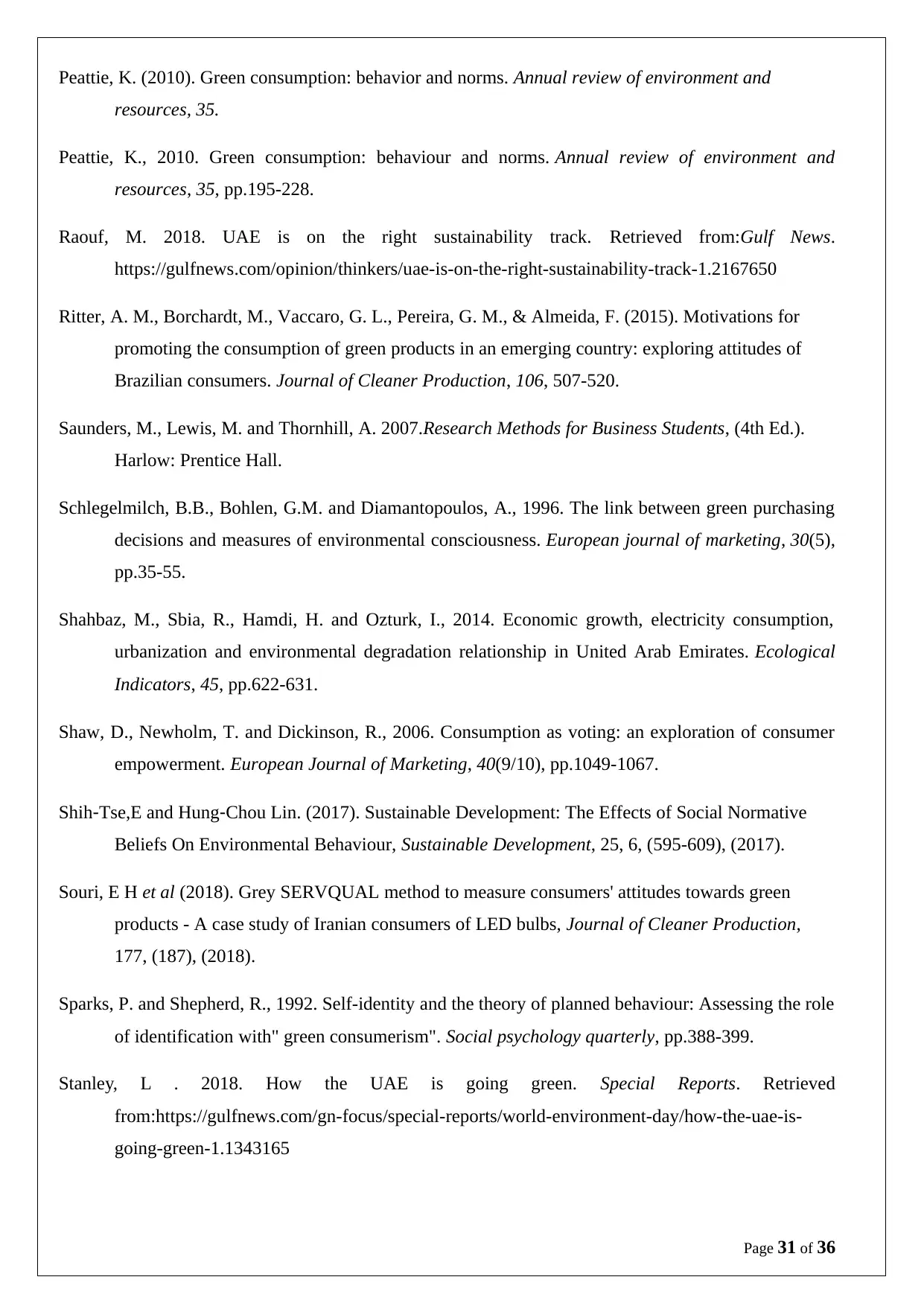
Peattie, K. (2010). Green consumption: behavior and norms. Annual review of environment and
resources, 35.
Peattie, K., 2010. Green consumption: behaviour and norms. Annual review of environment and
resources, 35, pp.195-228.
Raouf, M. 2018. UAE is on the right sustainability track. Retrieved from:Gulf News.
https://gulfnews.com/opinion/thinkers/uae-is-on-the-right-sustainability-track-1.2167650
Ritter, A. M., Borchardt, M., Vaccaro, G. L., Pereira, G. M., & Almeida, F. (2015). Motivations for
promoting the consumption of green products in an emerging country: exploring attitudes of
Brazilian consumers. Journal of Cleaner Production, 106, 507-520.
Saunders, M., Lewis, M. and Thornhill, A. 2007.Research Methods for Business Students, (4th Ed.).
Harlow: Prentice Hall.
Schlegelmilch, B.B., Bohlen, G.M. and Diamantopoulos, A., 1996. The link between green purchasing
decisions and measures of environmental consciousness. European journal of marketing, 30(5),
pp.35-55.
Shahbaz, M., Sbia, R., Hamdi, H. and Ozturk, I., 2014. Economic growth, electricity consumption,
urbanization and environmental degradation relationship in United Arab Emirates. Ecological
Indicators, 45, pp.622-631.
Shaw, D., Newholm, T. and Dickinson, R., 2006. Consumption as voting: an exploration of consumer
empowerment. European Journal of Marketing, 40(9/10), pp.1049-1067.
Shih‐Tse,E and Hung‐Chou Lin. (2017). Sustainable Development: The Effects of Social Normative
Beliefs On Environmental Behaviour, Sustainable Development, 25, 6, (595-609), (2017).
Souri, E H et al (2018). Grey SERVQUAL method to measure consumers' attitudes towards green
products - A case study of Iranian consumers of LED bulbs, Journal of Cleaner Production,
177, (187), (2018).
Sparks, P. and Shepherd, R., 1992. Self-identity and the theory of planned behaviour: Assessing the role
of identification with" green consumerism". Social psychology quarterly, pp.388-399.
Stanley, L . 2018. How the UAE is going green. Special Reports. Retrieved
from:https://gulfnews.com/gn-focus/special-reports/world-environment-day/how-the-uae-is-
going-green-1.1343165
Page 31 of 36
resources, 35.
Peattie, K., 2010. Green consumption: behaviour and norms. Annual review of environment and
resources, 35, pp.195-228.
Raouf, M. 2018. UAE is on the right sustainability track. Retrieved from:Gulf News.
https://gulfnews.com/opinion/thinkers/uae-is-on-the-right-sustainability-track-1.2167650
Ritter, A. M., Borchardt, M., Vaccaro, G. L., Pereira, G. M., & Almeida, F. (2015). Motivations for
promoting the consumption of green products in an emerging country: exploring attitudes of
Brazilian consumers. Journal of Cleaner Production, 106, 507-520.
Saunders, M., Lewis, M. and Thornhill, A. 2007.Research Methods for Business Students, (4th Ed.).
Harlow: Prentice Hall.
Schlegelmilch, B.B., Bohlen, G.M. and Diamantopoulos, A., 1996. The link between green purchasing
decisions and measures of environmental consciousness. European journal of marketing, 30(5),
pp.35-55.
Shahbaz, M., Sbia, R., Hamdi, H. and Ozturk, I., 2014. Economic growth, electricity consumption,
urbanization and environmental degradation relationship in United Arab Emirates. Ecological
Indicators, 45, pp.622-631.
Shaw, D., Newholm, T. and Dickinson, R., 2006. Consumption as voting: an exploration of consumer
empowerment. European Journal of Marketing, 40(9/10), pp.1049-1067.
Shih‐Tse,E and Hung‐Chou Lin. (2017). Sustainable Development: The Effects of Social Normative
Beliefs On Environmental Behaviour, Sustainable Development, 25, 6, (595-609), (2017).
Souri, E H et al (2018). Grey SERVQUAL method to measure consumers' attitudes towards green
products - A case study of Iranian consumers of LED bulbs, Journal of Cleaner Production,
177, (187), (2018).
Sparks, P. and Shepherd, R., 1992. Self-identity and the theory of planned behaviour: Assessing the role
of identification with" green consumerism". Social psychology quarterly, pp.388-399.
Stanley, L . 2018. How the UAE is going green. Special Reports. Retrieved
from:https://gulfnews.com/gn-focus/special-reports/world-environment-day/how-the-uae-is-
going-green-1.1343165
Page 31 of 36
Paraphrase This Document
Need a fresh take? Get an instant paraphrase of this document with our AI Paraphraser
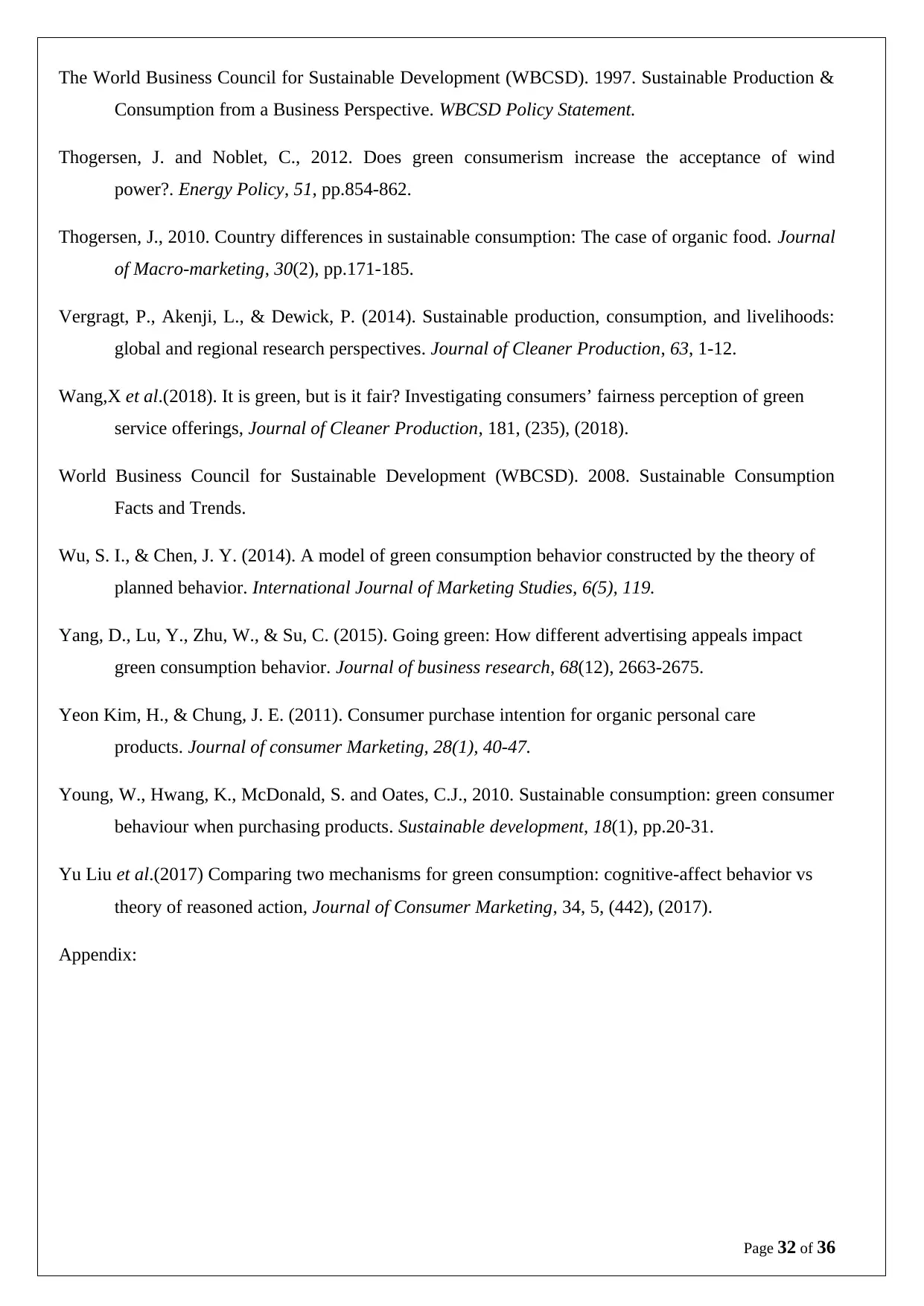
The World Business Council for Sustainable Development (WBCSD). 1997. Sustainable Production &
Consumption from a Business Perspective. WBCSD Policy Statement.
Thogersen, J. and Noblet, C., 2012. Does green consumerism increase the acceptance of wind
power?. Energy Policy, 51, pp.854-862.
Thogersen, J., 2010. Country differences in sustainable consumption: The case of organic food. Journal
of Macro-marketing, 30(2), pp.171-185.
Vergragt, P., Akenji, L., & Dewick, P. (2014). Sustainable production, consumption, and livelihoods:
global and regional research perspectives. Journal of Cleaner Production, 63, 1-12.
Wang,X et al.(2018). It is green, but is it fair? Investigating consumers’ fairness perception of green
service offerings, Journal of Cleaner Production, 181, (235), (2018).
World Business Council for Sustainable Development (WBCSD). 2008. Sustainable Consumption
Facts and Trends.
Wu, S. I., & Chen, J. Y. (2014). A model of green consumption behavior constructed by the theory of
planned behavior. International Journal of Marketing Studies, 6(5), 119.
Yang, D., Lu, Y., Zhu, W., & Su, C. (2015). Going green: How different advertising appeals impact
green consumption behavior. Journal of business research, 68(12), 2663-2675.
Yeon Kim, H., & Chung, J. E. (2011). Consumer purchase intention for organic personal care
products. Journal of consumer Marketing, 28(1), 40-47.
Young, W., Hwang, K., McDonald, S. and Oates, C.J., 2010. Sustainable consumption: green consumer
behaviour when purchasing products. Sustainable development, 18(1), pp.20-31.
Yu Liu et al.(2017) Comparing two mechanisms for green consumption: cognitive-affect behavior vs
theory of reasoned action, Journal of Consumer Marketing, 34, 5, (442), (2017).
Appendix:
Page 32 of 36
Consumption from a Business Perspective. WBCSD Policy Statement.
Thogersen, J. and Noblet, C., 2012. Does green consumerism increase the acceptance of wind
power?. Energy Policy, 51, pp.854-862.
Thogersen, J., 2010. Country differences in sustainable consumption: The case of organic food. Journal
of Macro-marketing, 30(2), pp.171-185.
Vergragt, P., Akenji, L., & Dewick, P. (2014). Sustainable production, consumption, and livelihoods:
global and regional research perspectives. Journal of Cleaner Production, 63, 1-12.
Wang,X et al.(2018). It is green, but is it fair? Investigating consumers’ fairness perception of green
service offerings, Journal of Cleaner Production, 181, (235), (2018).
World Business Council for Sustainable Development (WBCSD). 2008. Sustainable Consumption
Facts and Trends.
Wu, S. I., & Chen, J. Y. (2014). A model of green consumption behavior constructed by the theory of
planned behavior. International Journal of Marketing Studies, 6(5), 119.
Yang, D., Lu, Y., Zhu, W., & Su, C. (2015). Going green: How different advertising appeals impact
green consumption behavior. Journal of business research, 68(12), 2663-2675.
Yeon Kim, H., & Chung, J. E. (2011). Consumer purchase intention for organic personal care
products. Journal of consumer Marketing, 28(1), 40-47.
Young, W., Hwang, K., McDonald, S. and Oates, C.J., 2010. Sustainable consumption: green consumer
behaviour when purchasing products. Sustainable development, 18(1), pp.20-31.
Yu Liu et al.(2017) Comparing two mechanisms for green consumption: cognitive-affect behavior vs
theory of reasoned action, Journal of Consumer Marketing, 34, 5, (442), (2017).
Appendix:
Page 32 of 36
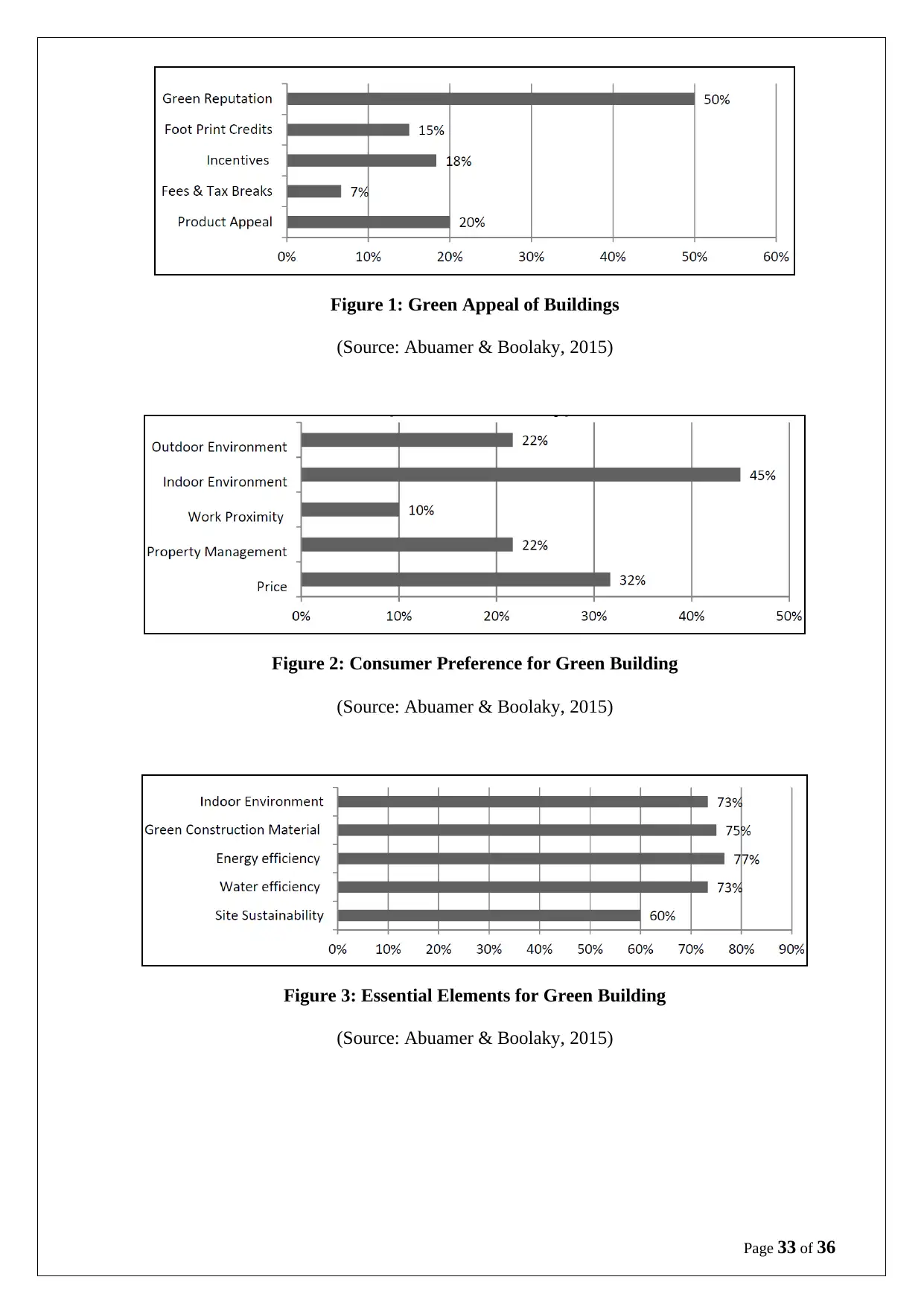
Figure 1: Green Appeal of Buildings
(Source: Abuamer & Boolaky, 2015)
Figure 2: Consumer Preference for Green Building
(Source: Abuamer & Boolaky, 2015)
Figure 3: Essential Elements for Green Building
(Source: Abuamer & Boolaky, 2015)
Page 33 of 36
(Source: Abuamer & Boolaky, 2015)
Figure 2: Consumer Preference for Green Building
(Source: Abuamer & Boolaky, 2015)
Figure 3: Essential Elements for Green Building
(Source: Abuamer & Boolaky, 2015)
Page 33 of 36

Figure 4: Green Buildings Enhance Economic Growth
(Source: Abuamer & Boolaky, 2015)
Figure 5: Preferred Marketing Tool to Consumers for Green Buildings
(Source: Abuamer & Boolaky, 2015)
Figure 6: Length of Interest in Organic Food
Page 34 of 36
(Source: Abuamer & Boolaky, 2015)
Figure 5: Preferred Marketing Tool to Consumers for Green Buildings
(Source: Abuamer & Boolaky, 2015)
Figure 6: Length of Interest in Organic Food
Page 34 of 36
Secure Best Marks with AI Grader
Need help grading? Try our AI Grader for instant feedback on your assignments.
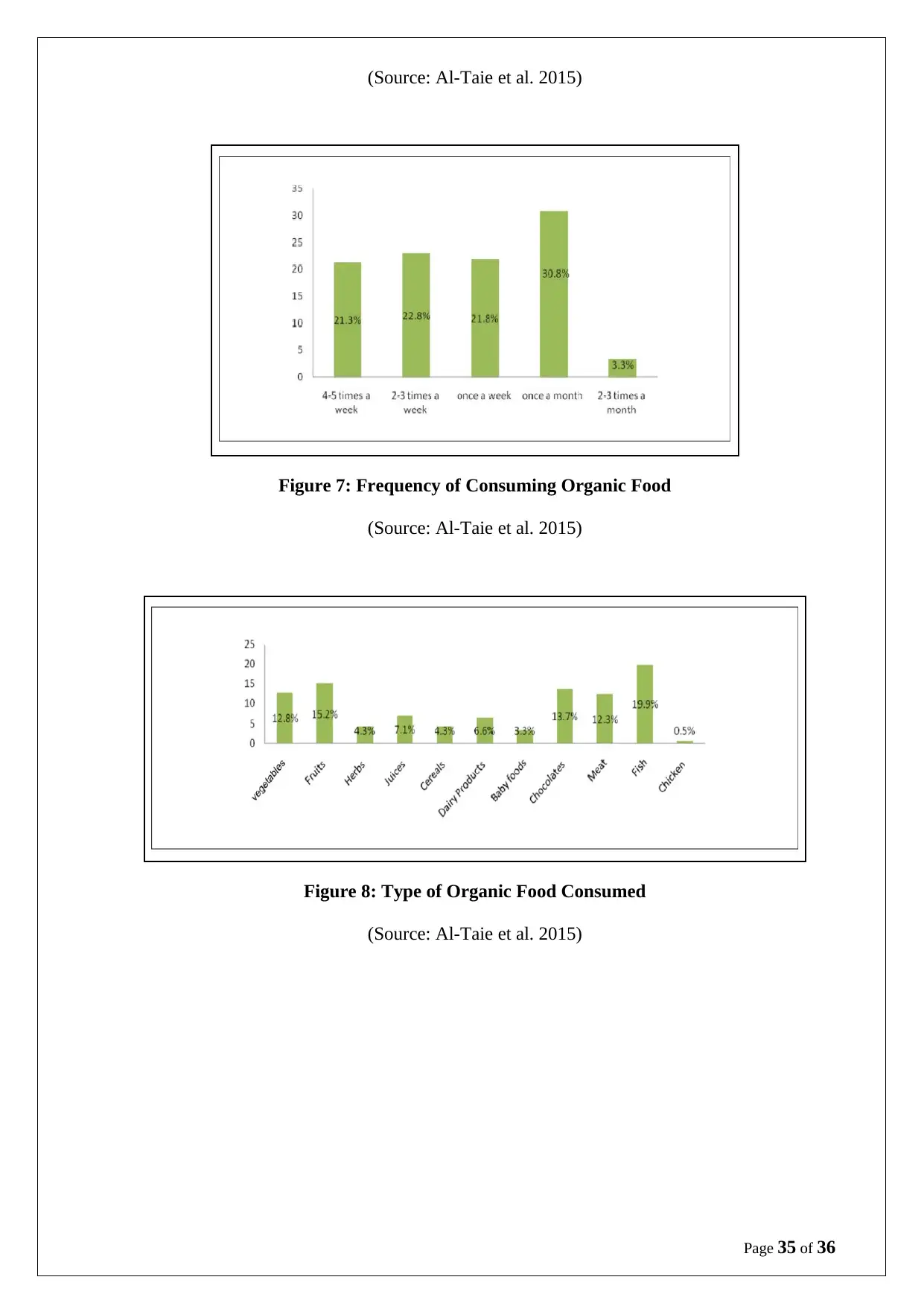
(Source: Al-Taie et al. 2015)
Figure 7: Frequency of Consuming Organic Food
(Source: Al-Taie et al. 2015)
Figure 8: Type of Organic Food Consumed
(Source: Al-Taie et al. 2015)
Page 35 of 36
Figure 7: Frequency of Consuming Organic Food
(Source: Al-Taie et al. 2015)
Figure 8: Type of Organic Food Consumed
(Source: Al-Taie et al. 2015)
Page 35 of 36
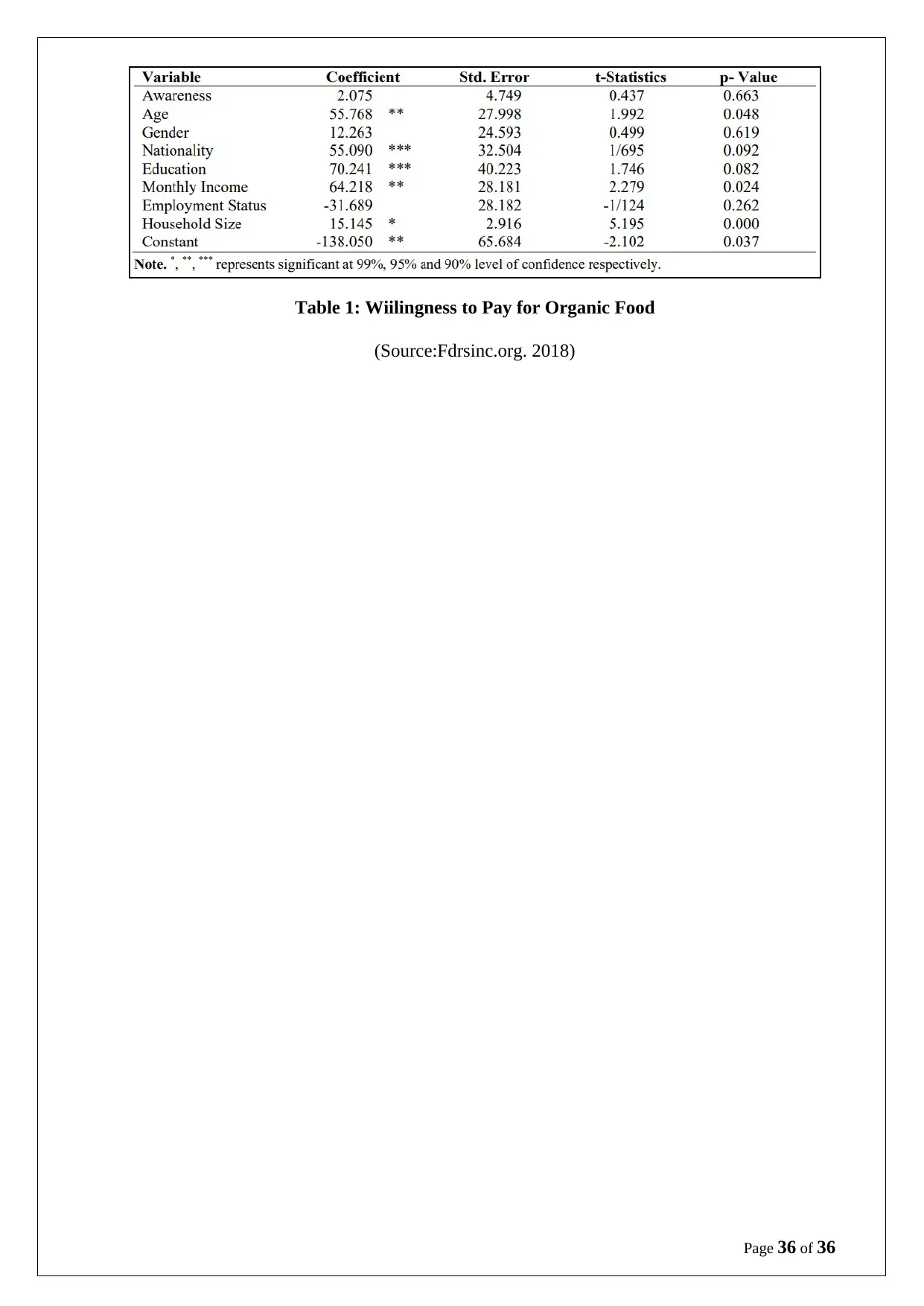
Table 1: Wiilingness to Pay for Organic Food
(Source:Fdrsinc.org. 2018)
Page 36 of 36
(Source:Fdrsinc.org. 2018)
Page 36 of 36
1 out of 36
Related Documents
Your All-in-One AI-Powered Toolkit for Academic Success.
+13062052269
info@desklib.com
Available 24*7 on WhatsApp / Email
![[object Object]](/_next/static/media/star-bottom.7253800d.svg)
Unlock your academic potential
© 2024 | Zucol Services PVT LTD | All rights reserved.





